Need help? Call us at +91 8977724840 or request a call back from our health advisor
Book Lab Tests
Explore our top booked tests and popular health checkup packages.
Browse by Lab Test Categories

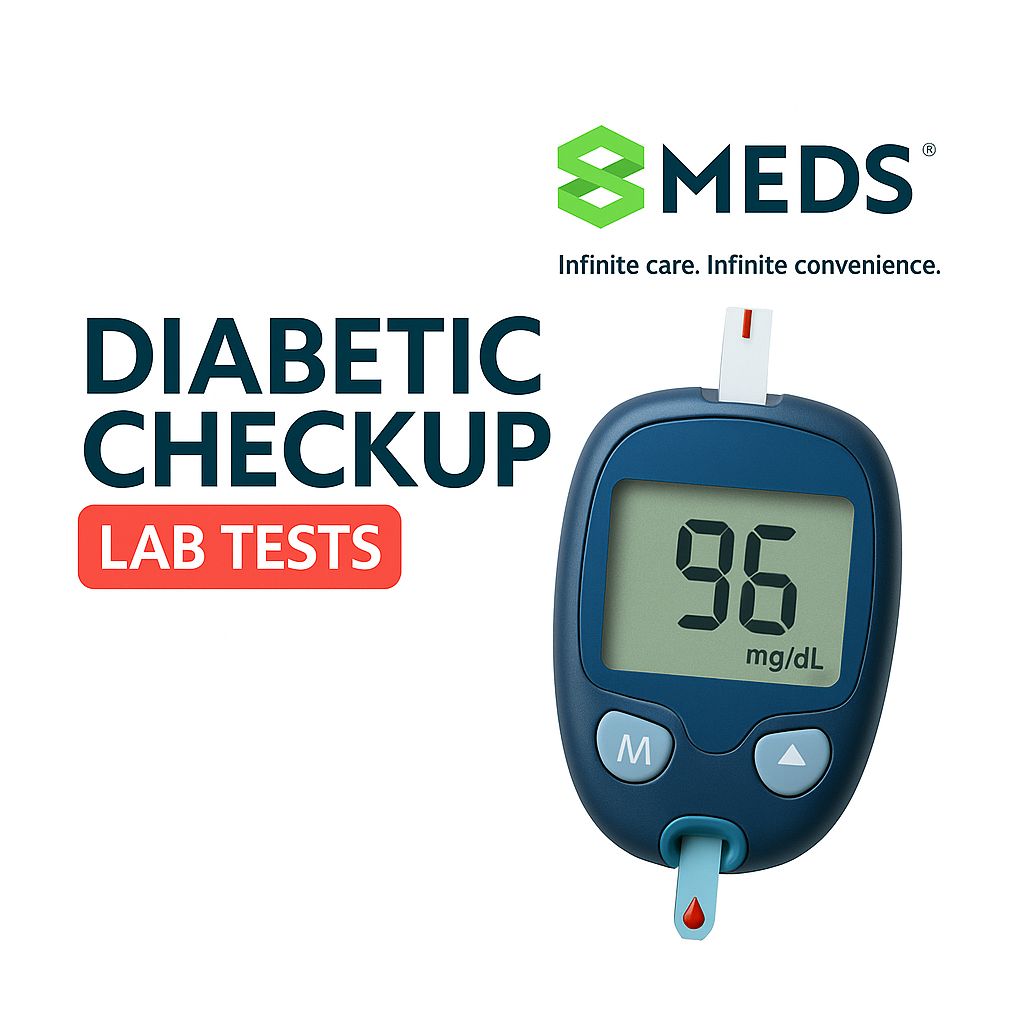

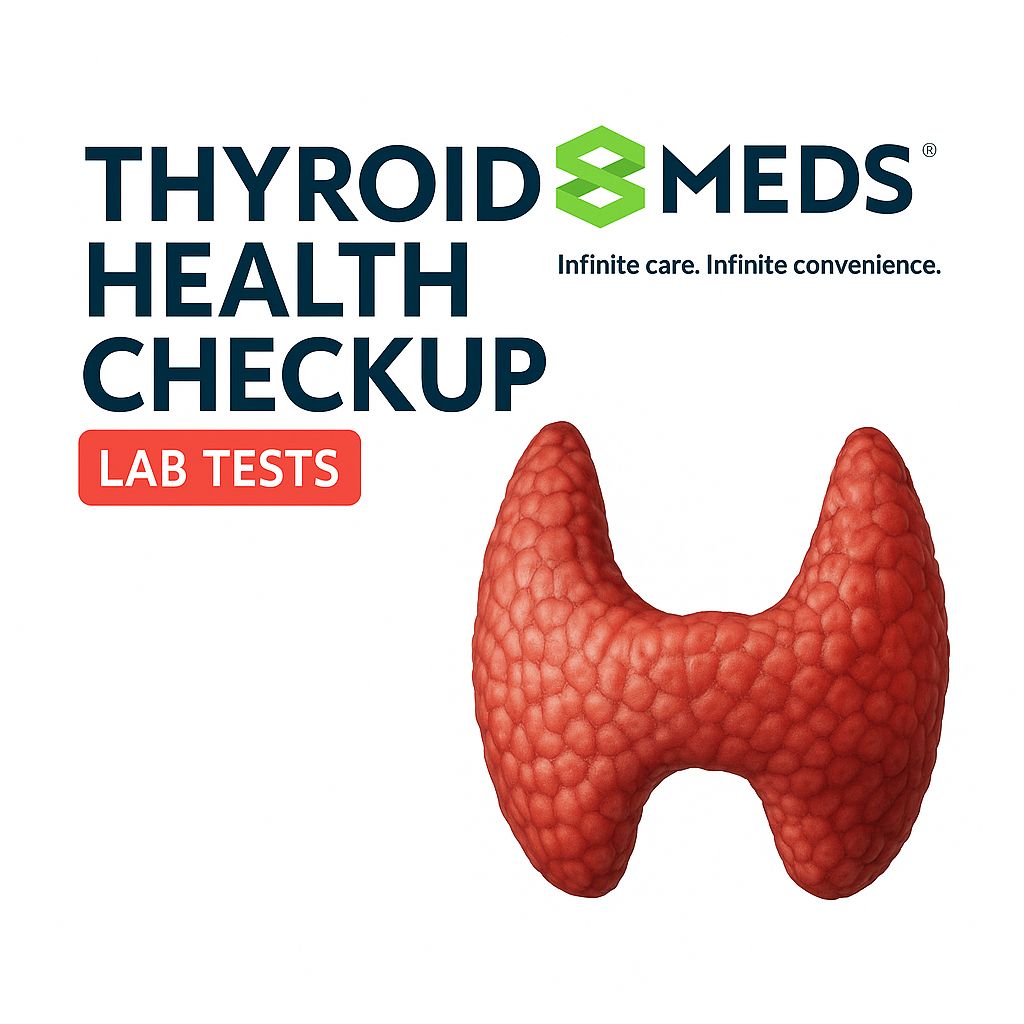
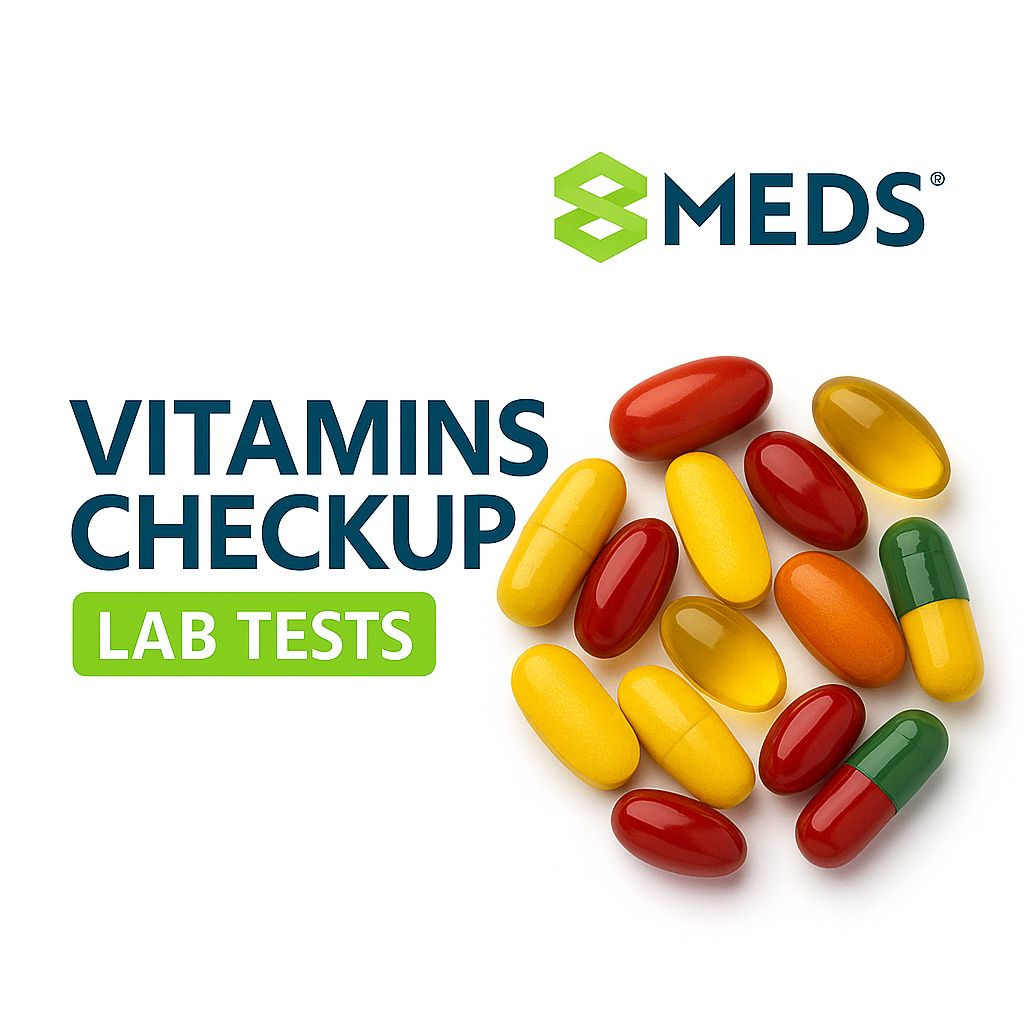
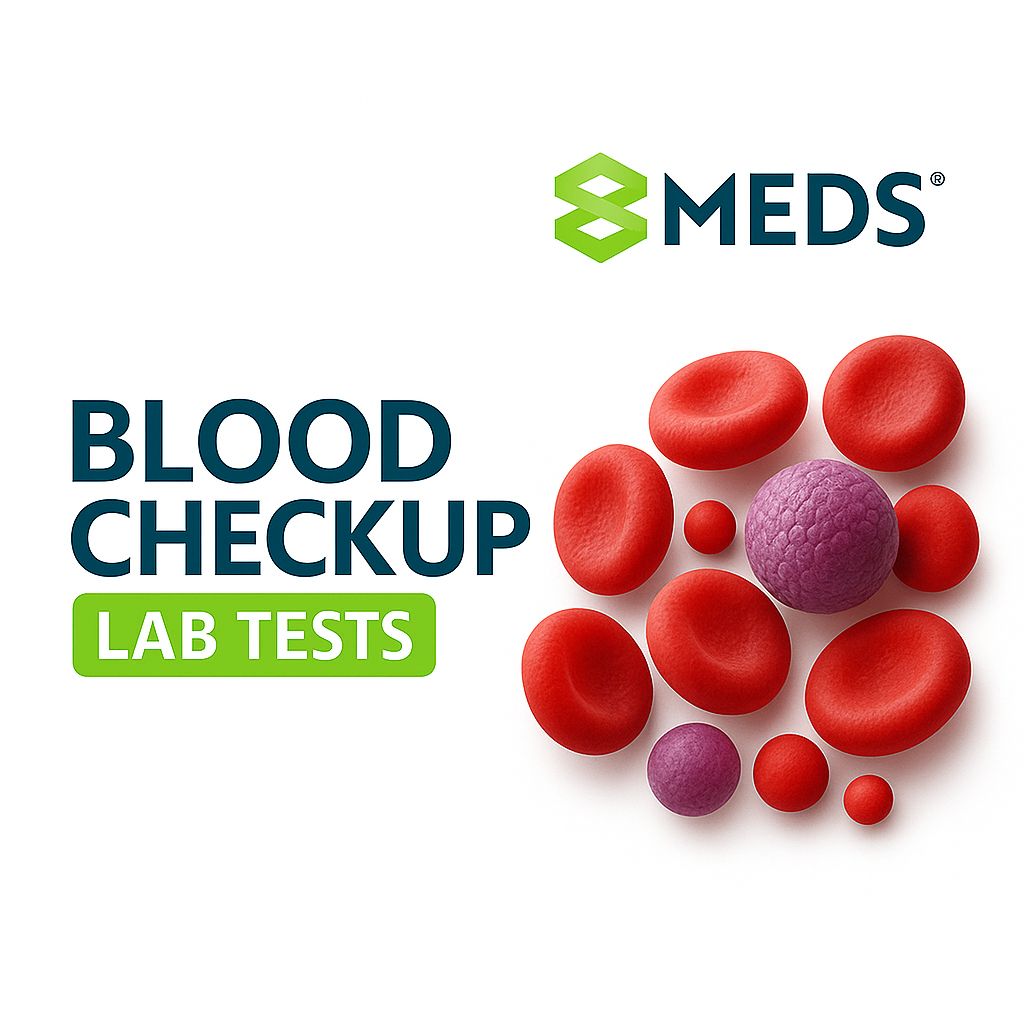
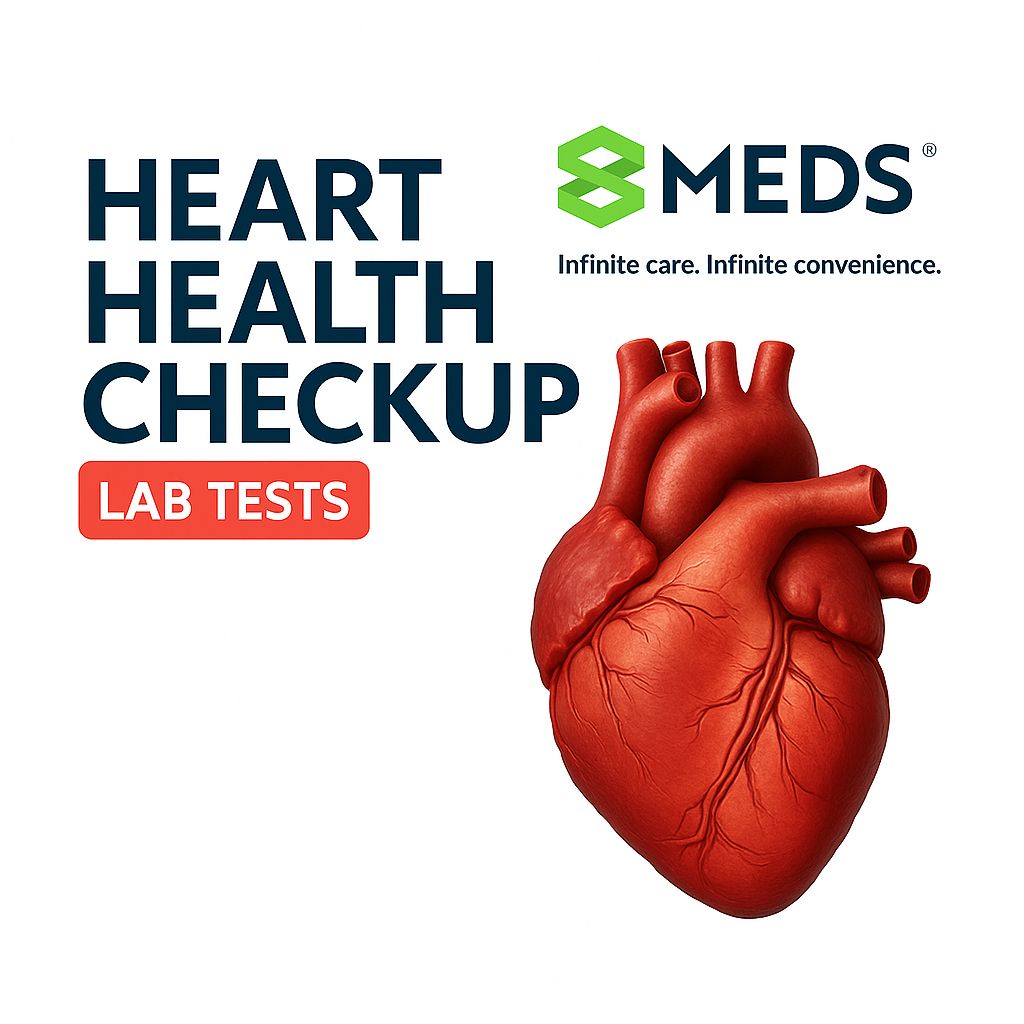
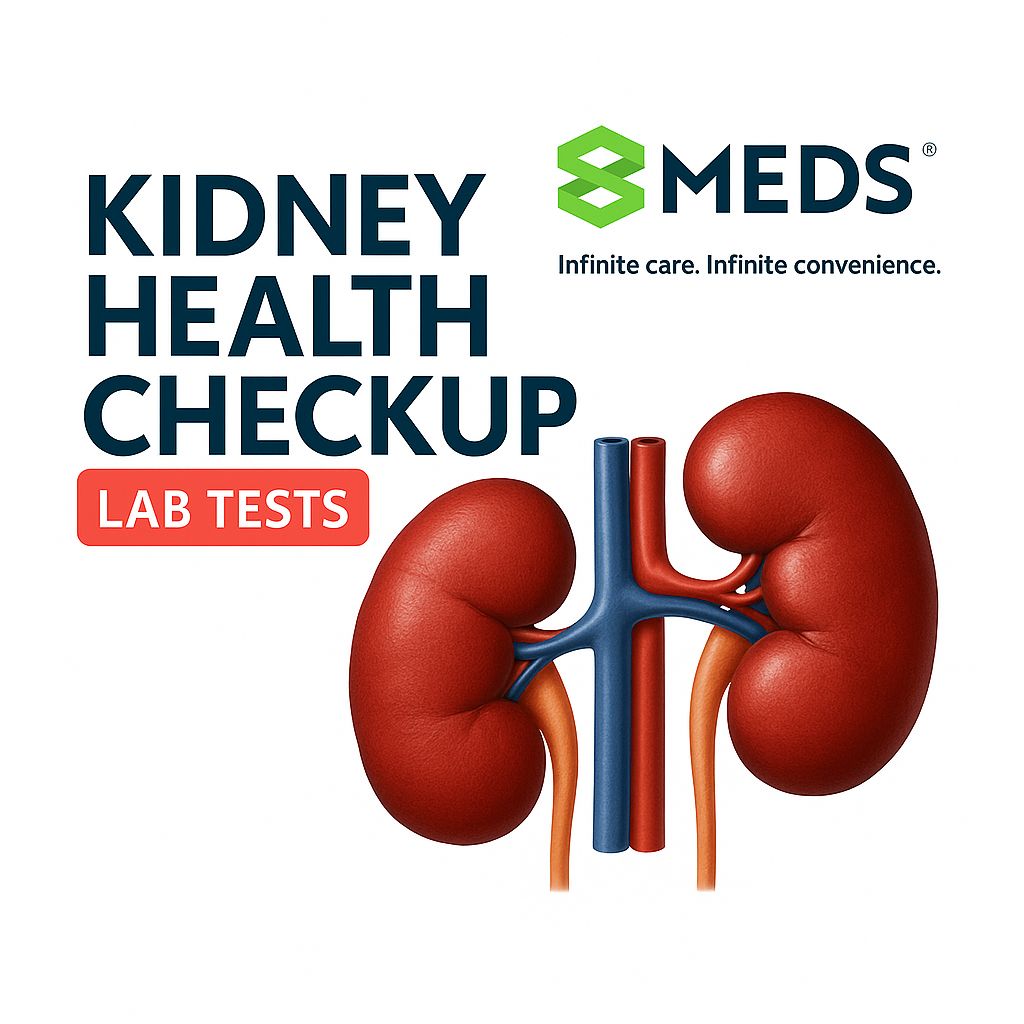
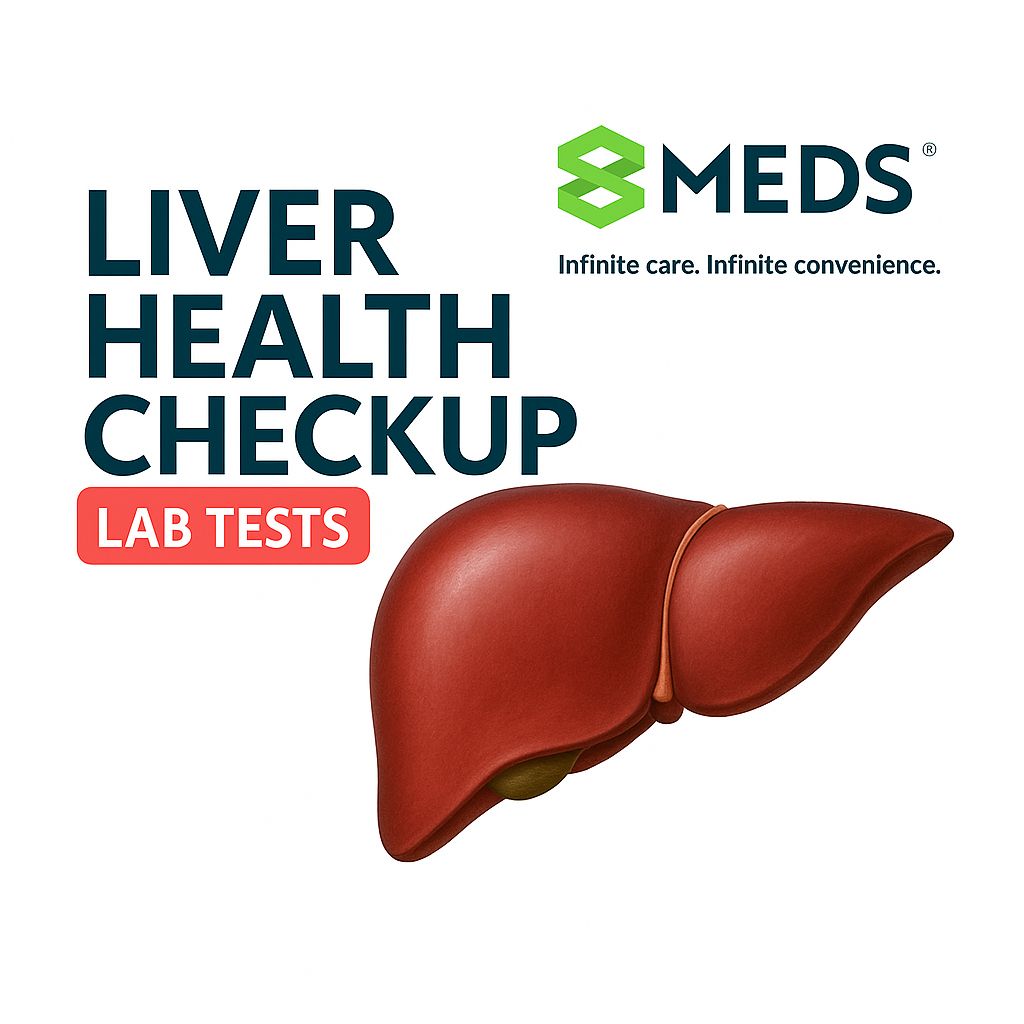

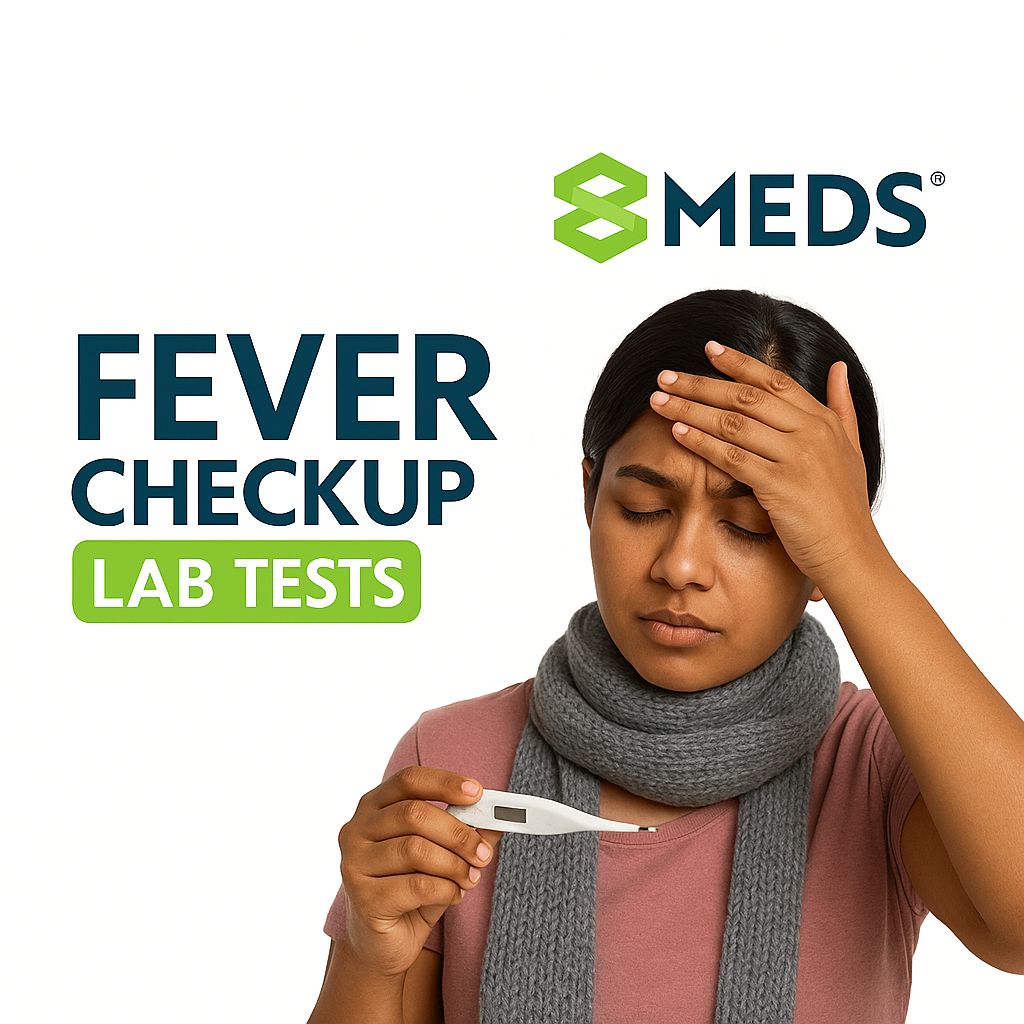

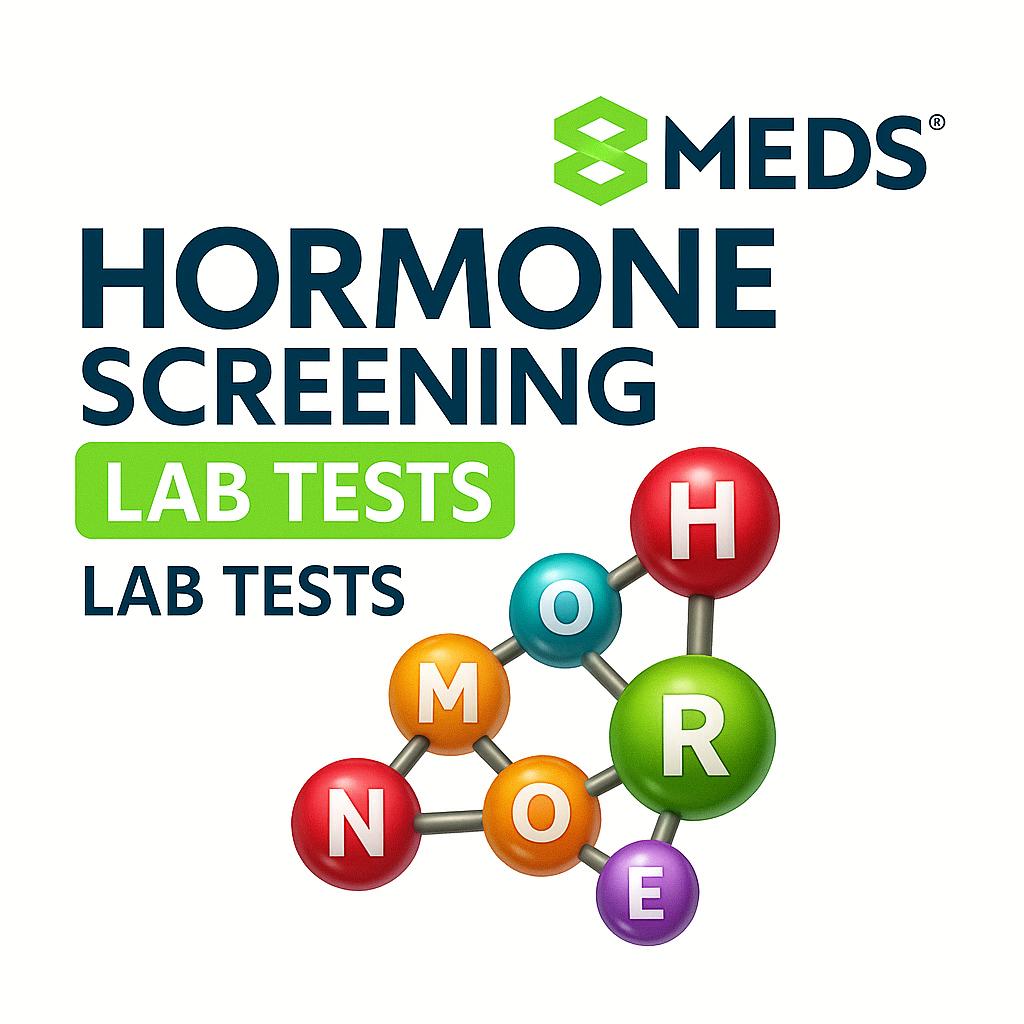
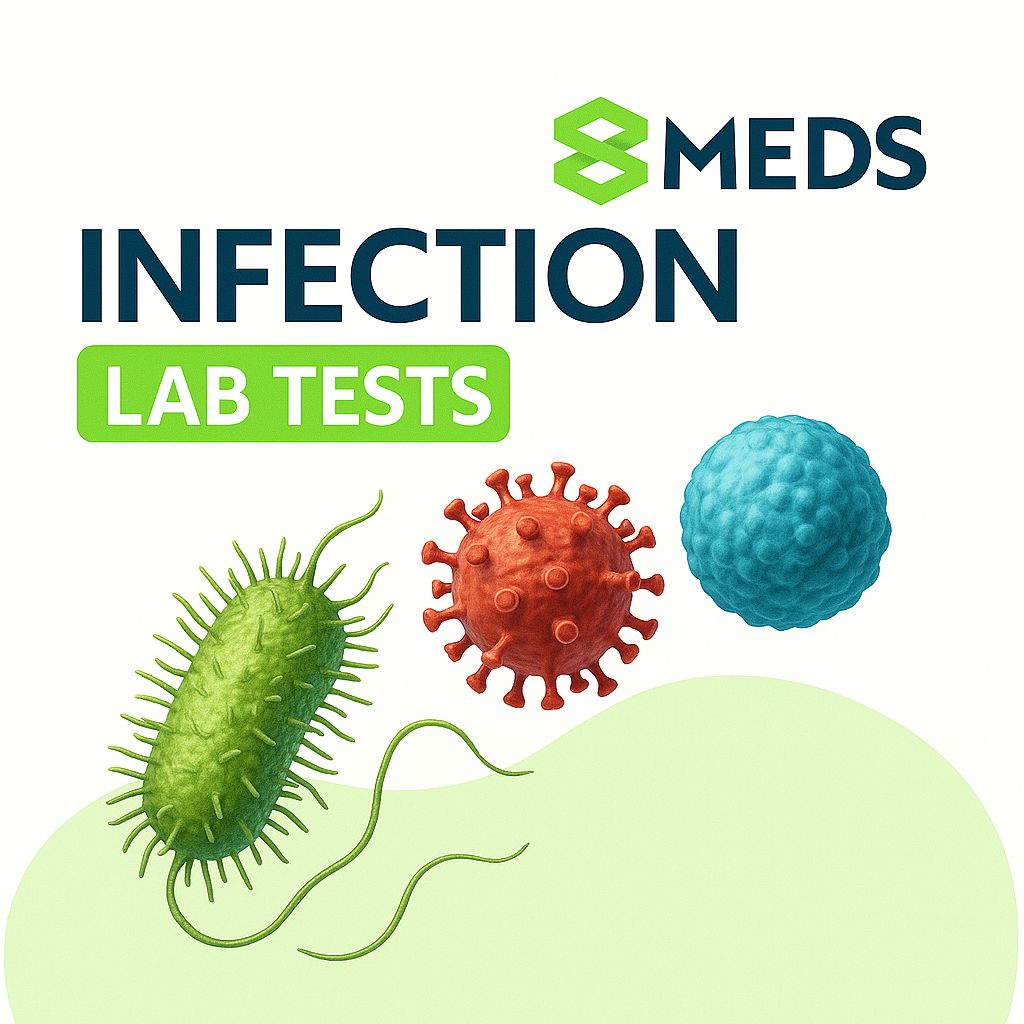


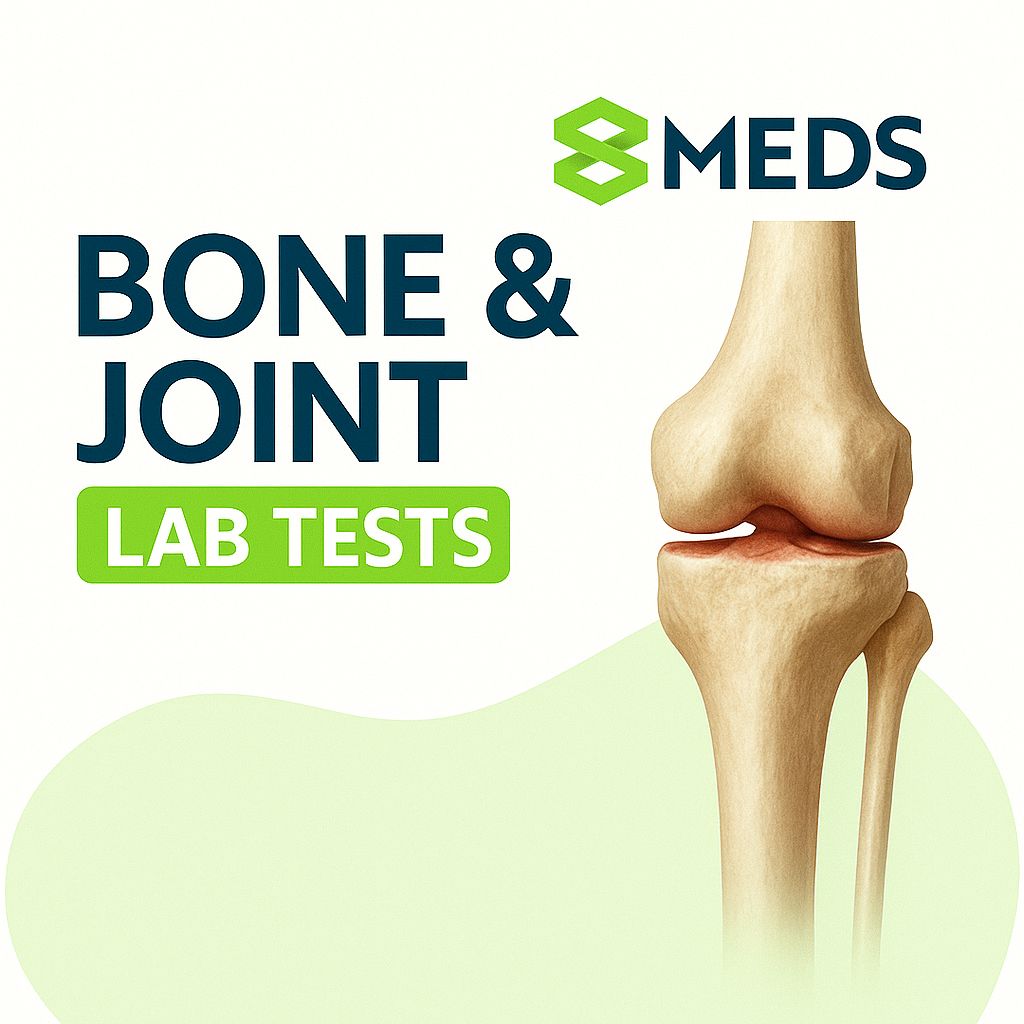
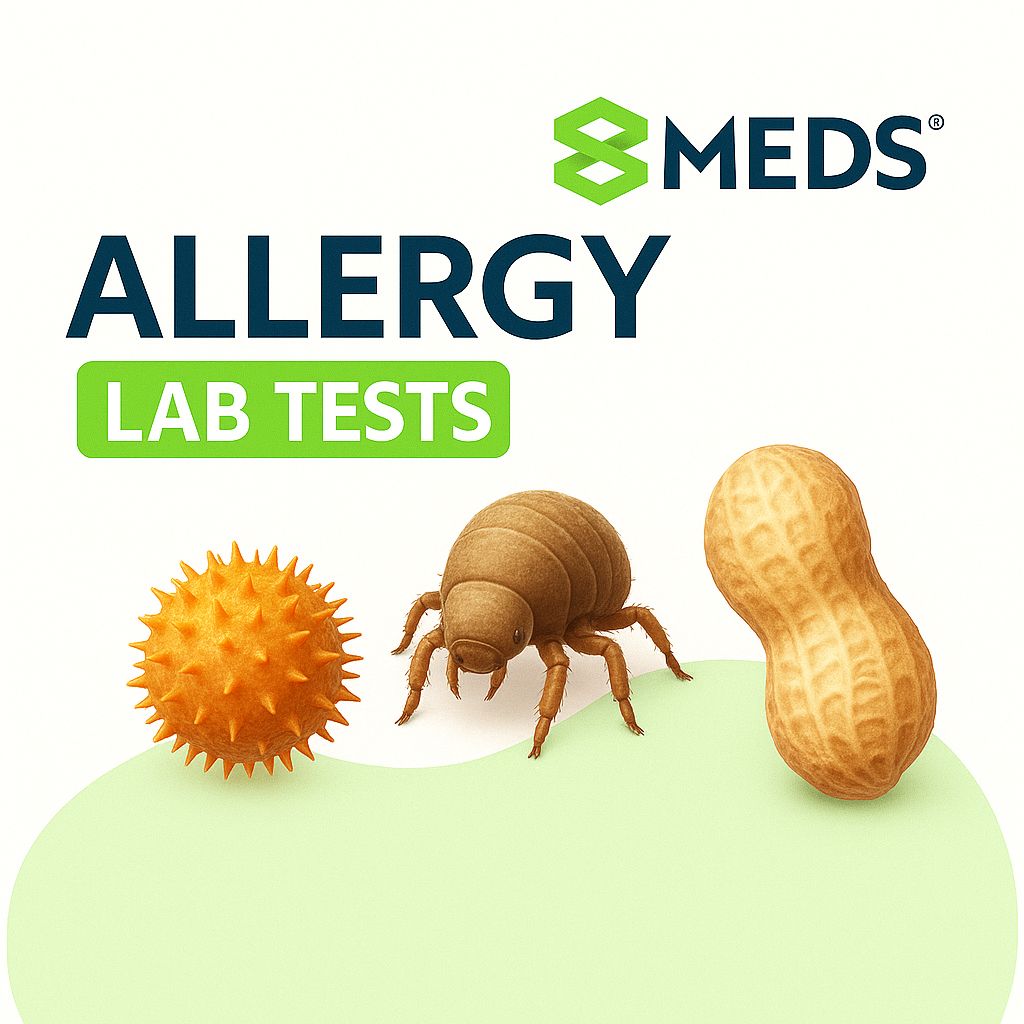
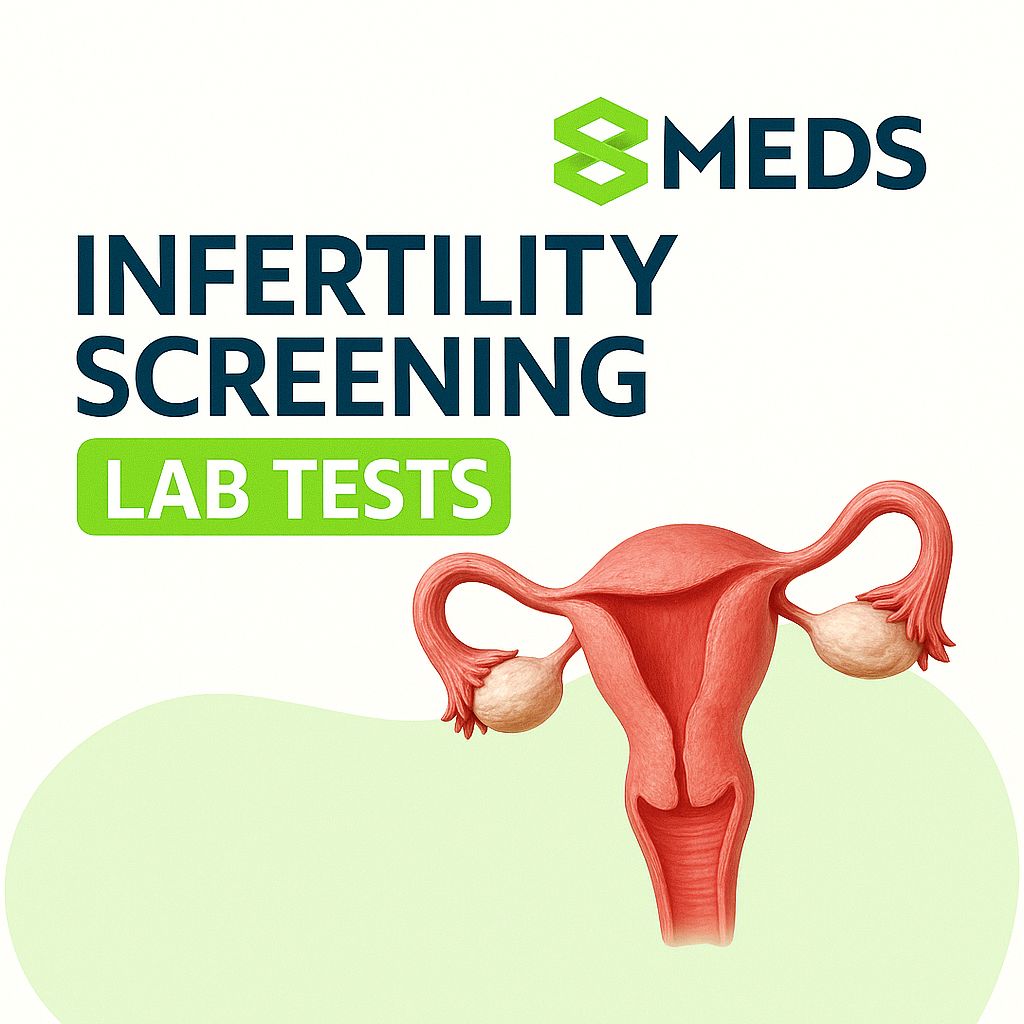
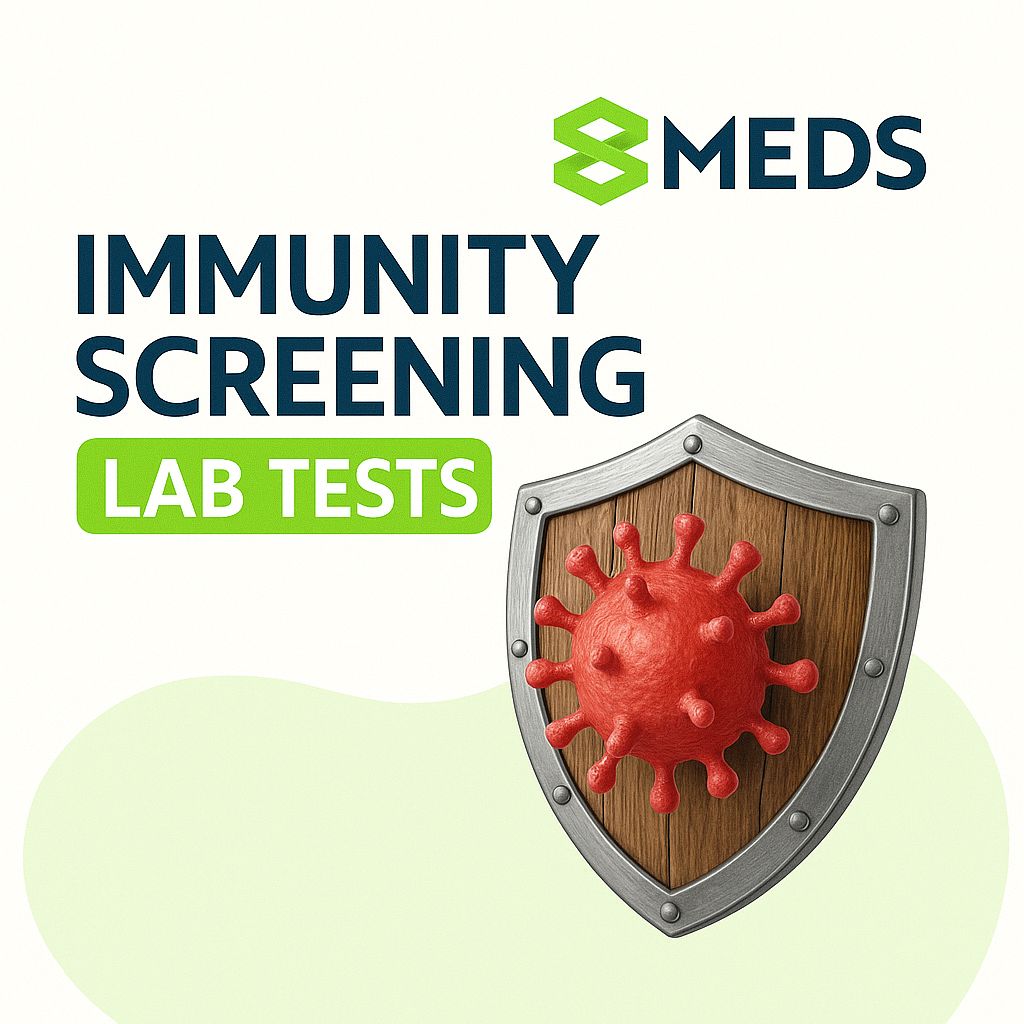

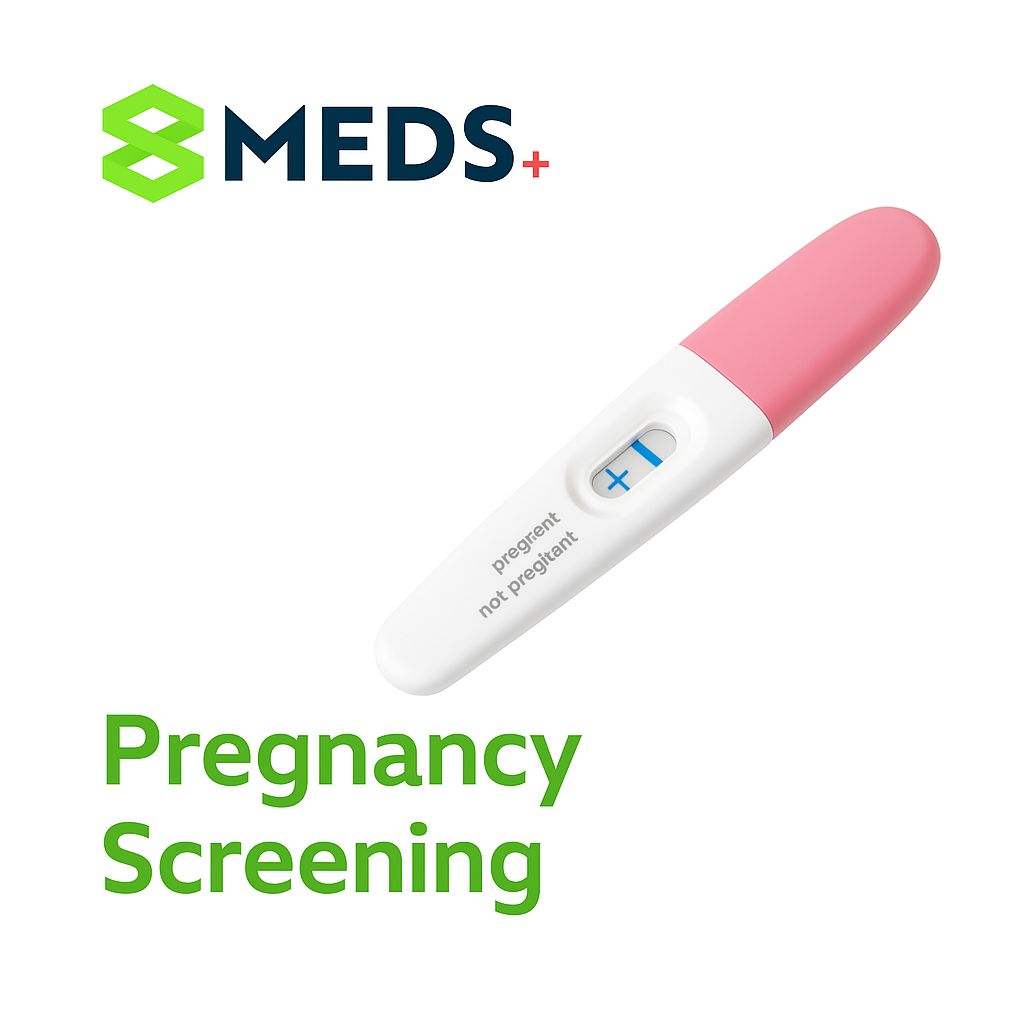
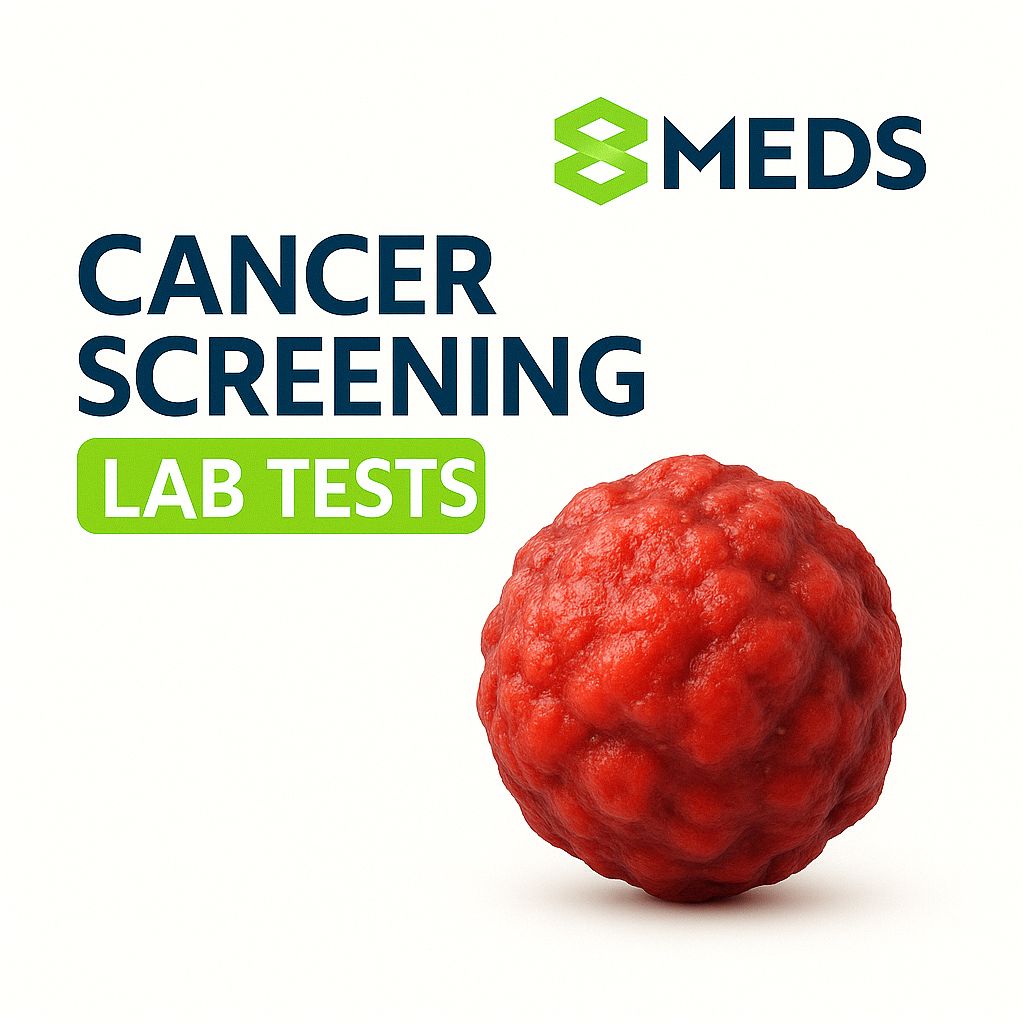
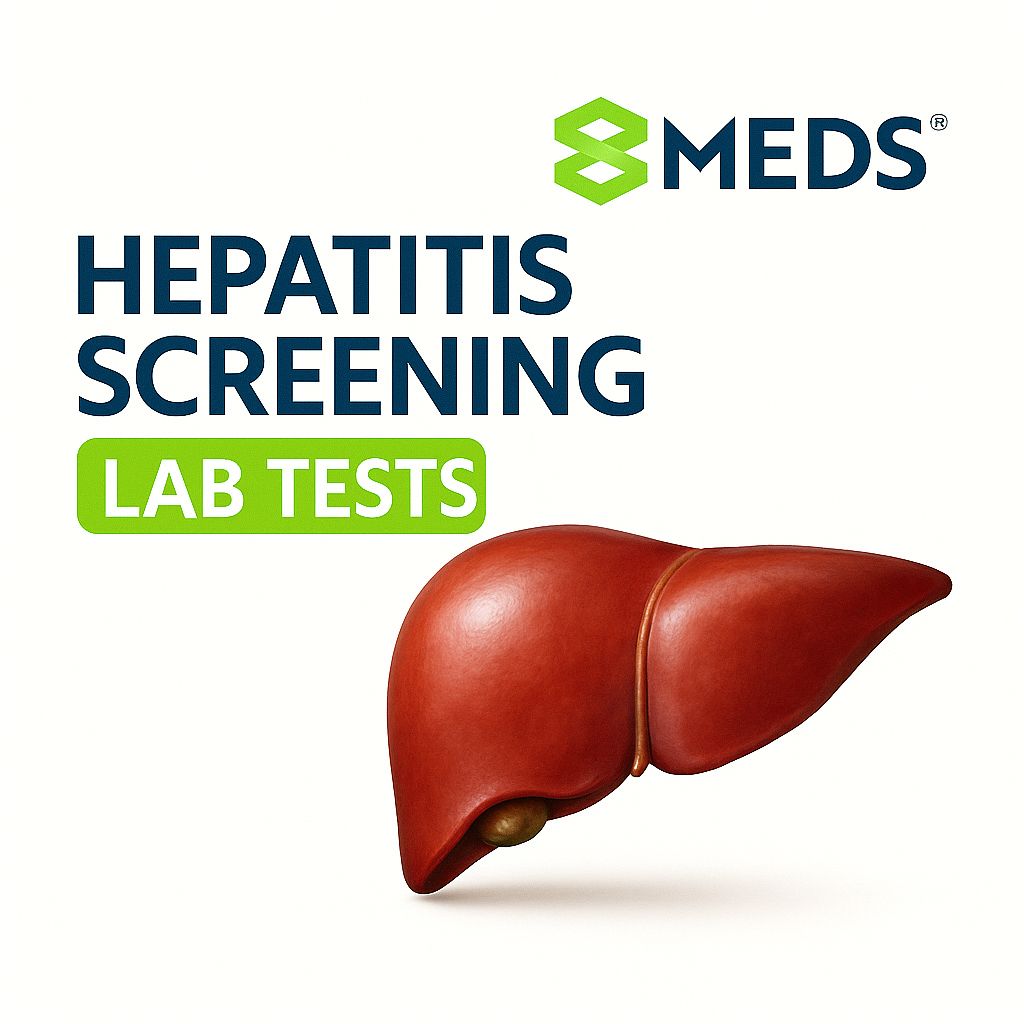
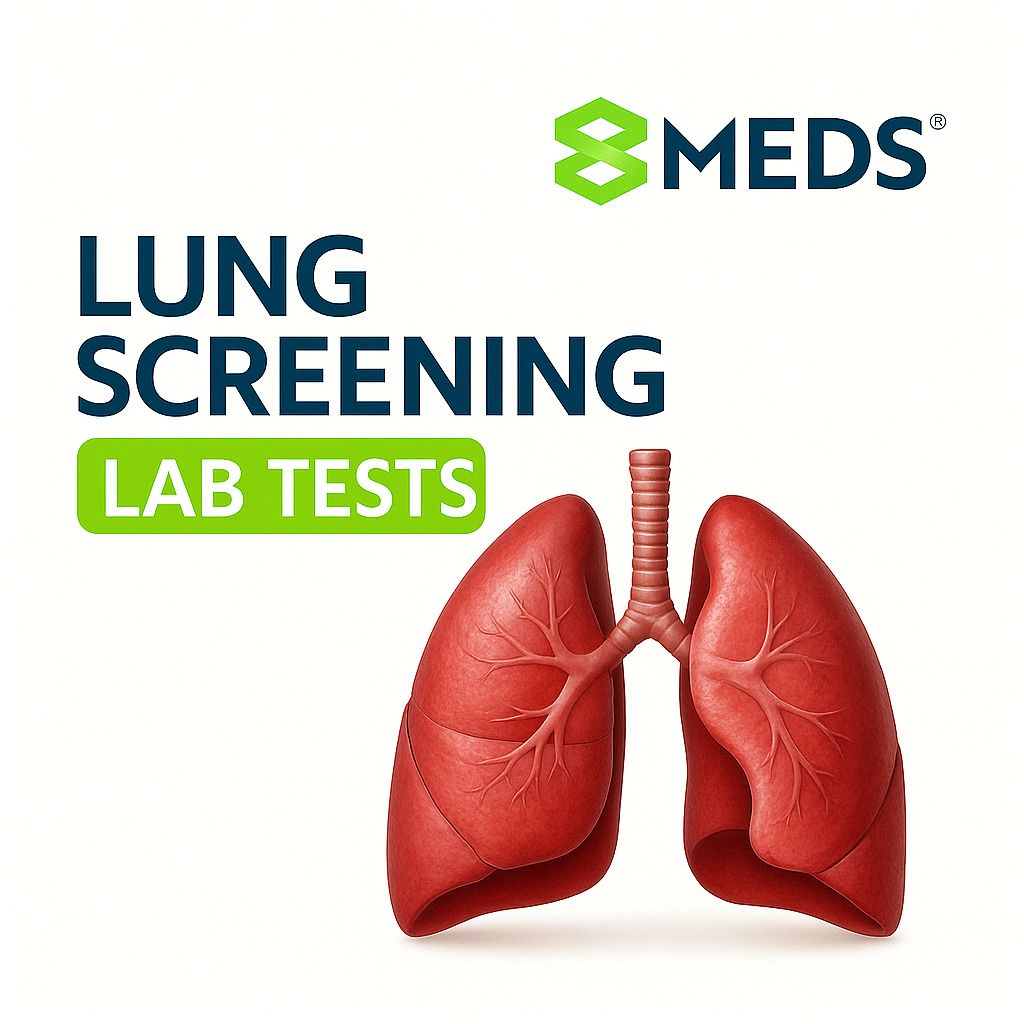
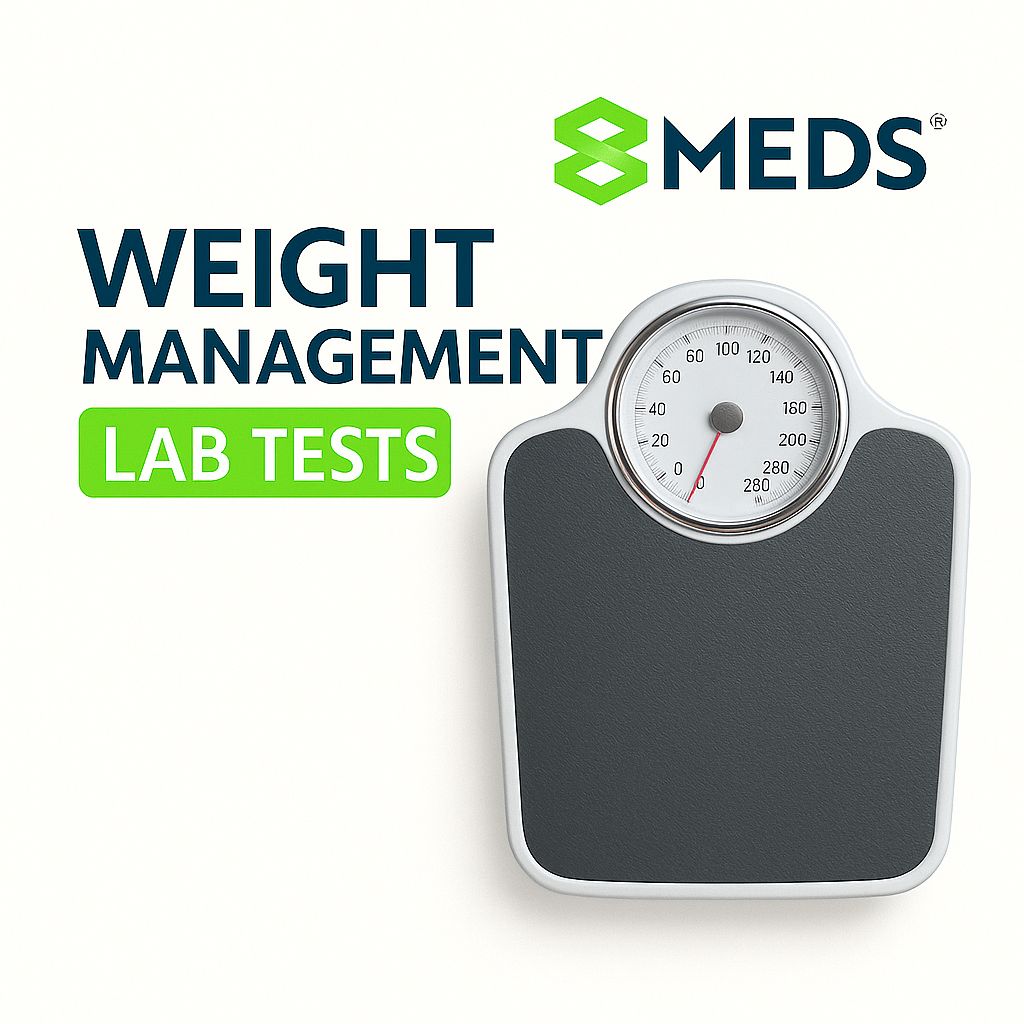
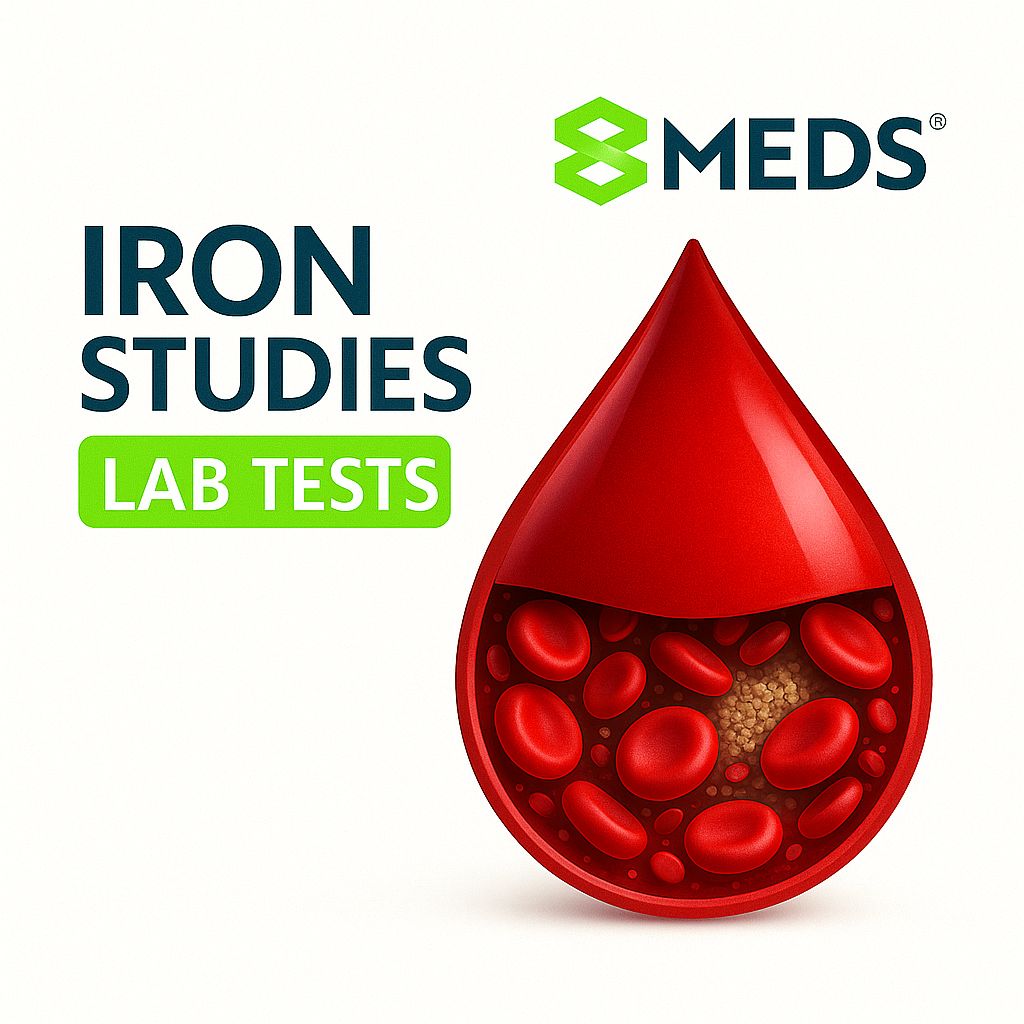
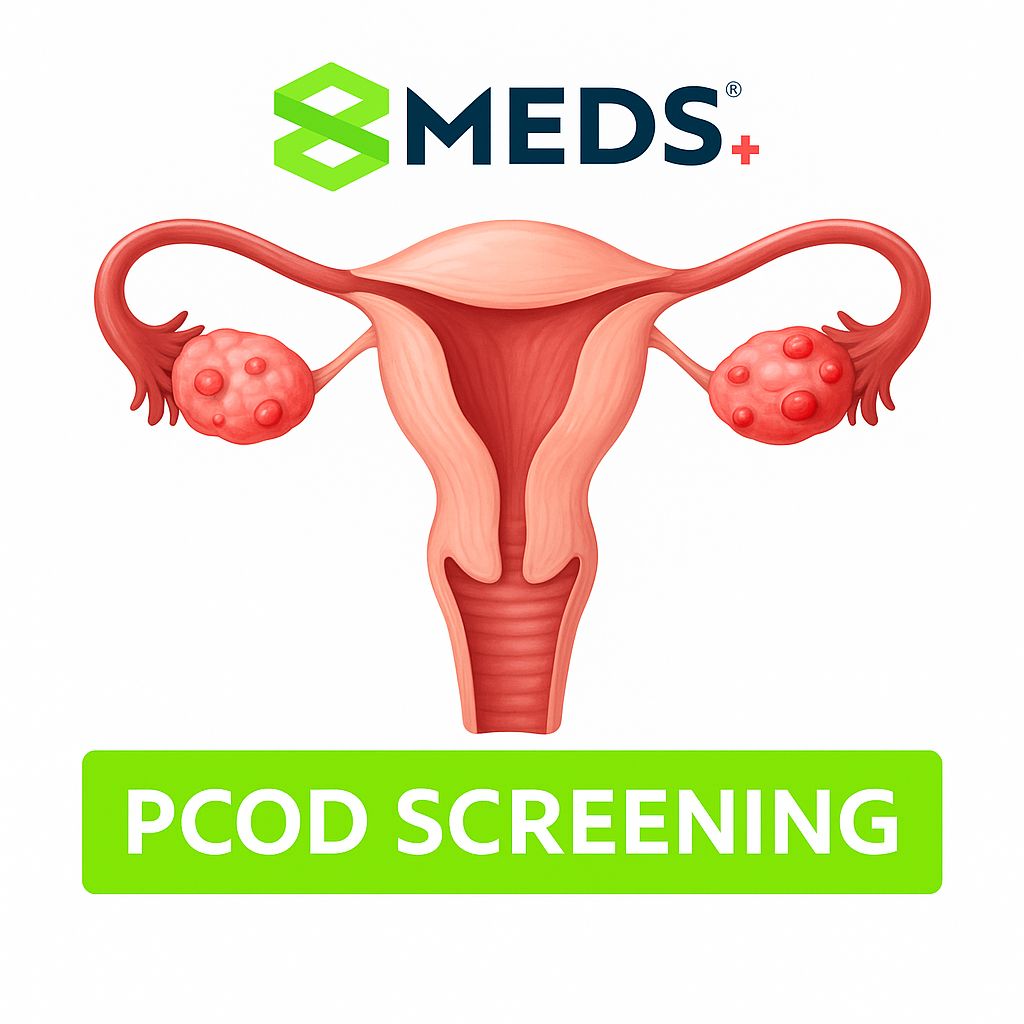


Popular Health Checkup Packages (94)
8MEDS POLLUTION CHECK PACKAGE - BASIC
₹1500
₹4289
8MEDS CANCER CHECKUP - ESSENTIAL ( MALE)
₹4
₹3500
8MEDS NUTRITION DEFICIENCY CHECKUP - BASIC
₹2200
₹2100
5% Off8MEDS NUTRITION DEFICIENCY CHECKUP - ESSENTIAL
₹7000
₹2600
63% Off8MEDS ANTENATAL PANEL - COMPREHENSIVE (FIRST TRIMESTER)
₹5000
₹2800
44% Off8MEDS STRESS IMPACT CHECKUP - FEMALE
₹5900
₹2900
51% Off8MEDS ANTENATAL PANEL - BASIC (FIRST TRIMESTER)
₹372
₹2000
8MEDS STRESS IMPACT CHECKUP - MALE
₹5900
₹2900
51% Off8MEDS FATIGUE MOPNITORING PACKAGE
₹2600
₹1250
52% Off8MEDS POSTPATUM HEALTH CHECKUP
₹4800
₹2800
42% Off8MEDS THALASSEMIA SCREENING CHECKUP
₹1700
₹1400
18% Off8MEDS CANCER CHECKUP - BASIC (FEMALE)
₹1402
₹2500
8MEDS VIRAL FLU PANEL (QUALITATIVE ) ( RT-PCR)
₹6
₹3000
8MEDS ANTENATAL PANEL - ADVANCE (FIRST TRIMESTER)
₹5872
₹4800
18% Off8MEDS ARTHRITIS PANEL - ESSENTIAL
₹8900
₹3500
61% Off8MEDS SENIOR CITIZEN HEALTH CHECKUP - ESSENTIAL
₹10000
₹4000
60% Off8MEDS SENIOR CITIZEN HEALTH CHECKUP - ADVANCE (FEMALE)
₹13000
₹5700
56% Off8MEDS FULL BODY CHECKUP - ADVANCE (FEMALE)
₹5170
₹5800
8MEDS HAIRFALL CHECKUP - ESSENTIAL
₹6500
₹2500
62% Off8MEDS HAIRFALL CHECKUP - ADVANCE
₹7500
₹3000
60% Off8MEDS RESOLVED ALLERGY COMPONENT DIAGNOSTICS PANEL (CRD)
₹0
₹18000
8MEDS CARDIAC PANEL - ESSENTIAL
₹2370
₹1700
28% Off8MEDS POLLUTION CHECK PACKAGE - ADVANCE
₹1501
₹6000
8MEDS GUT HEALTH CHECKUP - BASIC
₹2902
₹2000
31% Off8MEDS SENIOR CITIZEN HEALTH CHECKUP - ADVANCE (MALE)
₹13000
₹5800
55% Off8MEDS CANCER CHECKUP - ESSENTIAL ( FEMALE)
₹1404
₹3500
8MEDS FITNESS CHECKUP - ADVANCE ( MALE )
₹4670
₹6000
8MEDS CANCER CHECKUP - ADVANCE ( MALE )
₹15000
₹6300
58% Off8MEDS FITNESS CHECKUP - ADVANCE ( FEMALE )
₹3770
₹6000
8MEDS GUT HEALTH CHECKUP - ESSENTIAL
₹15201
₹4000
74% Off8MEDS WOMEN'S WELLNESS PACKAGE
₹5160
₹4200
19% Off8MEDS CANCER CHECKUP - ADVANCE ( FEMALE)
₹3104
₹6300
8MEDS FULL BODY CHECKUP - ADVANCE (MALE)
₹3771
₹5500
Explore All Lab Tests
THYROXINE-BINDING GLOBULIN TEST ( TBG )
Report in 7 DAYS
🧪 Thyroxine-Binding Globulin (TBG) Test The Thyroxine-Binding Globulin (TBG) test measures the amount of TBG protein in your blood. TBG is a transport protein that binds to thyroid hormones (T3 and T4) and carries them through the bloodstream. It’s not a routine thyroid function test, but it’s useful in special cases when thyroid hormone levels seem abnormal but TSH, Free T3, and Free T4 don’t fully explain symptoms. 🧬 What Is TBG? Feature Description Full Name Thyroxine-Binding Globulin Main Role Binds to and transports T3 and T4 Bound Hormones Are inactive (only free hormones are active) Produced by Liver 📊 Normal Reference Range (May vary by lab) Test Normal Range TBG 15 – 30 µg/mL (or) 1.3 – 2.0 mg/L 📈 High or 📉 Low TBG – What It Means 📈 Increased TBG More hormone is bound, less Free T4/T3 available (but Total T4/T3 may be high) Causes: Pregnancy (due to estrogen) Estrogen therapy (e.g., oral contraceptives) Hepatitis Genetic increase in TBG 📉 Decreased TBG Less hormone is bound, more Free T4/T3 relative to Total Causes: Liver disease Nephrotic syndrome Corticosteroid use Androgens or anabolic steroids Genetic TBG deficiency 🧪 Why Is the TBG Test Done? Use Case Purpose Unexplained high or low Total T4/T3 To assess if altered due to binding issues Pregnancy or hormone therapy Understand changes in thyroid tests Suspected inherited TBG disorder Evaluate genetic binding protein conditions 🧾 Example Lab Report Test Result Reference Range Thyroxine-Binding Globulin 28 µg/mL 15 – 30 µg/mL ✅ Interpretation: TBG within normal limits — does not affect total/free T3/T4 interpretation. 🧠 Important Notes TBG does not measure thyroid hormone levels directly. Use Free T3 and Free T4 to assess actual thyroid hormone activity. If Total T4 is high and Free T4 is normal, elevated TBG might be the reason. ✅ Summary Feature Details Test Thyroxine-Binding Globulin (TBG) Function Binds and transports thyroid hormones High TBG Seen in pregnancy, estrogen therapy Low TBG Seen in liver disease, steroid use Best Used With Total and Free T4/T3 levels
₹6000
TVS SCAN ( Transvaginal Sonography )
Report in 1 HOUR
🧪 TVS Scan (Transvaginal Sonography) Transvaginal Sonography (TVS) is a pelvic ultrasound scan performed using a probe inserted into the vagina. It provides high-resolution images of female reproductive organs, including the uterus, endometrium, ovaries, fallopian tubes, and cervix. 🔬 Test Overview Parameter Details Test Name Transvaginal Sonography (TVS) Also Known As Endovaginal Ultrasound Sample Type Imaging (vaginal ultrasound probe) Fasting Required? ❌ Not required Bladder Status ❌ Empty bladder preferred Duration 10–20 minutes Performed By Radiologist or OB/GYN with ultrasonography training Radiation? ❌ None 🧬 Clinical Uses of TVS Evaluate abnormal uterine bleeding or irregular cycles Monitor follicular development in infertility treatments Detect ovarian cysts, fibroids, polyps, or ectopic pregnancy Assess endometrial thickness (e.g., in postmenopausal bleeding) Confirm early pregnancy and fetal heartbeat Diagnose pelvic inflammatory disease (PID) Assist in IUD placement evaluation 📊 Common Parameters Assessed Structure What’s Measured/Observed Uterus Size, shape, fibroids, position Endometrium Thickness, uniformity (varies with menstrual phase) Ovaries Follicle count, cysts, masses Pouch of Douglas Presence of fluid (may suggest infection or rupture) Cervix Length, funneling (in pregnancy), abnormalities 📅 When Is It Performed? Day 2–5 of cycle: For baseline fertility assessment Mid-cycle: To monitor ovulation or follicular growth During pregnancy: For early viability scan (around 6–9 weeks) Postmenopausal: To evaluate endometrial thickness or bleeding ✅ Summary Test Transvaginal Sonography (TVS) Purpose Detailed pelvic organ imaging Safe for Pregnancy ✅ Yes – especially early pregnancy Invasive? Minimally (vaginal probe insertion) Radiation ❌ None
₹1200
LT. WRIST X-RAY AP VIEW
Report in 1 day
₹5000
🧪 Food Allergy Profile (Vegetarians) The Food Allergy Profile (Vegetarian) is a blood test that screens for IgE-mediated allergic reactions to common vegetarian foods. It helps identify which plant-based foods may be triggering allergic symptoms such as: Skin rashes (eczema, hives) Gastrointestinal upset (bloating, diarrhea) Respiratory issues (sneezing, wheezing) Anaphylaxis (in rare severe cases) 🔬 Test Overview Parameter Details Test Name Vegetarian Food Allergy Panel (IgE) Sample Type Blood (Serum) Method ImmunoCAP / ELISA (specific IgE antibodies) Fasting Required? ❌ Not required Turnaround Time 3–5 working days Units kU/L (kilo units per liter) 🍅 Typical Vegetarian Food Allergens Included Depending on the lab, panels may vary slightly, but commonly include: Food Item Examples Legumes Soybean, Lentil, Pea, Chickpea Grains Wheat, Rye, Barley, Oats Nuts & Seeds Peanut, Almond, Walnut, Sesame Vegetables Tomato, Potato, Spinach, Eggplant Fruits Banana, Apple, Kiwi, Mango Others Mustard, Coconut, Corn, Garlic 📊 Interpretation of Results (IgE Levels) IgE Level (kU/L) Class Allergy Risk < 0.35 Class 0 Negative 0.35 – 0.69 Class 1 Low/Borderline 0.70 – 3.49 Class 2 Moderate sensitivity 3.50 – 17.49 Class 3 High sensitivity ≥17.5 Class 4+ Very high sensitivity ⚠️ Note: A positive IgE test doesn't always mean clinical allergy — correlation with symptoms and physician evaluation is essential. 🧬 When Is This Test Recommended? Unexplained allergic symptoms after vegetarian meals History of eczema, asthma, or hay fever Evaluation for oral allergy syndrome Diet planning for suspected food allergies Pediatric allergy workup for plant-based foods ✅ Summary Test Vegetarian Food Allergy Panel (IgE) Sample Serum (Blood) Analyzes Specific IgE to plant-based foods Useful For Identifying vegetarian food allergens Next Steps Diet modification, allergist referral, oral food challenge
₹3500
₹4500
A hemoglobin test is a common blood test that measures the amount of hemoglobin in your blood. Hemoglobin is a protein in red blood cells responsible for carrying oxygen from your lungs to the rest of your body and returning carbon dioxide back to the lungs. 🔬 Why It's Done: Doctors order this test to: Check for anemia (low hemoglobin) Monitor a known blood disorder (e.g. sickle cell, thalassemia) Assess general health as part of a complete blood count (CBC) Check for polycythemia (high hemoglobin) 📉 Normal Hemoglobin Ranges: These values can vary slightly between labs: Group Normal Range (g/dL) Men 13.8 – 17.2 Women 12.1 – 15.1 Children 11.0 – 16.0 Pregnant women 11.0 – 12.0 (lower) 🔻 Low Hemoglobin (Anemia) Causes: Iron deficiency Vitamin B12 or folate deficiency Chronic diseases (kidney, cancer) Blood loss (injury, menstruation) Bone marrow problems 🔺 High Hemoglobin Causes: Dehydration Lung or heart disease Living at high altitudes Smoking Polycythemia vera (a bone marrow disorder) 🧪 How the Test Is Done: A healthcare provider draws a blood sample from your arm. No fasting or special preparation is usually needed (unless part of a broader test panel).
₹1
FOOD ALLERGY PROFILE ( FOR NON VEGETARIANS )
Report in 48 HOURS
🧪 Food Allergy Profile (Non-Vegetarian) The Food Allergy Profile for Non-Vegetarians is a diagnostic blood test that detects IgE antibodies against common non-vegetarian food allergens. It helps identify food items that may trigger allergic reactions like skin rashes, gastrointestinal discomfort, respiratory issues, or anaphylaxis. 🔬 Test Overview Parameter Details Test Name Food Allergy Profile – Non-Vegetarian Sample Type Blood (serum) Method Immunoassay (e.g. ELISA, CLIA, ImmunoCAP) Fasting Required? ❌ Not required Turnaround Time 3–7 days Analytes Total IgE + Specific IgE to non-vegetarian foods 🍗 Non-Vegetarian Allergens Commonly Included Category Examples Tested Meat Chicken, Mutton, Beef, Pork Eggs Egg White, Egg Yolk Seafood Fish (Tuna, Salmon, Cod, Sardine), Shrimp, Crab, Lobster, Squid Dairy Proteins Cow Milk, Buffalo Milk, Casein, Whey (often included if requested) 📊 Result Interpretation (Specific IgE Levels) IgE Level (kU/L) Class Interpretation < 0.35 Class 0 Negative 0.35–0.70 Class 1 Low sensitivity (possible sensitization) 0.71–3.50 Class 2 Moderate allergy likelihood 3.51–17.50 Class 3 High sensitivity >17.50 Class 4–6 Strong to severe sensitivity ⚠️ Possible Symptoms of Non-Veg Food Allergy Itchy skin, hives, eczema Nausea, vomiting, bloating Wheezing, nasal congestion Swelling of lips or throat Anaphylaxis (in severe seafood/meat allergy cases) 🧬 When to Consider This Test History of reactions after eating meat, seafood, or eggs Unexplained skin or digestive issues Family history of allergies Atopic conditions like asthma, eczema, or allergic rhinitis ✅ Summary Test Food Allergy Profile (Non-Vegetarian) Purpose Detect IgE-mediated allergies to non-veg foods Includes Meat, Eggs, Seafood (customizable) Method IgE Immunoassay (e.g., ELISA, CLIA) Fasting Needed No Result Format Quantitative IgE levels with Class grading Next Steps Allergen elimination, antihistamines, epinephrine (if severe)
₹4500
FOOD TOLERANCE TEST
Report in 5 DAYS
🧪 Food Tolerance Test – Overview & Clinical Insight A Food Tolerance Test assesses how your body reacts to specific foods or food components—not through an immune-mediated allergic reaction, but via non-immunologic responses, commonly referred to as food sensitivities or intolerances. These reactions are typically delayed and can affect digestion, metabolism, or other physiological systems. 🔬 Types of Food Tolerance Tests Test Type What It Measures Common Uses Lactose Tolerance Test Hydrogen in breath or blood glucose after lactose ingestion Diagnose lactose intolerance Fructose Tolerance Test Hydrogen breath test or symptom tracking Diagnose fructose malabsorption Gluten Sensitivity Testing Excludes celiac markers (tTG, EMA) + symptom tracking Diagnose non-celiac gluten sensitivity Food-Specific IgG Testing IgG antibodies to 90–270 foods (controversial) Evaluate delayed food sensitivities (caution) Elimination Diet & Challenge Gold standard: Remove suspected foods, reintroduce systematically Identify problematic foods via symptoms Histamine Intolerance Test DAO enzyme activity + histamine levels Diagnose histamine intolerance (e.g., red wine, cheese) FODMAP Sensitivity Test Often done via elimination & breath testing Identify fermentable carb intolerance ⚠️ Important Note on IgG Food Testing Many commercial "Food Intolerance Tests" check IgG antibodies to various foods. Medical consensus (e.g., AAAAI, EAACI): IgG levels often reflect exposure, not intolerance. Elevated IgG does not prove intolerance. These tests may lead to unnecessary food restrictions if misinterpreted. 📊 Typical Food Intolerance Symptoms System Symptoms GI Tract Bloating, diarrhea, constipation, gas, nausea Neurological Headache, migraine, foggy thinking, fatigue Skin Eczema, rashes, acne, itching Respiratory Nasal congestion, sinusitis Mood/Behavioral Irritability, depression, anxiety 🧬 Common Intolerances to Test/Monitor Food Component Example Sources Test Type Lactose Milk, cheese, ice cream Lactose breath test Gluten (non-celiac) Bread, pasta, wheat Exclusion & challenge Fructose Fruits, honey, soft drinks Fructose breath test Histamine Aged cheese, wine, smoked meat DAO enzyme test Salicylates Spices, tomatoes, berries Elimination diet FODMAPs Onion, garlic, beans, apples FODMAP diet testing Additives (sulfites, MSG) Packaged foods, wine, sauces Symptom challenge testing ✅ Best Practices Gold Standard: Elimination and food challenge under dietitian or doctor supervision. IgG Food Panel: May provide clues but should not be used alone for diagnosis. Combine: Symptom diary + targeted tests (like lactose breath test) for accuracy. ✅ Summary Table Test Food Tolerance Test Used For Identifying food sensitivities and intolerances Types IgG panels, hydrogen breath tests, elimination diets Best For Digestive complaints, skin issues, fatigue, migraines Caution IgG levels ≠ clinical intolerance (not allergy-specific) Clinical Guidance Always interpret with physician/dietitian support
₹15898
FOOD ALLERGY - MILK PANEL ( IgE TEST )
Report in 6 DAYS
🧪 Food Allergy – Milk Panel (IgE Test) The Milk Allergy Panel detects IgE antibodies specific to various milk proteins. It helps diagnose IgE-mediated allergic reactions to cow’s milk and related dairy products, which are common in infants, children, and some adults. 🔬 Test Overview Parameter Details Test Name Milk Allergy Panel (IgE) Sample Type Blood (Serum) Method Immunoassay (e.g., ImmunoCAP, ELISA) Fasting Required? ❌ Not required Turnaround Time 2–4 working days Units kU/L (kilo units per liter) 🥛 Milk Proteins Commonly Tested Allergen Component Description Whole Cow’s Milk General milk protein profile Casein Heat-stable protein, major cause of persistent allergy α-Lactalbumin Whey protein, often triggers symptoms β-Lactoglobulin Whey protein, common allergen in infants Bovine Serum Albumin (BSA) Minor component; cross-reactive with beef 📊 Result Interpretation (IgE Levels) IgE Level (kU/L) Class Risk of Allergy < 0.35 Class 0 Negative 0.35 – 0.69 Class 1 Borderline/Low 0.70 – 3.49 Class 2 Moderate 3.50 – 17.49 Class 3 High 17.50 – 49.99 Class 4 Very High ≥ 50 Class 5–6 Extremely High 🔎 Note: IgE presence indicates sensitization, but clinical correlation is essential—not all positive tests indicate true allergy. 🧬 Common Symptoms of Milk Allergy Skin: Eczema, hives, itching GI: Vomiting, colic, diarrhea, bloating Respiratory: Wheezing, nasal congestion Severe: Anaphylaxis (rare but serious) ❗ Differentiating Milk Allergy vs. Lactose Intolerance Milk Allergy Lactose Intolerance Immune system (IgE-mediated) Enzyme deficiency (lactase) Involves proteins (casein, whey) Involves sugar (lactose) Onset: Minutes to hours Onset: Hours after ingestion Symptoms: Rash, swelling, wheeze, GI Symptoms: Bloating, gas, diarrhea ✅ Summary Test Milk Allergy Panel (IgE-based) Components Analyzed Whole milk, casein, α-lactalbumin, β-lactoglobulin, BSA Purpose Diagnose IgE-mediated milk protein allergy Population Commonly used in infants, children, allergic individuals Follow-Up Elimination diet, allergist consultation, possible oral food challenge
₹1380
ALLERGY DUST PANEL ( Serum Specific IgE Test )
Report in 6 DAYS
🧪 Allergy Dust Panel (Serum Specific IgE Test) The Dust Allergy Panel is a specific IgE test that identifies allergic sensitization to common indoor allergens, especially house dust mites, which are among the leading causes of allergic rhinitis, asthma, and eczema. 🔬 Test Overview Parameter Details Test Name Dust Allergy Panel (Specific IgE) Sample Type Blood (serum) Method Immunoassay (e.g., ImmunoCAP, ELISA) Fasting Required? ❌ Not required Turnaround Time 3–5 working days Units kU/L (kilo units per liter of specific IgE) 🧫 Common Allergens in Dust Panel Allergen Source Dermatophagoides pteronyssinus House dust mite (European) Dermatophagoides farinae House dust mite (American) Blomia tropicalis Tropical dust mite Cockroach Antigen (e.g., Bla g 1) Kitchen/bathroom surfaces Storage Mite Mix (e.g., Tyrophagus, Acarus) Stored food/grains House Dust (Mixed Sample) Composite of dust particles from home Mold Spores (Optional) May be added depending on lab (e.g., Alternaria) 📊 IgE Class Reference Range IgE Level (kU/L) Class Clinical Interpretation < 0.35 Class 0 Negative 0.35 – 0.69 Class 1 Low Sensitization 0.70 – 3.49 Class 2 Moderate 3.50 – 17.49 Class 3 High 17.50 – 49.99 Class 4 Very High ≥ 50.0 Class 5–6 Extremely High ⚠️ A positive result suggests sensitization, but clinical correlation is essential to determine if it's causing symptoms. 🤧 Common Symptoms of Dust Allergy Sneezing, runny or blocked nose (rhinitis) Itchy, watery eyes Chronic cough Asthma (wheezing, shortness of breath) Eczema flares Sinus pressure or headaches 🧬 Clinical Utility Confirm house dust mite or cockroach allergy Aid in diagnosing allergic asthma or rhinitis Guide treatment including allergen avoidance and immunotherapy Evaluate indoor air quality risk 🧹 Dust Allergy Management Tips Use HEPA filters and air purifiers Encasement covers for mattresses and pillows Remove carpets, stuffed toys, and other dust collectors Frequent cleaning with damp cloth and hot water washing Control indoor humidity (<50%) ✅ Summary Panel Name Dust Allergy Panel (Specific IgE) Purpose Detect sensitization to indoor dust allergens Sample Blood (serum) Includes House dust mites, cockroach, storage mites Recommended For Allergic rhinitis, asthma, eczema sufferers
₹3898
ALLERGY ANIMAL PANEL ( Serum Specific IgE Test )
Report in 6 DAYS
🧪 Allergy Animal Panel (Serum Specific IgE Test) The Animal Allergy Panel detects IgE antibodies in blood against common animal allergens, helping to diagnose IgE-mediated allergic reactions to animal dander, saliva, and urine. This test is commonly used for individuals with respiratory symptoms (e.g., asthma, rhinitis) that worsen around animals. 🔬 Test Overview Parameter Details Test Name Animal Allergy Panel (Specific IgE) Sample Type Blood (serum) Method Immunoassay (e.g., ImmunoCAP, ELISA) Fasting Required? ❌ Not required Turnaround Time 3–5 working days Units kU/L (kilo units per liter of IgE) 🐾 Common Allergens Included Allergen Source Cat Dander (Fel d 1) Skin, saliva, fur (cats) Dog Dander (Can f 1, Can f 5) Saliva, skin (dogs) Horse Dander Hair, sweat, skin Mouse Urine Protein Bedding, air in infested spaces Rat Epithelium/Urine Lab exposure, pet rats Guinea Pig Epithelium Fur, skin flakes Rabbit Epithelium Skin, fur Feather Mix (e.g., Chicken, Duck, Goose) Bedding, pillows Sheep Wool Clothing, blankets 📊 IgE Class Reference Range IgE Level (kU/L) Class Clinical Significance < 0.35 Class 0 Negative 0.35 – 0.69 Class 1 Low Sensitization 0.70 – 3.49 Class 2 Moderate 3.50 – 17.49 Class 3 High 17.50 – 49.99 Class 4 Very High ≥ 50 Class 5–6 Extremely High ⚠️ Note: Positive results indicate sensitization but may not always cause symptoms. Correlate clinically. 🤧 Common Symptoms of Animal Allergy Sneezing, nasal congestion Itchy, watery eyes Cough, wheezing, asthma Skin rashes, hives Exacerbation of eczema 🧬 Clinical Utility Diagnose pet or occupational animal allergies Guide allergen avoidance strategies Support immunotherapy decisions Evaluate risk of asthma or allergic rhinitis ✅ Summary Panel Name Animal Allergy Panel (IgE) Components Dander from cats, dogs, rodents, horses, birds, etc. Test Purpose Detect allergic sensitization to animals Population Individuals with respiratory or skin symptoms triggered by animal exposure Follow-Up Allergen avoidance, antihistamines, or allergy shots (immunotherapy)
₹3500
ASPERGILLUS FUMIGATUS TEST
Report in 48 HOURS
🧪 Aspergillus fumigatus Test Aspergillus fumigatus is a species of fungus that can cause a range of illnesses, especially in people with weakened immune systems, lung disease, or allergies. Laboratory testing for Aspergillus fumigatus is used to detect infection, colonization, or allergic responses. 🧬 What Is Aspergillus fumigatus? A common mold found in the environment (soil, decaying leaves, compost). Normally harmless, but can cause illness in immunocompromised individuals or those with lung conditions. 🧪 Common Tests for Aspergillus fumigatus Test Name Purpose Aspergillus IgG antibody Detects chronic or subacute infection (e.g., CPA) Aspergillus IgE antibody Detects allergic reaction (e.g., ABPA) Aspergillus Galactomannan Detects fungal antigen in blood or BAL fluid; helpful in invasive aspergillosis Fungal culture Grows the fungus from sputum or tissue PCR test Detects Aspergillus DNA CT scan (not a lab test) Helps identify lung damage from fungus 📊 Interpretation of Results Condition Typical Lab Findings Allergic Bronchopulmonary Aspergillosis (ABPA) ↑ IgE, ↑ Aspergillus-specific IgE/IgG Chronic Pulmonary Aspergillosis (CPA) ↑ Aspergillus IgG, positive culture, lung cavity on CT Invasive Aspergillosis + Galactomannan, PCR, possibly culture; often in ICU or neutropenic patients Aspergilloma (fungus ball) CT scan shows a mass; IgG may be elevated Colonization Positive culture but no signs of active infection 📈 Sample Reference Ranges Test Normal Range Aspergillus IgG < 10–15 mg/L (varies by lab) Aspergillus IgE < 0.35 kU/L (cutoff varies) Galactomannan (serum) < 0.5 index value Positive IgG or IgE results suggest immune sensitization or infection, depending on clinical context. ⚠️ Who Should Be Tested? Patients with: Persistent cough or hemoptysis Asthma with worsening symptoms Bronchiectasis Lung cavities on imaging Weakened immunity (chemotherapy, transplant, HIV/AIDS) Non-resolving pneumonia ✅ Summary Feature Details Organism Aspergillus fumigatus Diseases ABPA, CPA, invasive aspergillosis, aspergilloma Tests IgG, IgE, Galactomannan, PCR, Culture Indications Persistent lung symptoms, immunocompromised status
₹1000
AFB TEST ( ACID-FAST BACILLUS )
Report in 24 Hours
🧪 AFB Test (Acid-Fast Bacillus Test) The AFB test is used to detect Mycobacterium species, especially Mycobacterium tuberculosis (TB) — the bacteria that causes tuberculosis. "Acid-fast bacilli" refers to the unique staining characteristics of these bacteria. ✅ Why Is the AFB Test Done? To diagnose active tuberculosis (TB) or monitor treatment response in patients with: Persistent cough lasting more than 2 weeks Weight loss Fever, night sweats Coughing up blood (hemoptysis) Suspicion of pulmonary or extrapulmonary TB 🔬 Types of AFB Tests Type Sample Purpose AFB Smear (Microscopy) Sputum, pus, body fluid Quick, initial detection AFB Culture Sputum, blood, tissue, fluids Confirms TB and identifies drug resistance (takes weeks) AFB PCR / NAAT Sputum, blood, CSF Rapid genetic test to confirm TB and resistance 📊 Interpretation of Results Result Meaning Positive AFB smear Likely TB infection (or another Mycobacterium); needs culture confirmation Negative smear TB not ruled out — repeat testing or use PCR/culture Positive culture Definitive TB diagnosis Positive PCR (NAAT) Confirms TB DNA; fast and specific 🧪 Sample Requirements Sputum (most common): Early morning, deep cough, 3 consecutive days Other samples: Urine, CSF, lymph node aspirate, gastric lavage, etc. (for extrapulmonary TB) 🧍♂️🧍♀️ Who Should Get an AFB Test? Anyone with suspected TB symptoms Close contacts of TB patients People with HIV, diabetes, or weakened immunity Healthcare workers or people in high-risk environments 🔁 Often Ordered With: Test Use Chest X-ray To look for TB lesions Tuberculin Skin Test (TST) or IGRA TB exposure screening CBNAAT (GeneXpert) Rapid molecular TB test + rifampicin resistance HIV test TB often co-occurs with HIV ESR, CBC Supportive information on inflammation or infection 📌 Summary Test Detects Use AFB Smear Acid-fast bacilli under microscope Initial screen AFB Culture Grows the organism Gold standard AFB PCR / NAAT DNA of TB bacteria Fast, confirmatory test
₹900
MANTOUX TEST ( Tuberculin Skin Test – TST )
Report in 24 HOURS
: 🧪 Mantoux Test (Tuberculin Skin Test – TST) The Mantoux test is a diagnostic tool used to detect latent or active tuberculosis (TB) infection. It involves intradermal injection of Purified Protein Derivative (PPD) and checking the body’s immune response. 🔬 Test Overview Parameter Details Test Name Mantoux Test / Tuberculin Skin Test (TST) Method Intradermal injection of 0.1 mL PPD (5 TU) Injection Site Inner forearm (volar surface) Sample Type No blood sample; intradermal reaction Fasting Required? ❌ Not required Result Time 48 to 72 hours after injection 📊 Result Interpretation After 48–72 hours, the induration (raised, hardened area, not redness) is measured in millimeters: Induration Size Interpretation ✅ ≥5 mm Positive in high-risk individuals (HIV+, recent TB contact, immunosuppressed) ⚠️ ≥10 mm Positive in moderate-risk groups (healthcare workers, recent immigrants, children <5) ❗ ≥15 mm Positive in healthy individuals with no known risk factors 🔻 <5 mm Usually negative, but may require repeat testing in high-risk or immunocompromised cases ⚠️ Limitations False Positives: Prior BCG vaccination Exposure to non-tuberculous mycobacteria False Negatives: Weakened immunity (HIV, steroids, cancer) Very recent TB infection Very young or elderly individuals 🧬 Alternative: IGRA Blood Test The Interferon Gamma Release Assay (IGRA) is a blood test alternative (e.g., QuantiFERON-TB Gold) that: Is not affected by BCG vaccine Requires only one visit Useful in BCG-vaccinated individuals ✅ Summary Test Mantoux Test (TST) Purpose Detect latent or active TB infection Type Skin test with PPD injection Read After 48–72 hours Positive If Induration ≥5–15 mm (based on risk group) Follow-Up Chest X-ray, sputum test, IGRA if needed
₹200
FOOD ALLERGY PROFILE ( VEGETARIANS & NON VEGETARIANS)
Report in 48 HOURS
🧪 Food Allergy Profile (Vegetarians & Non-Vegetarians) The Food Allergy Profile (Vegetarian + Non-Vegetarian) is a comprehensive blood test that detects IgE-mediated allergic responses to a wide variety of common foods across both vegetarian and non-vegetarian categories. It is useful in diagnosing food allergies that can cause skin rashes, digestive issues, respiratory problems, or even anaphylaxis. 🔬 Test Overview Parameter Details Test Name Food Allergy Profile – Vegetarian & Non-Vegetarian Sample Type Blood (serum) Method Immunoassay (e.g. ELISA, ImmunoCAP, CLIA) Fasting Required? ❌ Not necessary Turnaround Time 3–7 days (depending on lab and panel size) Analytes Total IgE + Specific IgE for multiple food allergens 🥦 Common Vegetarian Food Allergens Tested Cereals/Grains: Wheat, Rice, Oats, Corn, Barley Pulses: Soybean, Lentils, Chickpeas, Peanuts Vegetables: Tomato, Potato, Brinjal, Spinach Fruits: Banana, Apple, Mango, Strawberry, Citrus fruits Nuts/Seeds: Almonds, Cashew, Walnut, Sesame, Mustard Spices: Turmeric, Cumin, Clove 🍗 Common Non-Vegetarian Food Allergens Tested Meat: Chicken, Mutton, Beef, Pork Seafood: Prawns, Crab, Lobster, Salmon, Tuna, Sardines Eggs: Egg white, Egg yolk Dairy: Cow milk, Buffalo milk, Casein, Whey 📊 Interpretation of Results IgE Level (kU/L) Class Interpretation < 0.35 Class 0 Negative 0.35–0.70 Class 1 Low sensitivity 0.71–3.50 Class 2 Moderate sensitivity 3.51–17.50 Class 3 High sensitivity > 17.50 Class 4–6 Very high sensitivity (likely clinical) ⚠️ Symptoms of Food Allergies Itching or swelling of mouth/throat Skin rashes, hives, or eczema Nausea, vomiting, diarrhea Wheezing, nasal congestion Anaphylaxis (life-threatening in severe cases) 🧬 Why This Test Is Important Diagnoses hidden causes of chronic allergy symptoms Helps plan an elimination diet Useful in children with eczema, asthma, or food aversions Identifies allergens that may worsen autoimmune or GI conditions ✅ Summary Test Food Allergy Profile (Veg + Non-Veg) Method IgE immunoassay No. of Allergens Varies (typically 30–100+) Best For Suspected food-triggered allergies or intolerance Preparation No fasting required Result Format Specific IgE values + Class rating
₹6000
HUMAN GROWTH HORMONE ( HGH ) TEST
Report in 24 HOURS
🧪 Human Growth Hormone (HGH) Test The Human Growth Hormone (HGH) test measures the amount of growth hormone in your blood. Growth hormone is produced by the pituitary gland and plays a critical role in growth, metabolism, muscle and bone development, and tissue repair. 🔬 Test Overview Parameter Details Test Name Human Growth Hormone (HGH), Serum Sample Type Blood (Serum) Method Chemiluminescent Immunoassay (CLIA) / ELISA Fasting Required? ✅ Yes (usually 8–12 hours) Timing Often measured in the morning or during stimulation/suppression tests Turnaround Time 1–3 days Units ng/mL (nanograms per milliliter) 📊 Normal Reference Ranges Group HGH Normal Range (may vary slightly by lab) Men <5 ng/mL Women <10 ng/mL Children 10–50 ng/mL (can be higher during growth spurts) 🧠 Note: HGH levels fluctuate throughout the day, so random measurements can be misleading. Specialized tests (see below) are more reliable for diagnosis. 🧪 Associated Tests (for accurate diagnosis) Test Purpose GH stimulation test Diagnose GH deficiency (e.g., using insulin, arginine) GH suppression test Diagnose GH excess (e.g., acromegaly, gigantism) IGF-1 test (Insulin-like Growth Factor 1) More stable marker reflecting average HGH activity ⚠️ Clinical Uses of HGH Testing ⬇️ Low HGH Levels (Deficiency): Short stature in children Delayed puberty Growth hormone deficiency in adults (fatigue, decreased muscle mass) Pituitary disorders (e.g., tumors, trauma) ⬆️ High HGH Levels (Excess): Acromegaly (in adults): enlarged hands, feet, facial bones Gigantism (in children): abnormal height and growth Pituitary adenomas (GH-secreting tumors) ✅ Summary Test Human Growth Hormone (HGH) – Serum Purpose Diagnose GH deficiency or excess Key Markers HGH + IGF-1 + Stimulation/Suppression tests Sample Type Blood (serum) – often fasting Next Steps If abnormal, do dynamic testing (stim/supp)
₹900
PLATELET COUNT TEST ( Thrombocyte Count )
Report in 24 HOURS
🩸 Platelet Count Test (Thrombocyte Count) ✅ What is a Platelet Count Test? A platelet count test measures the number of platelets (thrombocytes) in your blood. Platelets are small cell fragments that help with blood clotting and prevent excessive bleeding when injuries occur. 🔬 Normal Platelet Count Range: Age Group Normal Range Adults 150,000 – 450,000 /µL (or 150–450 × 10⁹/L) Children Slightly higher variation possible Pregnancy May be slightly lower, especially in 3rd trimester 📈 High Platelet Count (Thrombocytosis): Platelet count > 450,000 /µL Possible Causes: Infections Inflammation (e.g., rheumatoid arthritis, IBD) Iron deficiency anemia After surgery or trauma Chronic myeloproliferative disorders (e.g., essential thrombocythemia) Cancer Symptoms (if any): Often none, but sometimes: Headaches Dizziness Blood clots (rare) 📉 Low Platelet Count (Thrombocytopenia): Platelet count < 150,000 /µL Possible Causes: Dengue fever, viral infections (e.g., HIV, Hepatitis) Bone marrow disorders Autoimmune diseases (e.g., ITP, lupus) Medications (e.g., chemotherapy, antibiotics, heparin) Alcoholism Sepsis Pregnancy-related conditions Symptoms: Easy bruising Prolonged bleeding Petechiae (small red/purple spots under skin) Gum or nose bleeding 🧪 Why is the Test Done? To evaluate: Unexplained bruising or bleeding Blood disorders (like dengue, leukemia, aplastic anemia) Bone marrow health Response to treatments (e.g., chemotherapy, platelet transfusion) As part of a Complete Blood Count (CBC) 🧍♂️🧍♀️ Test Details: Sample: Blood (venipuncture) Fasting: Not required Results: Usually available within a few hours 📝 Summary: Platelet Count (/µL) Interpretation < 150,000 Low (Thrombocytopenia) – Risk of bleeding 150,000–450,000 Normal > 450,000 High (Thrombocytosis) – Risk of clotting
₹150
16S rRNA SEQUENCING BACTERIAL IDENTIFICATION CULTURE
Report in 8DAYS
₹3800
HELICOBACTER PYLORI ( H.PYLORI ) ANTIGEN TEST - STOOL
Report in 2 DAYS
🧪 Helicobacter pylori (H. pylori) Antigen – Stool Test The H. pylori stool antigen test detects the presence of H. pylori bacteria in a stool sample. It is a non-invasive, highly accurate test used for initial diagnosis and post-treatment confirmation of H. pylori infection — a common cause of gastritis, peptic ulcers, and sometimes stomach cancer. 🧬 What is H. pylori? A spiral-shaped bacterium that infects the stomach lining. Often acquired in childhood. Can cause: Gastritis Peptic ulcers Gastric cancer (rare, long-term complication) Dyspepsia (indigestion) 📊 Reference Range Test Result Interpretation Negative No H. pylori antigen detected (normal) Positive H. pylori infection present Equivocal Borderline result; may require repeat test 🧾 Example Lab Report Test Result Reference Range H. pylori Stool Antigen Positive Negative Interpretation Infection present – needs treatment 🧪 Test Use Cases Purpose Description Diagnosis Detect active H. pylori infection Post-treatment testing Confirm eradication 4+ weeks after therapy Screening In patients with ulcer symptoms or family history 📋 Before the Test To avoid false-negative results, follow these guidelines: Medication Stop Before Test Antibiotics ≥ 4 weeks PPIs (e.g., omeprazole) ≥ 2 weeks Bismuth compounds ≥ 4 weeks 💊 If Positive – Treatment (Triple Therapy) A typical 14-day regimen may include: PPI (e.g., omeprazole or pantoprazole) Amoxicillin Clarithromycin Alternatives exist if resistant strains or allergies are present. ✅ Summary Feature Detail Test H. pylori stool antigen Sample Stool Result: Positive Active infection – treat accordingly Result: Negative No current infection Best for Initial diagnosis and post-treatment follow-up Avoid false results Discontinue PPIs & antibiotics beforehand
₹3000
VITAMIN B COMPLEX PROFILE TEST
Report in 1 WEEK
💊 Vitamin B Complex Profile Test The Vitamin B Complex Profile measures the levels of multiple B vitamins in your body — a group of essential water-soluble vitamins that play key roles in energy metabolism, nervous system function, red blood cell production, and DNA synthesis. 🧪 What’s Included in a Typical B Complex Profile? Vitamin Also Known As Key Function B1 Thiamine Nerve function, carbohydrate metabolism B2 Riboflavin Energy production, skin and eye health B3 Niacin Energy metabolism, DNA repair B5 Pantothenic Acid Fatty acid metabolism, hormone synthesis B6 Pyridoxal Phosphate Neurotransmitter synthesis, amino acid metabolism B7 Biotin Hair, skin, nails; carb/fat/protein metabolism B9 Folate (Folic Acid) DNA synthesis, pregnancy support, red blood cell formation B12 Cobalamin Nerve function, red blood cells, DNA synthesis Some labs may test only key vitamins like B1, B2, B6, B9, and B12 unless specifically requested. 📊 Reference Ranges (May Vary by Lab) Vitamin Normal Range (Common Units) B1 (Thiamine) 70 – 180 nmol/L (whole blood) B2 (Riboflavin) 5 – 50 µg/L (plasma) B3 (Niacin) 0.5 – 8.5 µg/mL (blood or urine) B5 (Pantothenic Acid) 1.6 – 2.7 µmol/L B6 (Pyridoxal Phosphate) 5 – 30 µg/L B7 (Biotin) 200 – 1200 ng/L B9 (Folate) > 4 ng/mL (serum) or > 140 ng/mL (RBC) B12 (Cobalamin) 200 – 900 pg/mL 🔍 Why This Test Is Ordered Reason Explanation 🧠 Neuropathy, fatigue, confusion Suspect B1, B6, or B12 deficiency 👩🍼 Pregnancy monitoring Folate (B9) and B12 are critical for fetal health 🍺 Alcohol use disorder Risk of B vitamin deficiencies 🥗 Vegan/vegetarian diet Risk of low B12 intake 💉 Malabsorption disorders Crohn’s, celiac, bariatric surgery 💊 Medication effects Metformin, PPIs, isoniazid may deplete B vitamins ⚠️ Symptoms of B Vitamin Deficiency B Vitamin Deficiency Symptoms B1 Fatigue, nerve pain, confusion, Wernicke-Korsakoff syndrome B2 Cracks at mouth corners, sore throat, red eyes B3 Pellagra (dermatitis, diarrhea, dementia) B5 Fatigue, mood disturbances (rare) B6 Irritability, depression, neuropathy B7 Hair thinning, brittle nails, skin rash B9 Anemia, birth defects, poor concentration B12 Anemia, memory loss, numbness/tingling, glossitis 🩺 How Is the Test Done? Parameter Details Sample Blood (serum/plasma or whole blood) Fasting? Yes, fasting preferred (8–10 hours) Processing Time 1–5 days depending on lab 🧾 Sample Test Report (Summary) Vitamin Result Reference Range Status B1 60 nmol/L 70–180 nmol/L Deficient B2 12 µg/L 5–50 µg/L Normal B6 8.3 µg/L 5–30 µg/L Normal B9 3.2 ng/mL >4 ng/mL Low B12 154 pg/mL 200–900 pg/mL Low 🟥 Interpretation: B1, B9, and B12 deficiencies — commonly seen in alcohol-related malnutrition or vegetarian diets. ✅ Summary Feature Detail Test Name Vitamin B Complex Profile Includes B1 through B12 (most or all B vitamins) Use Diagnose deficiency or toxicity Fasting Needed Preferred Toxicity Risk Low (excess excreted in urine, except B6 in very high doses)
₹8000
VITAMIN B2 TEST ( RIBOFLAVIN )
Report in 10 DAYS
💊 Vitamin B2 (Riboflavin) Test The Vitamin B2 (Riboflavin) Test measures levels of riboflavin in your body — a water-soluble B vitamin essential for energy production, cellular metabolism, red blood cell function, and maintaining healthy skin, eyes, and nerves. 🧬 Why Is This Test Done? Clinical Use Purpose 🧴 Skin or mouth issues Cracks at mouth corners, sore tongue, or dry skin 👀 Eye fatigue, sensitivity to light Riboflavin supports eye health 🍽️ Malnutrition/malabsorption To assess nutrient status in GI disorders 🍺 Alcoholism Riboflavin often depleted 🧪 Evaluate overall B-vitamin status Combined with other B vitamins (B1, B6, etc.) 👶 Infants with feeding issues Especially in rare inborn errors of metabolism 🧪 Sample Type & Procedure Specimen: Blood (usually plasma or urine for functional tests) Fasting: Preferred but not always required Method: Direct measurement or functional assay like EGRAC (Erythrocyte Glutathione Reductase Activity Coefficient) 📊 Reference Range Measurement Type Normal Range Plasma riboflavin 5 – 50 µg/L EGRAC (functional test) ≤ 1.2 = Adequate 1.2–1.4 = Marginal >1.4 = Deficient 🔬 The EGRAC test is more sensitive in detecting early or functional deficiency. ⚠️ Symptoms of Riboflavin Deficiency Symptom Description Angular stomatitis Cracks at the corners of the mouth Glossitis Smooth, magenta-colored tongue Cheilitis Dry, cracked lips Photophobia Sensitivity to light Itchy, watery eyes Riboflavin helps maintain eye health Fatigue or weakness Due to impaired energy metabolism 🥗 Dietary Sources of Vitamin B2 Food Source Richness Dairy (milk, yogurt, cheese) ✅ Excellent Eggs ✅ Excellent Liver and kidney ✅ Very high Lean meats and fish 👍 Good Green leafy vegetables 👍 Moderate Fortified cereals/breads ✅ Common source ⚠️ Riboflavin is light-sensitive — destroyed by UV exposure, especially in clear bottles (e.g. milk left in sunlight). ⚠️ Risk Factors for Deficiency Alcoholism Chronic diarrhea or malabsorption (celiac, Crohn’s) Pregnancy or lactation Vegan diets without fortified foods Phototherapy in infants (increases riboflavin demand) ✅ Summary Feature Details Test Name Vitamin B2 (Riboflavin) Sample Plasma or urine (or EGRAC functional test) Normal Range 5 – 50 µg/L (plasma) Deficiency Symptoms Cracked lips, sore tongue, eye irritation, fatigue Toxicity Risk Very low (excess excreted in urine)
₹3800
17- HYDROXY CORTICOSTEROIDS URINE 24HOURS
Report in 2 DAYS
₹4200
STOOL OCCULT BLOOD TEST ( FOBT – Fecal Occult Blood Test )
Report in 24 HOURS
💩 Stool Occult Blood Test (FOBT – Fecal Occult Blood Test) The Stool Occult Blood Test detects hidden (occult) blood in your stool — blood that is not visible to the naked eye. It’s a screening tool primarily used to check for: Colorectal cancer Polyps Gastrointestinal bleeding (from ulcers, gastritis, IBD, etc.) 🔬 Types of Occult Blood Tests Type Description Guaiac-based FOBT (gFOBT) Detects heme in hemoglobin (may react to red meat or some vegetables) Fecal Immunochemical Test (FIT) More specific to human blood, fewer dietary restrictions 📊 Reference Range Result Interpretation Negative No occult blood detected – Normal Positive Blood detected – Requires further evaluation 🧾 Example Lab Report Test Result Reference Range Stool Occult Blood Positive Negative Interpretation Blood in stool – Investigate further 🔍 Causes of a Positive Test Cause Description Hemorrhoids Benign bleeding from rectal veins Anal fissures Small tears in the anus Colorectal polyps Can bleed and may become cancerous Colorectal cancer Often causes occult bleeding Peptic ulcers or gastritis Stomach bleeding Inflammatory bowel disease Ulcerative colitis, Crohn’s ⚠️ Before the Test (for gFOBT) Avoid these 3 days before the test to prevent false positives/negatives: Avoid Reason Red meat, liver Contains animal hemoglobin Aspirin, NSAIDs Can cause gut irritation/bleeding Vitamin C > 250 mg/day May interfere with test reaction Raw fruits/vegetables (turnips, horseradish) Can affect test chemistry ✅ No dietary restrictions are needed for the FIT test. 🧠 What to Do if Positive? Follow up with: Colonoscopy (most common next step) Upper GI endoscopy (if upper GI bleeding suspected) Repeat testing, if advised ✅ Summary Feature Details Test Stool Occult Blood (FOBT) Purpose Detect hidden GI bleeding Normal Result Negative Positive Result May indicate GI bleeding – investigate further Used For Colorectal cancer screening, anemia workup
₹150
STOOL COMPLETE ANALYSIS ( Stool Routine Examination )
Report in 24 HOURS
💩 Stool Complete Analysis (Stool Routine Examination) A Complete Stool Analysis (also called Stool Routine & Microscopy or Stool R/M) evaluates multiple parameters in a stool sample to help diagnose digestive disorders, infections, malabsorption, and intestinal bleeding. 🧪 Components of Stool Complete Analysis 1. Macroscopic Examination Parameter What It Shows Normal Value Color Reflects diet, bile content, bleeding Brown Consistency Diarrhea, constipation, steatorrhea Formed / semi-formed Mucus Inflammation, IBD, infection Absent Blood Bleeding, hemorrhoids, polyps Absent Pus Bacterial infection, IBD Absent Undigested food Malabsorption Absent / rare Parasites (visible) Tapeworm segments, roundworms None visible 2. Microscopic Examination Parameter What It Detects Normal Value RBCs (Red Blood Cells) Bleeding (ulcers, infections, polyps) None WBCs (Pus cells) Inflammation, infection 0–2 / high power field (HPF) Ova & Parasites Worm infections (e.g., Giardia, Ascaris) Not seen Cysts & Trophozoites Protozoal infections (e.g., Entamoeba) Not seen Yeast/Fungi Fungal overgrowth, immunocompromised state Not seen Fat globules Malabsorption (steatorrhea) Absent or rare Starch granules Incomplete digestion Absent or rare Vegetable cells Undigested fiber (generally benign) May be seen 3. Chemical Tests Parameter Use Normal pH Acidic in carb. malabsorption 6.5–7.5 Reducing substances Carbohydrate malabsorption Negative Occult blood Hidden GI bleeding Negative 🧾 Example Report (Summary) Test Component Result Normal Range Color Brown Brown Consistency Formed Formed Mucus Absent Absent Blood Absent Absent RBCs None seen None Pus cells 2–3 / HPF 0–2 / HPF Ova & Parasites Not seen Not seen Fat globules Not seen Absent pH 6.8 6.5–7.5 Reducing substances Negative Negative 🧠 Clinical Use Cases Diarrhea evaluation (infectious or malabsorption) Suspected parasitic infections GI bleeding (RBCs, occult blood) IBD (Crohn’s, Ulcerative colitis) Food intolerances or pancreatic insufficiency ✅ Summary Category What It Tells You Macroscopy Physical characteristics Microscopy Blood, pus, parasites, fat, yeast Chemical pH, reducing substances, occult blood Used for Diarrhea, infections, GI bleeding, malabsorption
₹300
VITAMIN B6 TEST ( PYRIDOXAL PHOSPHATE )
Report in 1 WEEK
💊 Vitamin B6 (Pyridoxal Phosphate) Test The Vitamin B6 test measures the level of pyridoxal 5′-phosphate (PLP), the active form of Vitamin B6, in the blood. This vitamin is essential for protein metabolism, nervous system function, and the production of neurotransmitters. 🧬 Why Is This Test Done? Use Case Purpose Neurological symptoms To investigate unexplained neuropathy, seizures Malnutrition or malabsorption Check deficiency due to GI disorders Alcoholism or liver disease Monitor levels, as B6 is often depleted Certain medications Some drugs (e.g., isoniazid, hydralazine) can reduce B6 Suspected excess intake Rule out toxicity from supplements 📊 Normal Reference Range Level (Plasma Pyridoxal 5′-phosphate) Interpretation < 5.0 µg/L Deficient 5.0 – 30.0 µg/L Normal range > 100 µg/L Potential toxicity Values can vary slightly depending on the lab. Always interpret with clinical context. 🩺 Symptoms of B6 Deficiency Irritability, depression, or confusion Peripheral neuropathy (numbness/tingling in hands/feet) Glossitis (inflamed tongue) Fatigue or weakness Seizures (in severe cases) Weakened immune function 💊 Symptoms of B6 Toxicity (Excess) Sensory neuropathy (tingling, pain, difficulty walking) Photosensitivity Nausea Toxicity typically occurs with supplement doses > 100 mg/day over time. 🧾 Sample Report Example Test Result Reference Range Vitamin B6 (Pyridoxal Phosphate) 8.5 µg/L 5.0 – 30.0 µg/L (Normal) 🧠 Conditions That May Affect B6 Levels Low B6 Levels May Be Due To: High B6 Levels May Be Due To: Alcoholism Supplement overuse Chronic kidney disease Liver dysfunction Malabsorption (celiac, Crohn’s) Megavitamin therapy Certain medications (INH, penicillamine) 🧪 Test Details Parameter Detail Sample Blood (plasma or serum) Fasting? Yes (usually recommended) Time to Result 2–5 days in most labs ✅ Summary Feature Details Test Name Vitamin B6 (Pyridoxal 5′-phosphate) Purpose Assess deficiency or toxicity Normal Range 5.0 – 30.0 µg/L Low Level Symptoms Neuropathy, irritability, seizures High Level Symptoms Sensory nerve damage
₹3300
17 - KETOSTERIODS
Report in 2 DAYS
₹1900
25 - HYDROXY VITAMIN D
Report in 24 HOURS
₹1500
3 - METHYL HISTIDINE QUANTITATIVE PLASMA
Report in 5 DAYS
₹7200
ALLERGY COMPONENT RESOLVED DIAGNOSTICS ( CRD ) PANEL
Report in 24 HOURS
🧪 Allergy Component Resolved Diagnostics (CRD) Panel Component Resolved Diagnostics (CRD) is an advanced allergy testing method that identifies specific protein components of allergens your immune system reacts to—not just the source (like peanut or pollen), but the exact molecular components involved. This helps distinguish between true allergies, cross-reactivity, and risk of severe reactions. 🔬 Test Overview Parameter Details Test Name Allergy Component Resolved Diagnostics (CRD) Panel Sample Type Blood (serum) Method ImmunoCAP ISAC, ALEX², or multiplex microarray Fasting Required ❌ Not required Turnaround Time 7–10 working days Technology Recombinant and purified natural allergen proteins No. of Components 100–300+ allergen components (varies by lab) 🧬 What CRD Detects CRD tests for IgE antibodies against individual allergenic molecules from sources like: 🍳 Food Allergens Allergen Source Major Components Notes Peanut Ara h 1, 2, 3, 8, 9 Ara h 2: linked to severe reactions Egg Gal d 1 (ovomucoid) Heat-stable, severe allergy marker Milk Bos d 8 (casein) Casein linked to persistent allergy Wheat Tri a 19 (omega-5 gliadin) Marker for wheat-dependent exercise-induced anaphylaxis 🌲 Pollen Allergens Pollen Type Components Cross-Reactivity Birch Bet v 1 Cross-reacts with apple, hazelnut (oral allergy) Grass Phl p 1, 5, 7 Phl p 1/5: primary sensitizers Ragweed Amb a 1 True sensitizer 🐱 Animal Dander Source Components Use Cat Fel d 1 Major cat allergen Dog Can f 1, 2, 5 Identify true allergy vs cross-sensitization 🌰 Tree Nuts & Seeds Nut/Seed Components Severity Link Hazelnut Cor a 1, 8, 9, 14 Cor a 14: linked to severe reactions Walnut Jug r 1, 2 Jug r 2: stable, may cause anaphylaxis Sesame Ses i 1, 2 Helps distinguish true allergy 📊 Result Interpretation IgE Level (ISAC Standardized Units) Class Interpretation <0.3 ISU 0 Negative 0.3–0.9 ISU 1 Low sensitization 1–15 ISU 2–4 Moderate to high sensitization >15 ISU 5 Strong sensitization Interpretation focuses on clinical relevance of the specific component rather than just presence of IgE. ⚠️ Why Choose CRD? Use Case Benefit of CRD Distinguishing true allergy vs cross-reactivity Avoid unnecessary dietary restrictions Assessing risk of anaphylaxis Identify markers like Ara h 2, Cor a 14, Gal d 1 Managing polysensitized patients Pinpoint clinically relevant allergens Deciding on immunotherapy Helps tailor desensitization treatments Diagnosing complex allergy symptoms Multi-allergen and molecular insight ✅ Summary Test Allergy CRD Panel (Component Resolved Diagnostics) Purpose Precise molecular-level allergy profiling Sample Type Serum (blood) Best For Food, inhalant, and animal allergies Technology Microarray/ISAC/ALEX² Results Include Specific IgE to 100–300 allergen components Clinical Use Distinguish risk, guide treatment, reduce misdiagnosis
₹16898
3 - METHYL HISTIDINE QUANTITATIVE URINE
Report in 5 DAYS
₹7454
VITAMIN D GOLD TEST ( VIT D2, VIT D3 & TOTAL VIT D )
Report in 1 WEEK
🌞 Vitamin D Gold Test (Vitamin D2, D3 & Total Vitamin D) The Vitamin D Gold Test measures: Vitamin D2 (ergocalciferol) – from plant sources/supplements Vitamin D3 (cholecalciferol) – from sunlight exposure & animal sources Total Vitamin D – sum of D2 and D3, reported as 25(OH)D (25-hydroxyvitamin D) This test gives a comprehensive view of your Vitamin D status, which is essential for bone health, immunity, and hormone regulation. 🧪 Why Is This Test Done? Reason Description 🦴 Bone problems Rickets, osteomalacia, osteoporosis 🩺 Fatigue, muscle pain, weakness Common signs of deficiency 🌧️ Lack of sun exposure Limited synthesis of D3 🍽️ Malabsorption Celiac, Crohn’s, bariatric surgery 🧬 Monitoring therapy Patients on Vitamin D supplements 🧠 Autoimmune/thyroid disorders Vitamin D plays a role in immune modulation 📊 Reference Ranges (Total 25(OH)D) Level (ng/mL) Interpretation < 10 Severe deficiency 10–20 Deficiency 20–30 Insufficient 30–100 Optimal >100 Possible toxicity (needs review) ✅ Most labs consider 30–100 ng/mL as the normal range. 📋 Example Test Report Parameter Result (ng/mL) Normal Range Vitamin D2 3.2 0 – 10 ng/mL (varies) Vitamin D3 28.5 20 – 70 ng/mL Vitamin D Total 31.7 30 – 100 ng/mL 🟢 Interpretation: Normal total Vitamin D; D3 is the dominant form, as expected. 🧠 Symptoms of Deficiency Fatigue, muscle weakness, bone pain Frequent infections or slow wound healing Mood changes (e.g., depression) Osteomalacia or rickets in severe cases 🍽️ Sources of Vitamin D Source Type Sunlight (UVB exposure) Vitamin D3 Fatty fish (salmon, tuna) D3 Egg yolks, liver D3 Fortified dairy, cereals D2/D3 Supplements D2 or D3 💊 D3 supplements are generally more effective at raising blood levels. ⚠️ Vitamin D Toxicity (Usually from Supplements) Symptoms When Levels > 100–150 ng/mL Nausea, vomiting ✅ Kidney stones or failure ✅ High calcium (hypercalcemia) ✅ Confusion or arrhythmia ✅ ✅ Summary Feature Details Test Name Vitamin D Gold (D2, D3, Total 25(OH)D) Purpose Assess vitamin D status Ideal Range 30–100 ng/mL (Total) Deficiency < 20 ng/mL Main Source D3 from sunlight and animal foods Toxicity Risk Usually from excess supplement use
₹2500
🧪 Dihydrotestosterone (DHT) Test The Dihydrotestosterone (DHT) test measures the level of DHT, a potent androgen hormone derived from testosterone. DHT plays a key role in male sexual development, hair growth, prostate function, and skin health. Abnormal levels can be associated with conditions like androgenetic alopecia (male/female pattern baldness), hirsutism, PCOS, and prostate disorders. 🔬 Test Overview Parameter Details Test Name Dihydrotestosterone (DHT) Sample Type Blood (serum or plasma) Method LC-MS/MS (Liquid Chromatography – Tandem Mass Spectrometry) – most accurate Fasting Required? ✅ Yes, 8–12 hours fasting recommended Turnaround Time 3–5 days (varies by lab) Units ng/dL or pg/mL 📊 Normal Reference Ranges (Values may vary slightly by lab and age) Group Normal DHT Level Adult males 30–85 ng/dL (or 300–850 pg/mL) Adult females 4–22 ng/dL (or 40–220 pg/mL) 🧬 Why Is the DHT Test Done? In Males: Evaluate androgenic alopecia (male pattern baldness) Investigate prostate hypertrophy (BPH) or prostate cancer Diagnose delayed puberty or infertility Monitor testosterone replacement therapy In Females: Diagnose hirsutism or virilization Evaluate PCOS or other androgen excess conditions Assess adrenal or ovarian tumors ⚠️ Abnormal DHT Levels: Possible Causes 🔺 High DHT Levels: Benign Prostatic Hyperplasia (BPH) Androgenic alopecia (baldness) Hirsutism or virilization (in women) PCOS 5-alpha-reductase overactivity Adrenal or gonadal tumors 🔻 Low DHT Levels: 5-alpha-reductase deficiency (genetic disorder) Hypogonadism Use of 5-alpha-reductase inhibitors (e.g., finasteride, dutasteride) Klinefelter syndrome Testicular failure 💊 Common Medications Affecting DHT Drug Class Effect on DHT 5-alpha-reductase inhibitors ⬇ Decrease DHT (used for BPH, hair loss) Testosterone therapy ⬆ May increase DHT Anti-androgens ⬇ Decrease DHT ✅ Summary Test Dihydrotestosterone (DHT) Used For Androgen disorders, hair loss, PCOS, prostate issues Sample Blood (serum/plasma), fasting recommended Normal Range Men: 30–85 ng/dL, Women: 4–22 ng/dL Complementary Tests Testosterone, LH, FSH, SHBG, 5-alpha-reductase activity
₹3200
₹3500
5 - FLUOROURACIL ASSAY
Report in 5 DAYS
₹12000
ADRENOCORTICOTROPIC HORMONE TEST ( ACTH )
Report in 48 HOURS
🧪 Adrenocorticotropic Hormone (ACTH) Test The ACTH (Adrenocorticotropic Hormone) test measures the level of ACTH in your blood. It is a key diagnostic tool to evaluate how well your pituitary gland and adrenal glands are functioning, especially in relation to cortisol production. 🧬 What Is ACTH? ACTH is a hormone produced by the anterior pituitary gland. It stimulates the adrenal cortex to release cortisol, a vital stress hormone involved in metabolism, immune response, and blood pressure regulation. The release of ACTH follows a diurnal rhythm, peaking in the early morning and falling throughout the day. 🧪 Test Purpose The ACTH test is used to help diagnose: Condition Role of ACTH Test Cushing’s syndrome Detect cause of high cortisol Addison’s disease Detect cause of low cortisol Secondary adrenal insufficiency Determine if pituitary is under-producing ACTH Ectopic ACTH production Identify non-pituitary sources of ACTH (e.g., tumors) 📊 Normal Reference Range Time of Day ACTH (pg/mL) Normal Range Morning (8 a.m.) 10 – 60 pg/mL Afternoon Lower than morning values 🔍 Note: Reference ranges can vary slightly depending on the lab and method used. 🧾 Example Results & Interpretation Test Result Normal Range Interpretation ACTH 120 pg/mL 10 – 60 pg/mL Elevated — Possible Cushing’s disease, ectopic ACTH, or Addison’s disease ACTH 5 pg/mL 10 – 60 pg/mL Low — Possible adrenal tumor (Cushing’s syndrome) or secondary adrenal insufficiency 🔬 Interpretation Based on Cortisol Levels ACTH Level Cortisol Level Possible Diagnosis High High Cushing’s disease or ectopic ACTH High Low Primary adrenal insufficiency (Addison's) Low High Adrenal tumor or exogenous steroids Low Low Secondary/tertiary adrenal insufficiency 🕒 Test Preparation Tips Sample usually taken early in the morning (between 7–9 a.m.). May require fasting. Avoid stress and vigorous activity before the test. Certain medications (like steroids, estrogen, or amphetamines) can affect results. ✅ Summary Feature Description Hormone ACTH (Adrenocorticotropic Hormone) Produced by Pituitary gland Stimulates Adrenal cortex to produce cortisol Use Diagnose adrenal or pituitary disorders Normal Range (AM) ~10–60 pg/mL High ACTH Cushing’s disease, Addison’s disease Low ACTH Secondary adrenal insufficiency, adrenal tumor
₹750
ERYTHROPOIETIN TEST ( EPO )
Report in 4 DAYS
🧪 Erythropoietin (EPO) Test The Erythropoietin (EPO) test measures the level of erythropoietin, a hormone produced primarily by the kidneys, which stimulates the bone marrow to produce red blood cells (RBCs). It plays a critical role in maintaining oxygen-carrying capacity in the blood. 🔍 Why Is the EPO Test Done? Purpose Use Case/Indication 🩸 Evaluate cause of anemia To determine if anemia is due to low EPO levels 📈 Polycythemia (high RBC count) To assess if excess RBCs are from high EPO levels 🔬 Monitor kidney function Since kidneys regulate EPO 💊 Check EPO therapy response For patients on synthetic EPO 🧪 Detect EPO-producing tumors e.g., renal cell carcinoma, hepatocellular carcinoma 📊 Normal Reference Range Sample Type Normal Range Blood (serum) 4 – 26 mIU/mL (may vary slightly by lab) 🧾 Values must be interpreted alongside hemoglobin/hematocrit levels. ⚠️ High EPO Levels – Possible Causes Condition Description ✅ Appropriate response to anemia In iron deficiency, hemolysis, or blood loss 🏔️ Chronic hypoxia From high altitudes, COPD, or heart failure 🦠 Tumors producing EPO Kidney, liver, uterine fibroids (rare) ⚡ Polycythemia due to hypoxia Secondary polycythemia ⚠️ Low EPO Levels – Possible Causes Condition Description 🚫 Chronic kidney disease (CKD) Impaired EPO production — common in CKD anemia 🧬 Primary polycythemia (e.g., Polycythemia Vera) Bone marrow overproduces RBCs without EPO 🧠 Pituitary or hypothalamic disorders Can indirectly suppress EPO 📉 Iron overload or inflammation May blunt EPO response 🧾 Sample Interpretation Test Result Reference Range Interpretation Erythropoietin 3.2 mIU/mL 4 – 26 mIU/mL 🔻 Low – consider CKD or marrow disorder Hemoglobin 9.5 g/dL 12–16 g/dL Anemia eGFR 40 mL/min > 90 mL/min Impaired kidney function 🧬 Conclusion: Anemia with low EPO and reduced eGFR suggests renal anemia. 🧫 Sample Collection & Notes Sample: Serum (blood) Fasting: Not required Avoid hemolysis in sample (can interfere with results) Turnaround time: 1–3 days typically ✅ Summary Feature Details Test Name Erythropoietin (EPO) Sample Serum (blood) Normal Range 4 – 26 mIU/mL High EPO Anemia, hypoxia, tumors Low EPO Kidney disease, polycythemia vera Main Use To evaluate anemia or high RBC causes
₹1500
5 - HYDROXY INDOLE ACETIC ACID (5-HIAA)
Report in 2 DAYS
₹4000
STOOL PH & REDUCING SUBSTANCES TEST
Report in 48 HOURS
💩 Stool pH & Reducing Substances Test These two stool tests are commonly used together, especially in infants and young children, to evaluate carbohydrate malabsorption, lactose intolerance, or chronic diarrhea. 🧪 1. Stool pH ➤ Purpose: Assesses the acidity or alkalinity of stool, which reflects digestion and absorption processes. 📊 Normal Range: Stool pH Value Interpretation > 6.0 – 7.5 Normal < 5.5 Acidic stool → Suggests carbohydrate malabsorption (e.g., lactose, fructose) 🔍 Causes of Low Stool pH: Lactose intolerance Viral gastroenteritis (e.g., rotavirus) Short bowel syndrome Celiac disease Sugar malabsorption (e.g., glucose-galactose) 🧪 2. Reducing Substances in Stool ➤ Purpose: Detects unabsorbed sugars (like glucose, lactose, fructose, galactose) that are fermented by gut bacteria, often causing diarrhea. 📊 Normal Range: Reducing Substances Interpretation Negative / < 0.25% Normal – no sugar malabsorption Positive / ≥ 0.5% Indicates presence of unabsorbed sugars ⚠️ Positive result is most commonly seen in lactose intolerance or disaccharidase deficiencies. 🧾 Example Lab Report Test Result Reference Range Stool pH 5.0 6.0 – 7.5 Reducing Substances 1.0% (Positive) < 0.25% (Negative) ✅ Interpretation: Suggestive of carbohydrate malabsorption — likely lactose intolerance or a viral-induced enzyme deficiency in the intestine. 👶 Common Use Cases Persistent diarrhea in infants/children Suspected lactose intolerance Congenital enzyme deficiencies Celiac disease or short gut syndrome Post-infectious diarrhea (e.g., rotavirus) ✅ Summary Test What It Tells You Stool pH < 5.5 Acidic — likely carbohydrate malabsorption Reducing substances + Unabsorbed sugars in stool Used for Diagnosing malabsorption, especially in kids
₹130
STOOL HANGING DROP TEST
Report in 4 DAYS
💩 Stool Hanging Drop Test The Stool Hanging Drop Test is a microscopic technique used primarily to detect the motility of live protozoa, especially in cases of acute diarrheal illness. 🔬 Purpose of the Test The main aim is to observe live motile protozoa (especially Entamoeba histolytica, Giardia lamblia, etc.) under the microscope in fresh, unfixed stool. 🧪 When is it Done? Use Case Purpose Acute diarrhea/dysentery Detect motile trophozoites (e.g., E. histolytica) Suspected protozoal infections Confirm presence of live organisms Food poisoning or GI outbreaks Rapid identification of causative agents 🧬 Procedure (Simplified) Fresh stool sample is collected (within 30–60 minutes of passage). A small drop is placed on a glass slide. Covered with a cover slip. Observed under high-power microscope in wet mount form. Technician looks for motility patterns of protozoa. 📋 What the Test Detects Organism Appearance in Hanging Drop Entamoeba histolytica Actively motile with directional movement Giardia lamblia "Falling leaf" motility Balantidium coli Fast rotary motion (ciliated) Trichomonas hominis Jerky, twitching motion Trophozoites die quickly outside the body, so fresh sample is critical. 🧾 Result Interpretation Result Meaning Positive Motile protozoa detected → Active infection Negative No motile protozoa seen → May need repeat test or other diagnostic methods 🔄 Follow-up Tests Stool routine & microscopy Stool antigen tests PCR or culture (in complex or chronic cases) Serology (for E. histolytica in liver abscess) ✅ Summary Feature Details Test Name Stool Hanging Drop Test Sample Fresh, unfixed stool Purpose Detect live motile protozoa (e.g., E. histolytica) Result (Positive) Indicates active protozoal infection Limitation Time-sensitive, low sensitivity if delayed
₹400
INFLUENZA VIRUS PANEL ( INFLUENZA A & B )
Report in 24 HOURS
🧪 Influenza Virus Panel (Influenza A & B) The Influenza Virus Panel tests for Influenza A and Influenza B, the two main types of flu viruses that cause seasonal flu outbreaks. It helps diagnose active influenza infection so that timely antiviral treatment and isolation can be started. 🔬 What Does the Test Detect? Virus Type Details Influenza A More common and usually causes more severe illness and pandemics Influenza B Usually causes milder outbreaks; still can lead to serious illness Most tests do not differentiate subtypes (like H1N1 or H3N2) unless specified. 🧪 Types of Tests Used in Panel Test Type Description Turnaround 🧫 RT-PCR (most accurate) Detects viral RNA – high sensitivity and specificity 1–24 hours 🧪 Rapid Antigen Test Quick results (detects viral proteins), less sensitive 15–30 minutes 🧬 Molecular Panel May include RSV, COVID-19, adenovirus, etc. if multiplexed Varies 🧾 Sample Type Preferred Sample: Nasopharyngeal swab (deep nose/throat) Can also use: Throat swab, nasal aspirate, or sputum (in some cases) 📊 Possible Test Results Result Interpretation 🟢 Negative for both No Influenza A or B detected (if symptoms, may be another virus) 🟡 Positive for A only Active Influenza A infection 🔵 Positive for B only Active Influenza B infection 🔴 Positive for both Co-infection with A & B (rare but possible) 🤒 Symptoms of Influenza Sudden high fever Dry cough Sore throat Fatigue Body aches Chills Nasal congestion 💊 What If the Test Is Positive? Action Details 🛏️ Rest & fluids Supportive care is key 💊 Antiviral medication Oseltamivir (Tamiflu), Zanamivir if within 48 hrs 🚫 Avoid antibiotics Not effective unless secondary bacterial infection is suspected 🧍♂️ Isolation To prevent spreading the virus ✅ Summary Feature Detail Test Name Influenza Virus Panel (A & B) Purpose Detect current infection with Influenza A or B Sample Type Nasopharyngeal swab or similar Common Methods RT-PCR, rapid antigen test Turnaround Time Rapid test: 30 mins, PCR: 1–24 hrs
₹3000
HDL CHOLESTEROL TEST ( High-Density Lipoprotein )
Report in 8 HOURS
🧪 HDL Cholesterol (High-Density Lipoprotein) HDL cholesterol, often called "good cholesterol," helps remove excess cholesterol from your bloodstream and protects against heart disease. Higher levels of HDL are generally protective, while low HDL increases the risk of cardiovascular issues. 📊 Normal HDL Cholesterol Levels Category Men Women 🔴 Low (High risk) < 40 mg/dL < 50 mg/dL ⚠️ Borderline 40–59 mg/dL 50–59 mg/dL ✅ Protective (Ideal) ≥ 60 mg/dL ≥ 60 mg/dL 🧬 The higher your HDL, the lower your cardiovascular risk. 🩺 Why HDL Is Important HDL Benefit Explanation 💪 Removes excess cholesterol Transports LDL ("bad" cholesterol) to the liver 🛡️ Anti-inflammatory properties Helps reduce plaque formation ⚖️ Improves overall lipid balance Part of the total cholesterol calculation 🔬 Marker of cardiovascular health Low HDL is linked to higher heart attack and stroke risk 🧾 Example Report Interpretation Test Result Reference Range Interpretation HDL Cholesterol 38 mg/dL > 40 mg/dL (men) 🔻 Low – increased risk Total Cholesterol 185 mg/dL < 200 mg/dL Normal LDL Cholesterol 110 mg/dL < 100 mg/dL (optimal) Slightly elevated Triglycerides 130 mg/dL < 150 mg/dL Normal 🥗 How to Increase HDL Naturally Strategy Effectiveness 🚶♂️ Regular aerobic exercise Boosts HDL 🥑 Healthy fats (e.g., olive oil, nuts) Increases HDL 🚭 Quit smoking Raises HDL ⚖️ Lose excess weight Improves HDL 🍷 Moderate alcohol (if allowed) May increase HDL slightly (consult doctor) ❌ Avoid trans fats Helps HDL levels ❗ Note HDL is only one part of the cholesterol picture. Always interpret it alongside LDL, triglycerides, and total cholesterol. Very high HDL (>90 mg/dL) may not always be beneficial — sometimes linked to dysfunctional HDL or other conditions (under research). ✅ Summary Feature Details Test Name HDL Cholesterol Ideal Range ≥ 60 mg/dL Low Risk Level < 40 mg/dL (men), < 50 mg/dL (women) Sample Type Blood (serum), fasting preferred Main Use Cardiovascular risk assessment
₹240
ABSOLUTE BASOPHIL COUNT
Report in 24 HOURS
₹220
LDL CHOLESTEROL TEST ( Low-Density Lipoprotein )
Report in 8 HOURS
🧪 LDL Cholesterol (Low-Density Lipoprotein) LDL cholesterol is known as the "bad cholesterol" because high levels can lead to plaque buildup in arteries, increasing the risk of heart disease and stroke. LDL carries cholesterol to tissues, but too much in the blood can be harmful. 📊 LDL Cholesterol – Reference Ranges LDL Level Category ✅ < 100 mg/dL Optimal ⚠️ 100–129 mg/dL Near optimal/above optimal ❗ 130–159 mg/dL Borderline high 🔺 160–189 mg/dL High 🚨 ≥ 190 mg/dL Very high – aggressive treatment needed These goals can be lower for people with diabetes, heart disease, or high risk (e.g., <70 mg/dL). 🩺 Why LDL Matters Issue Explanation 🧱 Arterial plaque formation Leads to atherosclerosis 💔 Heart attack/stroke risk High LDL is a major independent risk factor ⚖️ Affects total cholesterol Makes up the largest part of total cholesterol 🧬 Used in ASCVD risk score For cardiovascular risk prediction 🧾 Example Lipid Panel Interpretation Test Result Reference Range Interpretation LDL Cholesterol 165 mg/dL < 100 mg/dL (optimal) 🔺 High – requires intervention Total Cholesterol 230 mg/dL < 200 mg/dL Borderline high HDL Cholesterol 42 mg/dL > 40 mg/dL (men) Normal Triglycerides 160 mg/dL < 150 mg/dL Slightly elevated 💊 How to Lower LDL Cholesterol Lifestyle/Diet Change Effect on LDL 🥦 More soluble fiber (oats, beans) ⬇️ Reduces LDL 🥑 Healthy fats (olive oil, avocados) ⬇️ Replace saturated/trans fats 🚶♂️ Exercise regularly ⬇️ Raises HDL, lowers LDL ❌ Avoid trans fats & processed foods ⬇️ Major reduction 💊 Statins / Ezetimibe / PCSK9 inhibitors ⬇️ Medical treatment for high LDL 🔬 Special LDL Targets Based on Risk Risk Group LDL Target Healthy individual < 100 mg/dL Known heart disease or diabetes < 70 mg/dL Very high risk (recent heart attack, etc.) < 55 mg/dL ✅ Summary Feature Detail Test Name LDL Cholesterol Ideal Range < 100 mg/dL Sample Type Blood (fasting preferred) Use Assess heart disease risk High LDL Means Greater risk of atherosclerosis
₹230
ANTI-TPO ANTIBODIES TEST ( ANTI-THYROID PEROXIDASE ANTIBODIES )
Report in 24 HOURS
🧪 Anti-TPO Antibodies (Anti-Thyroid Peroxidase Antibodies) The Anti-TPO antibody test measures antibodies against thyroid peroxidase (TPO) — an enzyme crucial for producing thyroid hormones (T3 and T4). These antibodies indicate an autoimmune attack on the thyroid and are key markers for thyroid autoimmune diseases. 🧬 What Are Anti-TPO Antibodies? Thyroid peroxidase (TPO) is an enzyme in the thyroid gland that helps make thyroid hormones. Anti-TPO antibodies form when the immune system mistakenly targets TPO, disrupting hormone production. 📊 Normal Reference Range (May vary slightly between labs) Test Normal Range Anti-TPO Ab < 35 IU/mL (or) Negative ⚠️ High Anti-TPO Antibody Levels – What It Means Condition Notes Hashimoto’s thyroiditis Most common cause of hypothyroidism Graves’ disease Can also be elevated (hyperthyroidism) Postpartum thyroiditis Can predict risk in at-risk women Autoimmune thyroiditis (general) Marker of immune activity against thyroid ✅ Up to 90–95% of Hashimoto’s and 70–80% of Graves' patients have elevated Anti-TPO antibodies. 🧾 Example Lab Report Test Result Reference Range Anti-TPO Antibodies 120 IU/mL < 35 IU/mL ✅ Interpretation: Elevated — consistent with autoimmune thyroiditis. Interpretation should be made alongside TSH, Free T4, and Free T3. 📈 Clinical Use of Anti-TPO Test Purpose Why It’s Helpful Diagnosing Hashimoto’s Confirms autoimmune hypothyroidism Predicting thyroid dysfunction High risk of hypothyroidism over time Postpartum thyroid screening Identifies at-risk women Monitoring autoimmune thyroid disease Tracks antibody levels over time 🔍 Important Notes A positive result does not always mean thyroid dysfunction — some healthy individuals have antibodies without symptoms. Antibody levels can fluctuate, and high levels do not always correlate with severity. Common in: Women Family history of autoimmune disease Type 1 diabetes, celiac disease, rheumatoid arthritis ✅ Summary Feature Description Test Anti-TPO Antibodies Indicates Autoimmune attack on thyroid Common in Hashimoto’s, Graves’ disease High Levels Predict thyroid dysfunction Not Diagnostic Alone Always interpret with TSH, T4, T3
₹1440
ABSOLUTE EOSINOPHIL COUNT
Report in 24 HOURS
₹220
ABSOLUTE LYMPHOCYTE COUNT
Report in 24 HOURS
₹220
TETANUS IgG ANTIBODY TEST
Report in 2 DAYS
🧪 Tetanus IgG Antibody Test The Tetanus IgG test measures the level of immunoglobulin G (IgG) antibodies against the tetanus toxin, indicating immunity to Clostridium tetani, the bacterium responsible for tetanus. It is commonly used to assess immune protection following vaccination or exposure. 🔬 Test Overview Parameter Details Test Name Tetanus Toxoid IgG Antibodies Sample Type Blood (serum) Fasting Required? ❌ Not required Method Enzyme-linked immunosorbent assay (ELISA) Turnaround Time 1–3 days 📊 Reference Ranges & Interpretation Tetanus IgG Level Interpretation 🔴 < 0.1 IU/mL No protective immunity – booster recommended ⚠️ 0.1–1.0 IU/mL Borderline/uncertain – consider booster ✅ ≥ 1.0 IU/mL Adequate immunity IU/mL = International Units per milliliter Protection may last 10 years or more after full vaccination, but wanes over time. 💉 When is this test used? To check immune status after vaccination (especially in older adults) When there's uncertainty about tetanus vaccine history After injury or wound exposure, especially with unknown vaccination status In immunocompromised individuals or those with inadequate vaccine response 💉 Vaccination Schedule (Tetanus) Vaccine Schedule DTaP (children) 5 doses (2, 4, 6, 15–18 months, 4–6 years) Tdap/Td (adults) 1 dose Tdap, then Td booster every 10 years Wound management Booster needed if >5 years since last dose ✅ Summary Test Tetanus IgG Antibody Test Purpose Assess immunity to tetanus Sample Serum (blood) Protective Level ≥ 1.0 IU/mL Booster Needed? If level < 0.1 IU/mL or >10 years since last shot Follow-up Vaccination or booster if low
₹3800
ABSOLUTE MONOCYTE COUNT
Report in 24 HOURS
₹220
ABSOLUTE NEUTROPHIL COUNT
Report in 24 HOURS
₹220
COOMBS TEST – Direct ( Direct Antiglobulin Test, DAT )
Report in 24 HOURS
🧪 Coombs Test – Direct (Direct Antiglobulin Test, DAT) The Direct Coombs Test detects antibodies or complement proteins that are already attached to the surface of red blood cells (RBCs). It is primarily used to diagnose hemolytic anemia caused by autoimmune, drug-induced, or transfusion-related reactions. 🔬 Test Overview Parameter Details Test Name Direct Coombs Test (Direct Antiglobulin Test, DAT) Sample Type Whole Blood (EDTA tube) Method Gel card method / Tube agglutination Fasting Required? ❌ Not required Turnaround Time 1–2 days 📊 Interpretation of Results Result Interpretation Negative No antibodies/complement detected on RBCs – rules out immune hemolysis. Positive Indicates presence of antibodies or complement coating the RBCs – suggests immune hemolysis. 🧬 Common Clinical Uses Diagnosing autoimmune hemolytic anemia (AIHA) Investigating hemolytic disease of the newborn (HDN) Monitoring transfusion reactions Drug-induced hemolysis evaluation ⚠️ Conditions with Positive DAT Condition Explanation Autoimmune hemolytic anemia (AIHA) Body produces antibodies against its own RBCs Hemolytic disease of newborn (HDN) Maternal antibodies destroy fetal RBCs Transfusion reaction Mismatched blood leads to destruction of transfused RBCs Drug-induced hemolysis Drugs trigger immune reaction against RBCs Infections or malignancies (rarely) May lead to secondary hemolysis ✅ Summary Test Direct Coombs Test (DAT) Purpose Detects antibodies or complement bound to RBC surfaces Sample Whole blood (EDTA) Used For Diagnosing immune hemolysis, HDN, transfusion reactions Positive Result Indicates immune-mediated destruction of RBCs
₹850
ACETYL CHOLINE RECEPTOR ANTIBODY (AChR)
Report in 2 DAYS
₹4200
ACID FAST SUSPECTIBITY - 10 DRUGS
Report in UPTO 4 WEEKS
₹5200
ACID FAST SUSPECTIBILITY - 4 DRUGS
Report in UPTO 4 WEEKS
₹5500
BRAF V600E MUTATION TEST
Report in 24 HOURS
🧬 BRAF V600E Mutation Test The BRAF V600E mutation test detects a specific genetic change (substitution of valine (V) with glutamic acid (E) at position 600) in the BRAF gene, which plays a crucial role in cell growth and division. This mutation leads to uncontrolled cell signaling via the MAPK/ERK pathway, contributing to cancer development. 🔬 Test Overview Parameter Details Gene Tested BRAF (specifically V600E mutation) Mutation Type Point mutation: Valine (V) → Glutamic Acid (E) at codon 600 Sample Type Tissue biopsy (tumor), blood (liquid biopsy in some cases) Method PCR, Real-Time PCR, NGS (Next-Gen Sequencing), or Sanger Sequencing Fasting Required? ❌ Not required Turnaround Time Typically 5–10 days, varies by laboratory 📊 Clinical Significance of BRAF V600E Cancer Type Relevance of V600E Mutation Melanoma ~50% of cutaneous melanomas carry this mutation Thyroid cancer (Papillary) Present in ~40% of cases; linked to more aggressive disease Colorectal cancer Found in ~10% of cases; associated with poor prognosis Hairy cell leukemia Nearly 100% carry this mutation Non-small cell lung cancer Present in a small subset Brain tumors (e.g., gliomas) Present in some low- and high-grade gliomas 💊 Treatment Implications The presence of BRAF V600E mutation may make patients eligible for targeted therapies, such as: Drug Class Examples BRAF inhibitors Vemurafenib, Dabrafenib MEK inhibitors Trametinib, Cobimetinib Combination therapy Dabrafenib + Trametinib (e.g., in melanoma or thyroid cancer) ⚠️ Effectiveness and availability of these treatments depend on the cancer type, mutation status, and clinical setting. ✅ Summary Test BRAF V600E Mutation Test Purpose Detect mutation that drives tumor growth Sample Tumor tissue or blood (ctDNA) Key Cancers Melanoma, thyroid, colorectal, HCL, lung Therapeutic Value Indicates potential for BRAF/MEK inhibitor therapy Clinical Relevance Prognostic and predictive marker
₹5500
SPOT FOR URINE PROTEIN-CREATININE RATIO ( UPCR )
Report in 24 Hours
🧪 Spot Urine Protein-Creatinine Ratio (UPCR) The Urine Protein-Creatinine Ratio (UPCR) is a test done on a random urine sample to assess how much protein is being excreted by the kidneys relative to creatinine. It is a simple, reliable alternative to a 24-hour urine protein test. 💡 Why This Test Is Important The UPCR helps evaluate and monitor: ✅ Proteinuria (excess protein in urine) ✅ Kidney function (especially in diabetes, hypertension) ✅ Chronic kidney disease (CKD) ✅ Nephrotic syndrome or glomerular diseases 🧬 What Is Being Measured? Protein (mg/dL) in urine Creatinine (mg/dL) in urine 🧮 The ratio is calculated as: UPCR = Urine Protein (mg/dL) / Urine Creatinine (mg/dL) Reported in mg protein/g creatinine This normalizes protein loss for variations in urine concentration. 📊 Reference Range & Interpretation UPCR (mg/g) Interpretation < 150 Normal protein excretion 150–500 Mild proteinuria 500–3,000 Moderate proteinuria (suggests glomerular damage) > 3,000 Severe proteinuria (often seen in nephrotic syndrome) Note: In children, pregnancy, and bodybuilders, normal ranges may differ slightly. 🧾 Test Details Sample: Random (spot) urine sample Fasting: ❌ Not required Preferred sample: First morning urine (more accurate) 🔍 Advantages of UPCR Convenient – No need for 24-hour urine collection Reliable – Correlates well with total daily protein excretion Useful for monitoring proteinuria in chronic conditions (like diabetic nephropathy) 📌 Summary Table Test Marker Use UPCR Ratio of protein to creatinine in urine Detect and monitor proteinuria and kidney disease
₹500
ACID PHOSPHATASE - PROSTATIC ( PAP )
Report in 24 HOURS
₹1100
URINE PREGNANCY TEST (UPT) - CARD METHOD
Report in 24 Hours
🤰 Urine Pregnancy Test (UPT) – Card Method The Urine Pregnancy Test (UPT) using the card method is a quick, qualitative test to detect the presence of human chorionic gonadotropin (hCG) hormone in urine. It is commonly used for early detection of pregnancy. ✅ Purpose of the Test To confirm pregnancy Easy and fast home or clinical screening Useful when periods are missed or delayed 🧬 What Is Being Tested? The test detects hCG hormone, which is produced by the placenta shortly after a fertilized egg implants in the uterus. It is only found during pregnancy. 🧪 Test Method: Card (Cassette) Format Step Description 1. Collect urine Use a clean, dry container (first morning urine preferred for accuracy) 2. Apply sample Use a dropper to add a few drops of urine to the test card’s sample well 3. Wait for results Results appear within 3–5 minutes 🔍 Interpreting the Results Result Line Interpretation Two lines (Test & Control) Positive – hCG detected (pregnant) One line (Control only) Negative – No hCG detected (not pregnant or too early) No line or only test line Invalid – Retest with a new device ✅ Note: A faint test line still indicates a positive result. 📅 When to Take the Test Best taken after a missed period First morning urine is most concentrated and gives more reliable results If tested too early, may yield a false negative — retest in 2–3 days if period doesn’t start 📌 Advantages Fast, easy, and private No blood draw No special preparation or fasting needed Can be done at home or clinic ⚠️ Limitations Not quantitative – doesn’t show hCG level or pregnancy progress Early testing may yield false negatives Certain medications or rare tumors may cause false positives For confirmation or complications, a beta hCG blood test or ultrasound is recommended 🧾 Summary Table Test Type Detects Use UPT (Card Method) Qualitative hCG hormone Confirms pregnancy (yes/no)
₹100
PROCALCITONIN TEST ( PCT )
Report in 24 HOURS
🧪 Procalcitonin (PCT) Test The Procalcitonin (PCT) test is used to detect systemic bacterial infections and sepsis, helping doctors differentiate between bacterial and viral infections. It is especially useful in critically ill patients and in monitoring the severity and response to treatment of infections. 🧬 What Is Procalcitonin? Procalcitonin is a precursor of the hormone calcitonin. Under normal conditions, it's produced in small amounts by the thyroid. During systemic bacterial infection, it is produced in large amounts by many tissues in response to bacterial toxins and pro-inflammatory cytokines. It does not rise significantly in viral infections — making it helpful in distinguishing the two. 📊 Normal Reference Range Result (ng/mL) Interpretation < 0.05 Normal (no significant infection) 0.05 – 0.5 Low risk of sepsis; localized infection possible 0.5 – 2.0 Suggestive of systemic bacterial infection > 2.0 High risk of severe bacterial infection or sepsis 🧾 Example Lab Result Test Result Reference Range Procalcitonin 1.2 ng/mL < 0.05 ng/mL ✅ Interpretation: Elevated PCT — suggests ongoing systemic bacterial infection, possibly requiring antibiotic therapy. 🧪 Clinical Uses of PCT Scenario Use of Procalcitonin Suspected sepsis Early detection and severity assessment Differentiate bacterial vs viral Helps avoid unnecessary antibiotics Monitor treatment Declining levels = successful antibiotic therapy Post-surgical complications Detect hidden infections Pneumonia, UTI, or intra-abdominal infections Guide treatment decisions 📉 Low Procalcitonin – What It Means Viral infections Non-infectious inflammation (e.g., autoimmune disease, trauma) Effective antibiotic therapy (if levels are falling) ⚠️ Limitations Can be falsely elevated in: Major surgery Trauma Burns Some cancers Should not be used alone — always interpreted with clinical signs, cultures, and other labs (e.g., CRP, WBC count). ✅ Summary Feature Description Test Procalcitonin (PCT) Use Detect bacterial infections/sepsis Normal Level < 0.05 ng/mL High Level Suggests systemic bacterial infection Low/Normal Level Suggests viral infection or no sepsis Monitoring Tool Guides antibiotic initiation & stopping
₹750
ACID PHOSPHATASE - TOTAL
Report in 1 DAY
₹500
ACID LIPASE DISORDER WOLMAN DISEASE BLOOD
Report in 15 DAYS
₹13450
ACTH STIMULATION TEST FOR 17 OH PROGESTERONE 3 SAMPLES
Report in 2 DAYS
₹5630
ACTINOMYCETES CULTURE ONLY SPUTUM
Report in 5 DAYS
₹2000
ACTINOMYCETES CULTURE ONLY TISSUE
Report in 5 DAYS
₹2000
₹18000
ACTIVATED PARTIAL THROMBOPLASTIN TIME ( APTT )
Report in 24 HOURS
₹550
ACTN3 GENOTYPING SPORTS GENE BLOOD
Report in 11 DAYS
₹5500
BLOOD SUGAR- FASTING
Report in 1 day
₹70
BLOOD SUGAR- POST PRANDIAL
Report in 1 day
₹70
BLOOD SUGAR -RANDOM
Report in 1 day
₹70
BLOOD SUGAR-FASTING & POSTPRANDIAL
Report in 1 day
₹120
GLUCOSE TOLERANCE TEST [GTT]
Report in 1 day
₹300
GLYCOSYLATED HAEMOGLOBIN
Report in 1 day
₹500
CHOLESTEROL [SERUM]
Report in 1 day
₹180
TRIGLYCERIDES [SERUM]
Report in 1 day
₹100
VLDL CHOLESTEROL [SERUM]
Report in 1 day
₹100
TOTAL LIPIDS [PLASMA]
Report in 2 day
₹0
TOTAL CHOLESTEROL:HDL CHOLESTEROL RATIO
Report in 2 day
₹0
LDL: HDL RATIO
Report in 2 day
₹0
BILIRUBIN [SERUM] - TOTAL,DIRECT & INDIRECT
Report in 1 day
₹250
ALBUMIN [SERUM]
Report in 1 day
₹120
GLOBULIN [SERUM]
Report in 1 day
₹120
TOTAL PROTEIN WITH ALBUMIN AND GLOBULIN [SERUM]
Report in 1 day
₹150
A/G RATIO
Report in 2 day
₹0
BLOOD UREA NITROGEN ( BUN )
Report in 1 day
₹160
BLOOD UREA
Report in 1 day
₹190
CREATININE [SERUM]
Report in 1 day
₹180
URIC ACID [SERUM]
Report in 1 day
₹180
CHLORIDES [SERUM]
Report in 1 day
₹190
BLOOD ELECTROLYTES
Report in 1 day
₹500
SGOT [SERUM]
Report in 1 day
₹190
SGPT [SERUM ]
Report in 1 day
₹190
GAMMA GT [SERUM]
Report in 1 day
₹300
CREATINE KINASE WITH C.K.M.B. FRACTION
Report in 1 day
₹450
CALCIUM [SERUM]
Report in 1 day
₹190
IRON [SERUM]
Report in 1 day
₹350
TIBC [TOTAL IRON BINDING CAPACITY]
Report in 3 day
₹350
FERRITIN [SERUM]
Report in 1 day
₹250
INORGANIC PHOSPHOROUS [ SERUM ]
Report in 2 day
₹480
TOTAL PROTEINS [SERUM]
Report in 2 day
₹200
FIBRINOGEN
Report in 1 day
₹580
MOLYBDENUM [SERUM]
Report in 3 day
₹900
17-KETOGENIC STEROIDS [URINE]
Report in 3 day
₹0
VANILLYL MANDELLIC ACID [VMA] -URINE
Report in 3 day
₹0
SEROTONIN [URINE]
Report in 3 day
₹4000
T3
Report in 1 day
₹150
T4
Report in 1 day
₹150
THYROID STIMULATING HORMONE [T.S.H]
Report in 1 day
₹250
THYROID PROFILE ( T3,T4,TSH )
Report in 2 day
₹500
FOLLICLE STIMULATING HORMONE [ FSH]- SERUM
Report in 1 day
₹790
FOLLICLE STIMULATING HORMONE[ FSH] - URINE
Report in 1 day
₹600
LEUTINIZING HORMONE[LH]-SERUM
Report in 2 day
₹800
ESTRADIOL-SERUM
Report in 1 day
₹600
TESTOSTERONE [TOTAL & FREE] - BLOOD
Report in 2 day
₹800
PROGESTERONE [SERUM]
Report in 1 day
₹300
GROWTH HORMONE[GH]
Report in 1 day
₹900
PARATHYROID HORMONE [PTH]
Report in 1 day
₹700
CORTISOL [8.00AM]-SERUM
Report in 1 day
₹800
CORTISOL [4.00PM]-SERUM
Report in 1 day
₹800
ADRENOCORTICOTROPIC HORMONE [ACTH]
Report in 2 day
₹1500
ANTIDIURETIC HORMONE[ADH]
Report in 1 day
₹1600
OXYTOCIN [SERUM]
Report in 2 day
₹0
ALDOSTERONE [SERUM]
Report in 1 day
₹3800
ALDOSTERONE [URINE]
Report in 1 day
₹3000
17-HYDROXY CORTICOSTEROIDS IN URINE
Report in 3 day
₹4200
CATECHOLAMINES -[PLASMA]
Report in 3 day
₹11999
CATECHOLAMINES - [URINE]
Report in 1 day
₹10000
PROTEIN BOUND IODINE [PBI]
Report in 3 day
₹0
TSH STIMULATION TEST
Report in 1 day
₹0
FREE THYROXINE T4 INDEX [FTI]
Report in 1 day
₹300
TUBULAR REABSORPTION OF PHOSPHATE TEST [TRP]:
Report in 1 day
₹0
CORTISOL STIMULATION TEST
Report in 1 day
₹0
MELANOCYTE STIMULATING HORMONE [MSH]
Report in 3 day
₹0
TRH-THYROTOXIN RELEASING HORMONE
Report in 1 day
₹0
METHYL MALONIC ACID [URINE]
Report in 3 day
₹0
CALCIUM INFUSION TEST
Report in 1 day
₹0
ADRENOCORTICAL INHIBITION TEST
Report in 1
₹0
GONADOTROPIN STIMULATION TEST
Report in 3 day
₹0
ACTH RESPONSE TEST
Report in 1 day
₹0
LDL CHOLESTEROL
Report in 2 day
₹0
GLUCOSE F/PP
Report in 1 day
₹120
GLUCOSE F
Report in 1 day
₹0
GLUCOSE PP
Report in 1 day
₹0
UREA
Report in 1 day
₹180
IGE
Report in 1 day
₹0
K+
Report in 3 day
₹180
BILIRUBIN
Report in 1 day
₹0
LDH
Report in 1 day
₹250
HDL CHOLESTEROL
Report in 1 day
₹0
INORGANIC PHOSPHATE
Report in 3 day
₹0
COMPLETE URINE EXAMINATION (CUE)
Report in 1 day
₹150
STOOL ANALYSIS
Report in 1 day
₹300
HAEMOGLOBIN [Hb]
Report in 1 day
₹150
RBC COUNT
Report in 1 day
₹150
DIFFERENTIAL COUNT [DC]
Report in 1 day
₹300
TOTAL COUNT-DIFFERENTIAL COUNT [ TC - DC ]
Report in 1 day
₹400
PLATELET COUNT
Report in 1 day
₹250
ABSOLUTE EIOSINOPHIL COUNT [AEC]
Report in 1 day
₹220
HEMOGLOBIN [HB],TC-DC,ESR
Report in 1 day
₹600
RETICULOCYTE COUNT
Report in 1 day
₹0
MALARIAL PARASITE SMEAR EXAMINATION
Report in 1 day
₹300
BLOOD GROUPING & Rh FACTOR
Report in 1 day
₹100
LE CELLS
Report in 1 day
₹0
BLEEDING TIME & CLOTTING TIME
Report in 1 day
₹100
PROTHROMBIN TIME
Report in 1 day
₹300
PARTIAL THROMBOPLASTIN TIME
Report in 1 day
₹550
EUGLOBIN LYSIS TIME
Report in 1 day
₹0
COMPLETE BLOOD C/S
Report in 1 day
₹600
COMPLETE BLOOD COUNT ( CBC )
Report in 1 day
₹300
CAPILLARY FRAGILITY TEST
Report in 1 day
₹0
PROTAMINE SULPHATE TEST
Report in 1 day
₹0
FACTOR VII ASSAY
Report in 1 day
₹1200
FACTOR IX ASSAY
Report in 1 day
₹1350
FACTOR X ASSAY
Report in 1 day
₹8000
THROMBIN TIME
Report in 1 day
₹270
HESS TEST
Report in 1 day
₹0
CLOT RETRACTION TEST
Report in 1 day
₹0
HB TC DC
Report in 1 day
₹0
HB TC DC ESR MP
Report in 1 day
₹0
ESR
Report in 1 day
₹100
TC, DC, ESR
Report in 1 day
₹0
PERIPHERI SMEAR
Report in 1 day
₹0
PACKED CELL VOLUME ( PCV )
Report in 3 day
₹150
MCV
Report in 1 day
₹0
ABNORMAL CELL
Report in 1 day
₹0
PUS C/S
Report in 1 day
₹500
STOOL C/S
Report in 3 day
₹300
SPUTUM C/S
Report in 3 day
₹500
SWAB C/S
Report in 1 day
₹500
CONJUNCTIVAL SWAB C/S
Report in 1 day
₹0
THROAT SWAB C/S
Report in 3 day
₹300
SEMEN C/S
Report in 3 day
₹300
VAGINAL SWAB C/S
Report in 2 day
₹600
ASPIRATED FLUID C/S
Report in 2 day
₹600
PLEURAL FLUID C/S
Report in 1 day
₹0
PUS C/S [AEROBIC]
Report in 3 day
₹0
FUNGAL C/S
Report in 1 day
₹600
AFB CULTURE SPUTUM
Report in 1 day
₹600
AFB CULTURE URINE
Report in 1 day
₹400
AFB CULTURE PUS
Report in 1 day
₹400
CULTURE FOR DIPHTHERIA
Report in 1 day
₹0
SMEAR FOR AFB SPUTUM
Report in 3 day
₹600
SMEAR FOR AFB URINE
Report in 1 day
₹0
SMEAR FOR AFB PUS
Report in 1 day
₹0
SMEAR FOR AFB CSF
Report in 1 day
₹0
SPUTUM GRAM STAIN
Report in 2 day
₹0
PUS GRAM STAIN
Report in 3 day
₹0
URINE R/E
Report in 5 day
₹0
URINE PREGNANCY
Report in 1 day
₹100
STOOL R/E
Report in 1 day
₹100
STOOL R/E , OBT
Report in 3 day
₹0
STOOL R/S
Report in 3 day
₹0
SPUTUM AFB X 1 DAY
Report in 3 day
₹0
MT
Report in 1 day
₹0
STOOL R/E & OBT X 3
Report in 3 day
₹0
SPUTUM AFB X 2 DAYS
Report in 3 day
₹0
VAGINAL DISCHARGE C/S
Report in 3 day
₹0
URETHRAL DISCHARGE C/S
Report in 1 day
₹0
STOOL RE X 3 DAYS
Report in 1 day
₹0
THROAT SWAB GRAM STAIN
Report in 1 day
₹500
STOOL OBT X 3 DAYS
Report in 3 day
₹0
URINE PROTEIN
Report in 1 day
₹0
ECG
Report in 1 day
₹200
24 HOURS HOLTER MONITOR
Report in 2 day
₹0
PFT / SPIROMETRY
Report in 1 day
₹0
HOLTER MONITORING - 24HRS
Report in 3 day
₹0
BP
Report in 1 day
₹50
TETVAC INJ.
Report in 1 day
₹0
EMG LEFT UPPER LIMB
Report in 1 day
₹0
NCV LEFT UPPER LIMB
Report in 1 day
₹1000
NCV STUDY BOTH UPPER LIMBS
Report in 1 day
₹2000
TREADMILL TEST ( TMT )
Report in 3 day
₹2000
NCV BOTH LOWER LIMBS
Report in 1 day
₹2000
EMG & NCV BOTH UPPER LIMBS
Report in 1 day
₹0
EEG
Report in 1 day
₹0
2D ECHOCARDIOGRAPHY
Report in 3 day
₹1650
ECHOCARDIOGRAPHY DOPPLER STUDY
Report in 1 day
₹0
EMG BOTH LOWER LIMBS
Report in 1 day
₹0
ECG AT HOME
Report in 1 day
₹300
FILARIA IGM
Report in 1 day
₹0
THYROID SCAN
Report in 1 day
₹1200
WIDAL TEST
Report in 3 day
₹300
VDRL TEST
Report in 3 day
₹400
MANTOUX TEST
Report in 5 day
₹500
RHEUMATOID FACTOR ASSAY
Report in 1 day
₹500
ANTI DNA ANTIBODY[ELISA]
Report in 1 day
₹1000
C REACTIVE PROTEIN [CRP]
Report in 1 day
₹400
ANTI STREPTOLYSIN 'O' TITRE
Report in 1 day
₹0
ANTI NUCLEAR ANTIBODY[ELISA]
Report in 1 day
₹0
ANTINUCLEAR ANTIBODY [IMF]
Report in 1 day
₹0
BRUCELLA AGGLUTINATION TEST
Report in 1 day
₹800
DENGUE VIRUS IgM ELISA TEST
Report in 1 day
₹650
TORCH Ig M - ELISA
Report in 3 day
₹0
TORCH Ig G-ELISA
Report in 3 day
₹0
ANTIAMOEBIC ANTIBODY
Report in 1 day
₹0
HBsAg
Report in 1 day
₹400
HIV 1+2
Report in 1 day
₹500
TSH
Report in 1 day
₹250
FT4, TSH
Report in 1 day
₹300
FT3, FT4, TSH
Report in 1 day
₹500
PROLACTIN
Report in 1 day
₹600
FSH
Report in 1 day
₹790
TESTOTARAN
Report in 1 day
₹0
FREE TESTOTARAN
Report in 1 day
₹800
DHEAS
Report in 1 day
₹0
HEPATITIS C VIRUS (HCV - ELISA)
Report in 1 day
₹500
HBA1C
Report in 1 day
₹500
TORCH
Report in 1 day
₹0
ANTI CCP
Report in 1 day
₹1700
B-HCG
Report in 1 day
₹450
BIOPSY 1 SLIDE
Report in 1 day
₹0
ANA
Report in 1 day
₹0
ANDROGENS
Report in 1 day
₹0
ANTI PHOSPHOLIPID
Report in 1 day
₹0
CA 125
Report in 1 day
₹1300
HLB B27
Report in 1 day
₹1800
LUPUS ANTICOAGULANT
Report in 1 day
₹0
PAP
Report in 1 day
₹0
Vitanin D3
Report in 1 day
₹1200
P-TIME & APTT INR
Report in 1 day
₹900
INDIRECT COOMB TEST
Report in 1 day
₹390
DIRECT COOMB TEST
Report in 1 day
₹390
AMYLASE
Report in 1 day
₹0
P-TIME
Report in 1 day
₹400
APTT INR
Report in 1 day
₹500
HB ELECTROPHOSIS
Report in 1 day
₹0
NA+
Report in 1 day
₹150
AFP
Report in 1 day
₹350
PSA
Report in 1 day
₹500
CPK
Report in 1 day
₹460
CPK MB
Report in 1 day
₹0
FETAL HAMOGLOBIN
Report in 1 day
₹0
MALARIA ANTIGEN
Report in 1 day
₹300
BIOPSY X 3
Report in 15 day
₹0
BIOPSY X 2
Report in 15 day
₹0
T4, TSH
Report in 1 day
₹0
URINE A/C/R
Report in 1 day
₹0
HLBB27
Report in 1 day
₹0
TOTAL FLUID TEST
Report in 1 day
₹0
FT3,FT4
Report in 1 day
₹900
GGT
Report in 1 day
₹300
TOTAL FLUID TEST WITH PAP
Report in 1 day
₹0
G6PD
Report in 1 day
₹0
24 HOURS URINE CALCIUM, OXALATE, CITRATE
Report in 2 day
₹300
ANTI PHOSPHOLIPID IGG/IGM
Report in 1 day
₹1000
D - Dimer
Report in 1 day
₹1300
FNAC WITH DOCTOR
Report in 1 day
₹700
AFB STAIN
Report in 1 day
₹400
FT4
Report in 1 day
₹350
DENGU IGG/IGM
Report in 1 day
₹900
TOTAL ALLERGY TEST
Report in 1 day
₹1600
VAGINAL SWAB RE & C/S
Report in 1 day
₹0
VITAMIN B7 TEST ( BIOTIN )
Report in 48 HOURS
🧪 Vitamin B7 (Biotin) Test Vitamin B7, also known as Biotin, is a water-soluble B-complex vitamin essential for metabolizing fats, carbohydrates, and proteins. Though true biotin deficiency is rare, testing may be done if a deficiency is suspected, especially in certain metabolic disorders or prolonged supplementation concerns. 🧬 What Is Biotin? Acts as a coenzyme in metabolic reactions. Important for: Hair, skin, and nail health Glucose metabolism Nervous system function 📊 Normal Reference Range Test Normal Range (serum/plasma) Biotin (Vitamin B7) 200–1200 ng/L (or 0.2–1.2 µg/L) ⚠️ Reference ranges may vary slightly between laboratories. 🧾 Example Lab Report Test Result Reference Range Vitamin B7 (Biotin) 95 ng/L 200–1200 ng/L ✅ Interpretation: Deficient — may suggest biotin deficiency, especially if symptoms are present. 🔍 Symptoms of Biotin Deficiency Though uncommon, deficiency may cause: Hair thinning or hair loss Scaly rash, especially around the eyes, nose, and mouth Brittle nails Fatigue Depression or irritability Numbness or tingling Seizures (in severe cases, especially in infants) ⚠️ Who’s at Risk of Biotin Deficiency? Pregnant women People on long-term antibiotics People on anti-seizure medications Individuals with biotinidase deficiency (a rare genetic disorder) Chronic alcohol use Raw egg white consumption (avidin in raw eggs binds biotin) 💊 Biotin Supplementation RDA (Recommended Daily Allowance): Adults: 30 mcg/day Pregnant women: 30–35 mcg/day Supplements often range from 1000–10,000 mcg, but high doses are rarely needed unless prescribed. ⚠️ Important Testing Note High biotin levels from supplements can interfere with lab tests, especially: Thyroid function tests (T3, T4, TSH) Troponin (heart attack marker) Hormone assays (e.g., estrogen, testosterone) 👉 If you're taking biotin supplements, stop 48–72 hours before testing, unless directed otherwise. ✅ Summary Feature Details Vitamin Biotin (Vitamin B7) Normal Range 200–1200 ng/L Deficiency symptoms Hair loss, rash, fatigue, neuro signs Testing interference Biotin can falsely alter lab results Deficiency Causes Antibiotics, anticonvulsants, malabsorption, raw eggs
₹1000
TPO ANTIBODY
Report in 1 day
₹0
HAV
Report in 1 day
₹0
PO4
Report in 1 day
₹0
ESTROGEN
Report in 1 day
₹0
TRIPLE MARKAR
Report in 1 day
₹1800
T3,TSH
Report in 1 day
₹0
PTH
Report in 1 day
₹0
FERRTIN
Report in 1 day
₹600
CEA
Report in 1 day
₹750
PHOSPHATASE
Report in 1 day
₹500
ANTI TPO ANTIBODY
Report in 1 day
₹1200
ANTI TPO
Report in 1 day
₹1300
CL
Report in 1 day
₹0
AMH
Report in 1 day
₹0
KARYOTYPING
Report in 1 day
₹0
BLOOD CULTURE
Report in 1 day
₹0
TROPONIN --T
Report in 1 day
₹1500
CCT
Report in 1 day
₹0
URINE TBPCR
Report in 1 day
₹0
NPN
Report in 1 day
₹0
24 HOURS URIN PROTEIN
Report in 1 day
₹0
RUBELLA IGG
Report in 2 day
₹300
ELECTROLYTES
Report in 1 day
₹500
Anti Cardiolipin Antibody ( IgA/IgG/IgM )
Report in 1 day
₹2000
CORTISOL
Report in 1 day
₹0
INSULIN PP
Report in 1 day
₹600
ANTI HBC IGM
Report in 1 day
₹500
HBeAG
Report in 1 day
₹450
HBV DNA
Report in 1 day
₹0
CHIKENGUNIA IGG/IGM
Report in 1 day
₹450
RUBELLA IgG / IgM
Report in 1 day
₹700
TIBC
Report in 1 day
₹0
TOXOPLASMA IGG/IGM
Report in 1 day
₹700
ACE
Report in 1 day
₹0
SERUM LACTATE
Report in 1 day
₹0
DENGUE NS1/IGG/IGM ( ELISA )
Report in 1 day
₹1200
DENGUE IGM ( ELISA )
Report in 1 day
₹400
PAPPA
Report in 1 day
₹0
VDRL FOR R.P.A. TEST
Report in 1 day
₹0
APLA
Report in 1 day
₹0
T3, T4
Report in 1 day
₹0
C3
Report in 1 day
₹0
ANA ( HEP 2 )
Report in 1 day
₹0
DENGUE NS 1
Report in 1 day
₹400
QUATRIPLE MARKAR
Report in 1 day
₹3000
DUAL MARKAR
Report in 1 day
₹1600
HEV IGG/IGM
Report in 1 day
₹0
HAV IGG/IGM
Report in 1 day
₹0
CA 19.9
Report in 1 day
₹1300
FT3,TSH
Report in 1 day
₹0
FOLATE LEVEL
Report in 1 day
₹800
FREE PSA
Report in 1 day
₹0
FILARIA ANTIGEN
Report in 1 day
₹900
RENAL FUNCTION TEST
Report in 1 day
₹850
e-GFR
Report in 1 day
₹800
ADA
Report in 1 day
₹0
URINE MALIGNANT CELLS
Report in 1 day
₹0
USG PREGNANCY
Report in 1 day
₹150
USG UPPER ABDOMEN
Report in 1 day
₹1250
USG LOWER ABDOMEN (Male)
Report in 1 day
₹1250
USG WHOLE ABDOMEN MALE
Report in 1 day
₹1350
USG KUB
Report in 1 day
₹1
USG TESTIS
Report in 1 day
₹0
USG COLOUR DOPPLER
Report in 1 day
₹0
PREGNANCY ANOMALIES
Report in 1 day
₹0
USG BOTH BREAST
Report in 1 day
₹0
USG HIP
Report in 1 day
₹1
LOWER ABDOMEN SCREEING
Report in 1 day
₹0
FOLLICLULAR STUDY
Report in 1 day
₹0
PREGNANCY SCREEING
Report in 1 day
₹0
WHOLE ABDOMEN SCREEING
Report in 1 day
₹0
DIGITAL USG PAROTID GLAND
Report in 1 day
₹0
USG LEFT SHOULDER
Report in 1 day
₹1
USG RT KNEE
Report in 1 day
₹1
USG LEFT LEG
Report in 1 day
₹0
USG RT BREAST
Report in 1 day
₹1
USG LEFT SUBMANDIBULAR GLAND
Report in 1 day
₹1
USG LOWER ABD & BOTH TESTIS
Report in 1 day
₹1
USG LEFT FOOT
Report in 1 day
₹1
FOLLICULAR STUDY 1 DAY
Report in 1 day
₹1000
USG BOTH TESTIS WITH DOPPLER STUDY
Report in 1 day
₹0
USG EXCLUDE HERNIA
Report in 1 day
₹1
USG PYLORUS
Report in 1 day
₹1
USG HEAD
Report in 1 day
₹0
USG LIVER,GB,PAN
Report in 1 day
₹0
USG PAROTID GLAND
Report in 1 day
₹1000
USG PREGNANCY, CLOUR DOPPLAR & ANOMALLY SCAN
Report in 1 day
₹0
USG WHOLE ABDOMEN WITH TESTIS
Report in 1 day
₹0
USG PENIS
Report in 1 day
₹1200
USG RIGHT ARM
Report in 1 day
₹1
USG CHEAT WALL
Report in 1 day
₹0
USG PELVIS LOCAL SWELLING
Report in 1 day
₹0
USG LOWER ABDOMEN ( TVS )
Report in 1 day
₹0
USG RIGHT AXILLA
Report in 1 day
₹1000
USG BOTH INGUINAL REGION FEMALE
Report in 1 day
₹1
USG UPPER ABDOMEN SCREEING
Report in 1 day
₹0
USG HEMITHORAX
Report in 1 day
₹0
USG LOCAL AREA
Report in 1 day
₹1
USG WHOLE ABDOMEN WITH ANOMALLY
Report in 1 day
₹0
FOLLICULAR STUDY ( TVS )
Report in 1 day
₹800
USG LEFT KNEE
Report in 1 day
₹1
USG TA LIGAMENT
Report in 1 day
₹1
USG ANOMALLY TWIN
Report in 1 day
₹0
USG COLOUR DOPPLER TWIN PREGNANCY
Report in 1 day
₹0
MAMOGRAPHY
Report in 1 day
₹0
USG WHOLE ABDOMEN FEMALE
Report in 1 day
₹1250
ALCOHOL (SERUM)
Report in 1 day
₹1800
ALCOHOL (URINE)
Report in 1 day
₹1500
ALDOLASE
Report in 1 day
₹0
ALKAPTONURIA
Report in 1 day
₹0
ALPHA AMYLASE
Report in 1 day
₹0
ALPHA AMYLASE -PANCREATIC
Report in 1 day
₹0
TOTAL COUNT ( TC )
Report in 1 day
₹120
17-KETOSTEROIDS [URINE]
Report in 1 day
₹0
24 HOURS URINARY CALCIUM
Report in 1 day
₹0
24 HRS GLUCOSE IN URINE
Report in 1 day
₹0
24 HRS URINARY PHOSPHOROUS
Report in 1 day
₹0
24 HRS URINARY PROTEIN
Report in 1 day
₹0
24HRS URINE CREATININE
Report in 1 day
₹0
24HRS URINE UREA NITROGEN
Report in 1 day
₹0
5-HIAA IN URINE
Report in 1 day
₹0
5-HYDROXY INDOLE ACETIC ACID [URINE]
Report in 1 day
₹0
ACETONE
Report in 1 day
₹0
ACID PHOSPHATASE - PROSTATIC FRACTION
Report in 1 day
₹0
ACID PHOSPHATASE -- TOTAL AND PROSTATIC FRACTION
Report in 1 day
₹0
ACID PHOSPHATASE [TOTAL]
Report in 1 day
₹0
VITAMIN B1 TEST ( THIAMINE )
Report in 1 WEEK
💊 Vitamin B1 (Thiamine) Test The Vitamin B1 (Thiamine) Test measures the level of thiamine, a water-soluble B-complex vitamin essential for energy metabolism, nerve function, and muscle coordination. 🧬 Why Is This Test Done? Clinical Use Purpose 👣 Peripheral neuropathy Rule out B1 deficiency (e.g. burning feet, tingling) 🧠 Wernicke’s encephalopathy Neurological symptoms due to severe B1 deficiency 🍺 Chronic alcoholism Commonly causes thiamine deficiency 🥼 Malabsorption syndromes Celiac, Crohn’s, bariatric surgery 🍚 High-carb malnutrition diets Increased thiamine need 👩⚕️ Patients on parenteral nutrition Monitoring B1 status 📊 Normal Reference Range Sample Type Normal Range Whole Blood Thiamine 70 – 180 nmol/L or ~10–30 µg/L Plasma Thiamine 1.5 – 15 µg/L (varies by lab) Whole blood testing is more accurate than plasma, as most thiamine is inside red blood cells. 🧾 Sample Report Example Test Result Normal Range Vitamin B1 (Thiamine, whole blood) 64 nmol/L 70–180 nmol/L (Low) 🟥 Interpretation: Indicates thiamine deficiency ⚠️ Symptoms of Vitamin B1 Deficiency Type of Deficiency Symptoms Dry beriberi Numbness, burning feet, muscle weakness, foot drop Wet beriberi Heart failure, rapid heartbeat, swelling Wernicke’s encephalopathy Confusion, ataxia, eye movement problems Korsakoff’s syndrome Memory loss, confabulation (chronic phase of Wernicke’s) 🥗 Sources of Vitamin B1 Food Source Thiamine Content Whole grains (brown rice, oats) High Legumes (lentils, beans) Good Nuts and seeds Moderate Pork Excellent source Fortified cereals and breads Common in many diets 💡 Thiamine is destroyed by: Alcohol Overcooking Refined (polished) grains ⚠️ Risk Factors for Deficiency Alcoholism Malabsorption syndromes Dialysis Diuretic use High sugar/carb diets Pregnancy and breastfeeding (increased demand) ✅ Summary Feature Detail Test Name Vitamin B1 (Thiamine) Sample Type Whole blood or plasma Normal Range 70–180 nmol/L (whole blood) Deficiency Symptoms Fatigue, neuropathy, confusion Common Causes Alcoholism, malnutrition, GI disorders Toxicity Rare (water-soluble vitamin)
₹3000
ALBUMIN IN URINE
Report in 1 day
₹0
CORTISOL TEST - EVENING SAMPLE ( 4PM - 8PM )
Report in 2 DAYS
🧪 Cortisol Test – Evening Sample The Evening Cortisol Test measures the level of cortisol, a steroid hormone produced by the adrenal glands, in a blood sample taken typically around 4:00 PM to 8:00 PM. Cortisol follows a diurnal rhythm, peaking in the early morning and declining throughout the day. Evening cortisol is especially useful for diagnosing certain adrenal disorders. ⏰ Why Measure Evening Cortisol? Use Case Explanation 🔽 Suspected adrenal insufficiency Low evening levels may confirm underactive adrenals 🔼 Suspected Cushing’s syndrome Abnormally high evening levels suggest cortisol excess 🔁 Check cortisol rhythm Confirm healthy diurnal variation (AM > PM) 💊 Monitor treatment Assess suppression or stimulation effects 🩸 Normal Evening Cortisol Range Sample Type Time Reference Range Serum (blood) 4 PM – 8 PM 2 – 9 µg/dL (55–250 nmol/L) Saliva (alternative test) 11 PM – midnight < 0.15 µg/dL (<5 nmol/L) 🔄 Always interpret with morning cortisol levels and clinical context. 📉 Cortisol Diurnal Pattern Time Cortisol Level (Typical) 8 AM High (10–20 µg/dL) 4–8 PM Moderate (2–9 µg/dL) Midnight Very Low (<2 µg/dL) 🧾 Example Report (Evening Sample) Test Result Reference Range Interpretation Cortisol (6:00 PM) 12.4 µg/dL 2 – 9 µg/dL 🔺 Elevated – consider Cushing’s workup ⚠️ Abnormal Results – Causes 🔺 High Cortisol in the Evening Possible Causes Cushing’s syndrome Chronic stress or depression Adrenal tumor Pituitary ACTH-producing tumor Ectopic ACTH production (e.g., lung cancer) Certain medications (steroids) 🔻 Low Cortisol in the Evening Possible Causes Addison’s disease (primary adrenal insufficiency) Secondary adrenal insufficiency (pituitary issue) Exogenous steroid suppression ❗ Pre-Test Guidelines Avoid stress, strenuous exercise, and caffeine before the test Take the test at a consistent evening time (typically 4–6 PM) Inform your doctor of any medications (especially corticosteroids) ✅ Summary Feature Detail Test Name Cortisol – Evening Sample Normal Range 2 – 9 µg/dL (4–8 PM) Use Diagnosing Cushing’s, adrenal insufficiency Sample Blood (serum), sometimes saliva Timing 4 PM – 8 PM Key Insight Evening cortisol should be low
₹700
ALKALINE PHOSPHATASE [SERUM]
Report in 1 day
₹200
ALPHA FETO PROTEINS ELISA
Report in 1 day
₹0
ALPHA HBDH [SERUM]
Report in 1 day
₹0
ALPHA-1-ANTITRYPSIN [SERUM]
Report in 1 day
₹0
AMINOGLYCOSIDES
Report in 1 day
₹0
AMMONIA [BLOOD]
Report in 1 day
₹0
ARSENIC [SERUM]
Report in 1 day
₹0
CREATINE PHOSPHOKINASE TEST - MB ( CK-MB / CPK-MB )
Report in 24 HOURS
🧪 Creatine Phosphokinase - MB (CK-MB / CPK-MB) Test CK-MB (also called CPK-MB) is a cardiac enzyme that helps detect heart muscle injury, particularly myocardial infarction (heart attack). It's a muscle-specific isoenzyme of Creatine Kinase (CK), primarily found in the heart. 🧬 Why the CK-MB Test Is Done Purpose Description 💔 Diagnose heart attack (MI) Rises within 4–6 hrs after onset of symptoms 📉 Monitor recurrent MI Used when symptoms recur after initial heart event ⚠️ Differentiate heart vs. skeletal muscle injury More cardiac-specific than total CK 🏥 Post-procedure cardiac monitoring After angioplasty, bypass, etc. 📊 Normal CK-MB Reference Range Unit Normal Value ng/mL < 5.0 ng/mL % of total CK < 3–5% of total CK Note: Values may vary by lab. Always interpret with clinical symptoms and ECG. ⏱️ Timing of CK-MB Rise After Heart Attack Event Time Post-Onset ⬆️ Rises 4–6 hours ⏫ Peaks 12–24 hours ↘ Returns to normal 48–72 hours 🧾 Example Report Interpretation Test Result Reference Range Interpretation CK-MB 7.5 ng/mL < 5.0 ng/mL 🔺 Elevated – consider MI Total CK 300 U/L < 200 U/L Elevated – muscle breakdown CK-MB % 6.2% < 3–5% High – cardiac involvement likely 🚨 Elevated CK-MB – Possible Causes Cause Notes 🔴 Acute Myocardial Infarction Classic use – peaks within 24 hours 🧠 Cardiac trauma Surgery, CPR, catheterization, etc. 💊 Myocarditis or pericarditis Heart inflammation 🏃♂️ Extreme muscle exertion Sometimes mildly elevates ❗ Skeletal muscle injury CK-MB is mostly cardiac but also in muscle (minor) 🧪 Sample Collection & Notes Sample: Blood (serum) Fasting: Not required Often ordered with: Troponin I/T, ECG, and total CK 🧬 CK-MB vs. Troponin – What's Better? Feature CK-MB Troponin I/T Specificity Moderate (heart + muscle) High (heart only) Rises in hours 4–6 hours 3–4 hours Stays elevated 2–3 days 7–10 days Best for Re-infarction detection Primary heart attack marker ✅ Summary Test Details Name Creatine Kinase-MB (CK-MB / CPK-MB) Use Detect heart muscle damage Normal Range < 5.0 ng/mL or < 3–5% of total CK Peaks 12–24 hours after heart attack Returns to Normal In 48–72 hours Best Paired With Troponin I/T, ECG
₹700
ARSENIC [URINE]
Report in 1 day
₹0
ASCORBIC ACID
Report in 1 day
₹0
BENCE JONES PROTEINS [ URINE ]
Report in 1 day
₹0
BICARBONATE[SERUM]
Report in 1 day
₹0
BISMUTH [BLOOD]
Report in 1 day
₹0
BISMUTH [URINE]
Report in 1 day
₹0
BLOOD IN URINE
Report in 1 day
₹0
CA125
Report in 1 day
₹1350
CADMIUM [URINE]
Report in 1 day
₹0
CADMIUM [SERUM]
Report in 1 day
₹0
CALCITONIN [PLASMA]
Report in 1 day
₹0
CARBAMEZAPINE
Report in 1 day
₹0
CARBOXYHAEMOGLOBIN
Report in 1 day
₹0
CAROTENE
Report in 1 day
₹0
CERULOPLASMIN
Report in 1 day
₹0
CHOLESTEROL ESTERS [SERUM]
Report in 1 day
₹0
CHROMIUM [SERUM]
Report in 1 day
₹0
COBALT [URINE]
Report in 1 day
₹0
COBALT [SERUM]
Report in 1 day
₹0
CONCENTRATION TEST- URINE
Report in 1 day
₹0
COPPER [SERUM]
Report in 1 day
₹500
COPPER IN URINE
Report in 1 day
₹0
CREATINE KINASE (C.P.K)
Report in 1 day
₹460
CRYOGLOBULINS CONCENTRATION
Report in 1 day
₹0
CSF CHLORIDES
Report in 1 day
₹0
CSF PROTEINS
Report in 1 day
₹0
CYCLOSPORINE
Report in 1 day
₹0
CYSTINE [URINE]
Report in 1 day
₹0
D -XYLOSE IN URINE
Report in 1 day
₹0
DI HYDRO EPI ANDRO STERONE
Report in 1 day
₹0
DIGOXIN
Report in 1 day
₹0
DILUTION TEST-URINE
Report in 1 day
₹0
DIOXIN
Report in 1 day
₹0
ELECTROLYTES WITH BICARBONATE
Report in 1 day
₹0
ERYTHROPOIETIN [PLASMA]
Report in 1 day
₹0
ETHANOL [BLOOD]
Report in 1 day
₹0
ETHOSUXIMIDE
Report in 1 day
₹0
FAT IN URINE
Report in 1 day
₹0
FOLATE
Report in 1 day
₹0
FREE FATTY ACIDS
Report in 1 day
₹0
FREE FATTY ACIDS -PLASMA-[NONESTERIFIED]
Report in 1 day
₹0
FRUCTOSAMINE
Report in 1 day
₹0
GALACTOSE (BLOOD)
Report in 1 day
₹0
GENTAMYCIN [PLASMA]
Report in 1 day
₹0
GLOBULIN IN URINE
Report in 1 day
₹0
GLUCAGON [PLASMA]
Report in 1 day
₹0
GLUCOSE 6 PHOSPHATE DEHYDROGENASE
Report in 1 day
₹0
HAPTOGLOBIN
Report in 1 day
₹0
HCG -BETA SUBUNIT
Report in 1 day
₹0
IMMUNOGLOBULIN E
Report in 1 day
₹0
IMMUNOGLOBULIN M
Report in 1 day
₹0
IMMUNOGLOBULIN A
Report in 1 day
₹0
IMMUNOGLOBULIN G
Report in 1 day
₹0
IMMUNOGLOBULINS
Report in 1 day
₹0
INSULIN [ PLASMA ]
Report in 1 day
₹0
IRON [URINE]
Report in 1 day
₹0
URINE FOR KETONE BODIES
Report in 2 day
₹700
LACTIC ACID [ WHOLE BLOOD]
Report in 1 day
₹0
LEAD [BLOOD]
Report in 1 day
₹0
LIPASE [SERUM]
Report in 1 day
₹400
LIPOPROTEIN ELECTROPHORESIS
Report in 1 day
₹0
LITHIUM [SERUM]
Report in 1 day
₹0
MAGNESIUM [SERUM]
Report in 1 day
₹0
MALIC DEHYDROGENASE [SERUM]
Report in 1 day
₹0
MANGANESE IN BLOOD
Report in 1 day
₹0
MERCURY [Urine]
Report in 1 day
₹0
MERCURY [BLOOD]
Report in 1 day
₹0
METHAEMOGLOBIN
Report in 1 day
₹0
MICROGLOBULIN IN URINE
Report in 1 day
₹0
NEUTROPHIL ALKALINE PHOSPHATASE[NAP]
Report in 1 day
₹0
NICKEL[SERUM]
Report in 1 day
₹0
OXALIC ACID IN URINE
Report in 1 day
₹0
GONORRHEA PCR TEST ( QUALITATIVE )
Report in 7 DAYS
🧪 Gonorrhea PCR (Qualitative) The Gonorrhea PCR (Polymerase Chain Reaction) test is a molecular diagnostic test used to detect the presence of Neisseria gonorrhoeae, the bacterium that causes gonorrhea, a sexually transmitted infection (STI). 🔬 What This Test Does Feature Description Detection method PCR – detects bacterial DNA Qualitative Gives a positive or negative result, not a count Pathogen detected Neisseria gonorrhoeae Accuracy High sensitivity and specificity (>95%) Faster & more reliable Better than traditional culture, especially for asymptomatic cases 🧾 Sample Types Sample Use 🚻 Urine (first catch) Common for both men and women 👩 Endocervical/vaginal swab For women – more accurate than urine sometimes 👨 Urethral swab For men if urine is not used 🧑🤝🧑 Rectal/throat swab If oral or anal transmission is suspected 📊 Test Results Interpretation Result Interpretation ✅ Negative No gonorrhea DNA detected ❌ Positive Neisseria gonorrhoeae DNA detected → Active infection ⚠️ If positive, partner testing and antibiotic treatment are crucial to prevent spread and reinfection. 🤒 Symptoms of Gonorrhea Many people are asymptomatic, but when symptoms appear: Men Women Burning while urinating Vaginal discharge or bleeding Penile discharge (white/yellow/green) Painful urination or intercourse Swollen or painful testicles Pelvic or abdominal pain Rectal pain/discharge (if exposed) Rectal or throat symptoms (in some cases) 💊 What Happens If It's Positive? Step Description 💊 Antibiotic treatment Usually with ceftriaxone (injectable) and possibly azithromycin 👥 Partner notification Recent sexual partners should be tested ♻️ Retesting Often advised in 3 months to check reinfection 🚫 No sex until cured Avoid spreading the infection ✅ Summary Test Gonorrhea PCR (Qualitative) Pathogen detected Neisseria gonorrhoeae Test result Positive or Negative Sample types Urine, swabs (vaginal, cervical, urethral, rectal, throat) Use Diagnosing current gonorrhea infection Preferred for Fast, accurate STI screening
₹3000
PHENOBARBITAL
Report in 1 day
₹0
PHENYLALANINE
Report in 1 day
₹0
PHOSPHOLIPIDS [SERUM]
Report in 1 day
₹0
PHOSPHOROUS [BLOOD]
Report in 1 day
₹0
POTASSIUM [BLOOD]
Report in 1 day
₹0
PREGNANEDIOL [URINE]
Report in 1 day
₹0
PROLACTIN [SERUM]
Report in 1 day
₹0
PROSTATE SPECIFIC ANTIGEN [PSA]
Report in 1 day
₹0
PROTEIN 24HRS URINE
Report in 2 day
₹550
PROTEIN ELECTROPHORESIS
Report in 1 day
₹0
PSP [PHENOLSULPHONAPHTHALEIN] TEST
Report in 1 day
₹0
SELENIUM [ URINE ]
Report in 1 day
₹0
SELENIUM [SERUM]
Report in 1 day
₹0
SERUM GASTRIN
Report in 1 day
₹0
SERUM RENIN
Report in 1 day
₹0
SODIUM VALPROATE
Report in 1 day
₹0
SODIUM ( NA+)
Report in 1 day
₹0
SPECIFIC GRAVITY TEST-URINE
Report in 1 day
₹0
SULPHUR [URINE]
Report in 1 day
₹0
TBG -THYROID BINDING GLOBULIN
Report in 1 day
₹0
THEOPHYLLINE
Report in 1 day
₹0
THIAMINE ( WHOLE BLOOD)
Report in 1 day
₹0
THYROID ANTIBODY ESTIMATION
Report in 1 day
₹0
TITRABLE ACIDITY [URINE]
Report in 1 day
₹0
TOTAL PROTEIN IN URINE
Report in 1 day
₹0
TRANSFERRIN
Report in 1 day
₹0
TROPONIN I [SERUM]
Report in 1 day
₹1300
TROPONIN-T[SERUM]
Report in 1 day
₹0
UREA CLEARANCE TEST
Report in 1 day
₹0
URINARY ALA
Report in 1 day
₹0
URINARY AMINO ACIDS
Report in 1 day
₹0
PPBS TEST ( POST-PRANDIAL BLOOD SUGAR)
Report in 24 HOURS
🧪 PPBS Test (Post-Prandial Blood Sugar) The Post-Prandial Blood Sugar (PPBS) test measures the level of glucose (sugar) in the blood 2 hours after eating a meal. It helps evaluate how the body handles sugar after food intake and is commonly used in diabetes screening, diagnosis, and monitoring. ✅ Why Is the PPBS Test Done? To diagnose diabetes or prediabetes To monitor blood sugar control in people with known diabetes To assess the effectiveness of diabetes medication or diet To identify post-meal glucose spikes that fasting blood sugar might miss ⏱️ When Is the Test Done? Exactly 2 hours after starting a meal (usually breakfast or lunch) Alternatively, it may be done after a 75g oral glucose load (as part of an Oral Glucose Tolerance Test) 🔬 Normal Range for PPBS Result Interpretation < 140 mg/dL (7.8 mmol/L) Normal 140–199 mg/dL (7.8–11.0 mmol/L) Prediabetes (impaired glucose tolerance) ≥ 200 mg/dL (11.1 mmol/L) Diabetes mellitus (if confirmed with repeat test or symptoms) These ranges apply to non-pregnant adults. Pregnancy has separate criteria for gestational diabetes. 🧪 Test Details Sample Type: Blood (serum or plasma) Fasting Required Before Meal? ✅ Yes — overnight fasting before the meal is often recommended to ensure accuracy Time of Sample: 2 hours after the first bite Turnaround Time: Same day or next day 🧍♂️🧍♀️ Who Should Get This Test? People with symptoms of diabetes (excessive thirst, frequent urination, fatigue, blurred vision) Those with family history of diabetes People with abnormal fasting blood sugar Pregnant women (as part of glucose testing for gestational diabetes) People with metabolic syndrome or obesity 📌 Summary Table Test Timing Normal Value Use PPBS 2 hours after a meal < 140 mg/dL Diagnose and monitor diabetes and glucose tolerance
₹1
URINARY AMMONIA
Report in 1 day
₹0
URINARY AMYLASE
Report in 1 day
₹0
URINARY LEAD
Report in 1 day
₹0
URINARY PORPHYRIN
Report in 1 day
₹0
URINE CALCIUM [24 hours]
Report in 1 day
₹0
URINE CHLORIDES
Report in 1 day
₹0
URINE INORGANIC PHOSPHOROUS
Report in 1 day
₹0
URINE POTTASIUM [24 hrs]
Report in 1 day
₹0
URINE SUGAR POSTPRANDIAL
Report in 1 day
₹30
URINE SUGAR RANDOM
Report in 1 day
₹30
URINE SUGAR [24 HRS]
Report in 1 day
₹30
URINE URIC ACID 24hrs
Report in 1 day
₹0
URINE CREATININE
Report in 1 day
₹0
URINE FOR MICROALBUMINURIA
Report in 1 day
₹0
URINE HOMOGENTISIC ACID
Report in 1 day
₹0
URINE OSMOLALITY
Report in 1 day
₹0
URINE PORPHOBILINOGEN
Report in 1 day
₹0
URINE POTTASIUM
Report in 1 day
₹0
URINE SODIUM
Report in 1 day
₹0
URINE SODIUM [24 hrs]
Report in 1 day
₹0
URINE SUGAR FASTING
Report in 1 day
₹0
URINE URIC ACID
Report in 1 day
₹0
UROBILINOGEN [URINE]
Report in 1 day
₹0
VALPROIC ACID
Report in 1 day
₹0
VITAMIN B12
Report in 1 day
₹0
VITAMIN E
Report in 1 day
₹0
VITAMIN A
Report in 1 day
₹0
ZINC [PLASMA]
Report in 1 day
₹0
ZINC [URINE]
Report in 1 day
₹0
ASCITIC FLUID ANALYSIS
Report in 1 day
₹0
ASCITIC FLUID[AFB SMEAR]
Report in 1 day
₹0
ASPIRATED FLUID ANALYSIS
Report in 1 day
₹0
CSF ANALYSIS
Report in 1 day
₹0
PLEURAL FLUID ANALYSIS
Report in 1 day
₹200
SEMEN ANALYSIS
Report in 1 day
₹0
SEMEN ANALYSIS FOR RETROGRADE EJACULATION
Report in 1 day
₹0
SEMEN FRUCTOSE
Report in 1 day
₹0
SPERM COUNT
Report in 1 day
₹0
STONE [CALCULI] ANALYSIS
Report in 1 day
₹0
STOOL WITH OCCULT BLOOD
Report in 1 day
₹0
SYNOVIAL FLUID ANALYSIS
Report in 1 day
₹0
TOTAL LEUCOCYTE COUNT [TLC] OF CSF
Report in 1 day
₹0
TOTAL PROTEINS OF FLUID
Report in 1 day
₹0
URINE ANALYSIS WITH BILESALTS & BILE PIGMENTS
Report in 1 day
₹0
URINE ANALYSIS WITH KETONE BODIES
Report in 1 day
₹0
BCB REDUCTION TEST
Report in 1 day
₹0
BONE MARROW EXAMINATION
Report in 1 day
₹0
COOMB'S TEST
Report in 1 day
₹0
CYTOCHEMISTRY
Report in 1 day
₹0
DONATH LANDSTEINER ANTIBODY TEST
Report in 1 day
₹0
FLUORESCENT SPOT TEST
Report in 1 day
₹0
FOETAL ERYTHROCYTES
Report in 1 day
₹0
FOETAL HEMOGLOBIN ESTIMATION
Report in 1 day
₹0
G6PD ASSAY
Report in 1 day
₹0
HAM'S SERUM TEST
Report in 1 day
₹0
HEAT INSTABILITY TEST
Report in 1 day
₹0
HEMOGLOBIN ELECTROPHORESIS
Report in 1 day
₹0
HEMOGLOBIN SPECTROSCOPY
Report in 1 day
₹0
HEMOGLOBIN-H DETECTION
Report in 1 day
₹0
HEMOSIDERIN [ URINE]
Report in 1 day
₹0
ISOPROPANOL PRECIPITATION TEST
Report in 1 day
₹0
OSMOTIC FRAGILITY TEST
Report in 1 day
₹0
OXYGEN DISSOCIATION STUDIES
Report in 1 day
₹0
PERIPHERAL SMEAR EXAMINATION
Report in 1 day
₹0
PNC SUGAR WATER TEST
Report in 1 day
₹0
PNH DETECTION TEST
Report in 1 day
₹0
RBC,PCV,Hb% & RED CELL INDICES
Report in 1 day
₹0
RED CELL INDICES
Report in 1 day
₹0
SCHILLING TEST
Report in 1 day
₹0
SEMIQUANTITATIVE DETERMINATION OF ANTI-
Report in 1 day
₹0
SICKLE CELL TEST
Report in 1 day
₹0
SMEAR EXAMINATION FOR FILARIASIS
Report in 1 day
₹0
SMEAR EXAMINATION FOR LEISHMANIASIS
Report in 1 day
₹0
SMEAR EXAMINATION FOR TRYPANOSOMIASIS
Report in 1 day
₹0
SOLUBILITY TESTS FOR HBs
Report in 1 day
₹0
SUCROSE HEMOLYSIS TEST
Report in 1 day
₹0
TEST FOR Hb C
Report in 1 day
₹0
TEST FOR HEINZ BODIES
Report in 1 day
₹0
AFB CULTURE ASCITIC FLUID
Report in 1 day
₹0
AFB CULTURE ASPIRATED FLUID
Report in 1 day
₹0
AFB CULTURE CSF
Report in 1 day
₹0
AFB CULTURE LARYNGEAL SWAB
Report in 1 day
₹0
AFB CULTURE PLEURAL FLUID
Report in 1 day
₹0
ASCITIC FLUID C/S
Report in 1 day
₹0
BILE C/S
Report in 1 day
₹0
BLOOD C/S
Report in 1 day
₹0
CSF C/S
Report in 1 day
₹0
CSF GRAM STAIN
Report in 1 day
₹0
EAR SWAB C/S
Report in 1 day
₹0
FURUNCLE SWAB C/S
Report in 1 day
₹0
GRAM'S STAIN
Report in 1 day
₹0
HANGING DROP PREPARATION
Report in 1 day
₹0
SCRAPPING FOR FUNGUS
Report in 1 day
₹0
SKIN CLIPPING FOR AFB
Report in 1 day
₹0
SMEAR FOR AFB URINE [24HRS]
Report in 1 day
₹0
SMEAR FOR AFB-LARYNGEAL SWAB
Report in 1 day
₹0
SMEAR FOR DIPHTHERIA (ALBERT'S STAIN)
Report in 1 day
₹0
SMEAR FOR GONOCOCCUS
Report in 1 day
₹0
SYNOVIAL FLUID C/S
Report in 1 day
₹0
URINE GRAM STAIN
Report in 1 day
₹0
VAGINAL SMEAR FOR TRICHOMONAS & CANDIDA
Report in 1 day
₹0
ANTISPERM ANTIBODY
Report in 1 day
₹0
CA 125 ANTIGEN-BLOOD
Report in 1 day
₹0
CA 15-3 ANTIGEN-BLOOD
Report in 1 day
₹0
CA 19-9 ANTIGEN-BLOOD
Report in 1 day
₹0
JAK2 V617F Mutation Test (Janus Kinase 2)
Report in 8 DAYS
🧬 JAK2 V617F Mutation Test (Janus Kinase 2) The JAK2 V617F mutation test detects a specific point mutation in the JAK2 gene (valine to phenylalanine substitution at codon 617). This mutation is associated with several myeloproliferative neoplasms (MPNs)—a group of blood cancers involving abnormal proliferation of blood cells. 🔬 Test Overview Parameter Details Test Name JAK2 V617F Mutation Analysis Gene Janus Kinase 2 (JAK2) Mutation Detected V617F (Val617Phe) Method PCR-based assay (e.g., Real-Time PCR, ARMS-PCR, or sequencing) Sample Type Whole blood (EDTA tube) Fasting Required? ❌ Not required Turnaround Time 5–10 days 📊 Result Interpretation Result Interpretation Positive (mutation detected) Strong evidence of a myeloproliferative disorder (e.g., PV, ET, PMF) Negative Rules out JAK2 V617F but does not exclude MPNs — other mutations may be tested 🧪 Clinical Utility The JAK2 V617F mutation is commonly associated with: Disease % with JAK2 V617F Mutation Polycythemia Vera (PV) >95% Essential Thrombocythemia (ET) ~50–60% Primary Myelofibrosis (PMF) ~50–60% Other Myeloid Neoplasms Rare 🧠 Why Is This Test Important? Confirms clonal (neoplastic) origin of disease Helps differentiate reactive vs neoplastic blood disorders Guides treatment decisions (e.g., JAK inhibitors like Ruxolitinib) May impact prognosis and monitoring strategies ✅ Summary Test JAK2 V617F Mutation (Janus Kinase 2) Use Detect myeloproliferative neoplasms (PV, ET, PMF) Sample Whole blood Method PCR Result Utility Diagnostic, prognostic, therapeutic guidance
₹6899
CA 50 ANTIGEN-BLOOD
Report in 1 day
₹0
CARCINOEMBRYONIC ANTIGEN, SERUM
Report in 1 day
₹0
CASONI'S TEST
Report in 1 day
₹0
COMPLEMENT C1Q
Report in 1 day
₹0
CYTOMEGALOVIRUS TEST
Report in 1 day
₹0
HEPATITIS A ANTIBODY
Report in 1 day
₹0
HEPATITIS B SURFACE ANTIBODY
Report in 1 day
₹0
HEPATITIS C ANTIBODY
Report in 1 day
₹0
HERPES SIMPLEX 1: Ig G
Report in 1 day
₹0
HERPES SIMPLEX 1: Ig M
Report in 1 day
₹0
HERPES SIMPLEX 2: Ig G
Report in 1 day
₹0
HERPES SIMPLEX 2: Ig M
Report in 1 day
₹0
HIV TEST
Report in 1 day
₹0
HIV -WESTERN BLOT TEST
Report in 1 day
₹0
LEPTOSPIRA Ig M ELISA TEST
Report in 1 day
₹0
MEASLES ANTIBODY TEST
Report in 1 day
₹0
MUMPS ANTIBODY INVESTIGATION
Report in 1 day
₹0
PAUL BUNNEL TEST
Report in 1 day
₹0
PREGNANCY TEST
Report in 1 day
₹0
QUADRUPLE MARKER TEST - SECOND TRIMESTER ( WITH GRAPH EXPLANATION )
Report in 48 HOURS
🧪 Quadruple Marker Test – Second Trimester (with Graph Explanation) The Quad Marker Test (or Quadruple Screen) is a prenatal screening test done during the second trimester (15–22 weeks of gestation). It checks the risk of certain fetal chromosomal and structural abnormalities. 📘 What Does It Measure? The test analyzes four key biochemical markers in maternal blood: Marker Full Name Source AFP Alpha-fetoprotein Fetal liver hCG Human chorionic gonadotropin Placenta uE3 Unconjugated estriol Fetal liver and placenta Inhibin A Dimeric inhibin A Placenta and ovaries 📅 When Is It Done? Ideally between 15–18 weeks Can be done up to 22 weeks, but accuracy is best at 16–18 weeks 📊 What Does It Screen For? It does not diagnose, but estimates the risk of: Condition Screening Purpose Trisomy 21 (Down syndrome) Elevated risk detection Trisomy 18 (Edwards syndrome) Detects possible presence Neural Tube Defects (NTDs) Spina bifida, anencephaly 🔍 Interpretation of Results (in MoM – Multiples of Median) Marker Normal MoM High/Low Implications AFP ~1.0 ↑: Neural tube defect ↓: Down syndrome hCG ~1.0 ↑: Down syndrome ↓: Trisomy 18 uE3 ~1.0 ↓: Down syndrome, Trisomy 18 Inhibin A ~1.0 ↑: Down syndrome 📈 Graphical Representation (Simplified Example) Example Result (suggestive of increased risk for Down syndrome): sql Copy Edit Marker MoM | Visual Range (MoM) -------------------|--------------------------------- AFP 0.60 | ▓▓▓▒▒▒ ↓ hCG 2.10 | ▒▒▒▓▓▓▓▓▓ ↑ uE3 0.40 | ▓▓ ↓ Inhibin A 2.30 | ▒▒▒▓▓▓▓▓▓ ↑ Legend: ▓ = Low range ▒ = Borderline ↑ / ↓ = Direction of abnormality 🧠 Pattern Interpretation: ↓ AFP ↑ hCG ↓ uE3 ↑ Inhibin A ➡ Increased risk of Trisomy 21 (Down syndrome) 🎯 Risk Estimates The lab uses your values + maternal factors (age, weight, gestational age, etc.) to calculate risk probability, like: “Risk of Trisomy 21: 1 in 150” (A result under 1:250–1:300 is often considered screen-positive) ⚠️ Factors That Can Affect Accuracy Incorrect gestational age Multiple pregnancies Maternal weight/diabetes Race and ethnicity Smoking 🩺 What If the Test Is Abnormal? A screen-positive result does not mean the baby has a problem. It means further testing is needed, such as: Targeted anomaly scan (Level 2 ultrasound) Non-Invasive Prenatal Testing (NIPT) Amniocentesis (for definitive diagnosis) ✅ Summary Feature Quad Marker Test Timing 15–22 weeks (best: 16–18) Purpose Screen for trisomy 21, 18, NTDs Result Format MoM (Multiples of Median) High-Risk Pattern ↑ hCG, ↑ Inhibin A, ↓ AFP & uE3 Next Steps if Abnormal NIPT, ultrasound, or amniocentesis
₹3400
ROSE WALLER TEST
Report in 1 day
₹0
RPR CARD TEST
Report in 1 day
₹0
RUBELLA ANTIBODY TEST
Report in 1 day
₹0
RUBELLA IgG TEST
Report in 1 day
₹0
SLE SLIDE TEST
Report in 1 day
₹0
TEST FOR HCV
Report in 1 day
₹0
THYROID ANTI MICROSOMAL ANTIBODY
Report in 1 day
₹0
THYROID ANTIBODY-THYROGLOBULIN TEST
Report in 1 day
₹0
TOXOPLASMA ANTIBODY
Report in 1 day
₹0
TOXOPLASMA IgG ANTIBODY ESTIMATION
Report in 1 day
₹0
TOXOPLASMA IgM ANTIBODY ESTIMATION
Report in 1 day
₹0
TUBERCULOSIS Ig M/Ig G TEST
Report in 1 day
₹0
TYPHOIDOT TEST
Report in 1 day
₹0
WEIL-FELIX TEST
Report in 1 day
₹0
USG LOWER ABDOMEN (Female)
Report in 1 day
₹1
PNS X-RAY OM VIEW
Report in 1 day
₹0
LT. ELBOW X-RAY AP/LAT VIEW
Report in 1 day
₹0
CHEST X-RAY AP VIEW
Report in 1 day
₹0
RT. ELBOW X-RAY AP/LAT VIEW
Report in 1 day
₹0
RT. HAND X-RAY AP/LAT VIEW
Report in 1 day
₹0
LT. HAND X-RAY AP/LAT VIEW
Report in 1 day
₹0
IVF
Report in 1 day
₹0
CHEST X-RAY AP/LAT VIEW
Report in 1 day
₹0
CHEST X-RAY PA VIEW
Report in 1 day
₹0
BOTH KNEE JOINT X-RAY AP/LAT VIEW
Report in 1 day
₹0
RT. SHOULDER X-RAY AP/LAT VIEW
Report in 1 day
₹0
LT. SHOULDER X-RAY AP/LAT VIEW
Report in 1 day
₹0
CERVICAL SPINE X-RAY AP/LAT VIEW
Report in 1 day
₹0
L.S SPINE X-RAY AP/LAT VIEW
Report in 1 day
₹0
RT. LEG X-RAY AP/LAT VIEW
Report in 1 day
₹0
LT. LEG X-RAY AP/LAT VIEW
Report in 1 day
₹0
MANDIBLE X-RAY LT. LAT VIEW
Report in 1 day
₹0
SKULL X-RAY PA VIEW
Report in 1 day
₹0
LT. CLAVICLE X-RAY AP VIEW
Report in 1 day
₹0
HSG X-RAY
Report in 1 day
₹0
MANDIBLE X-RAY RT. LAT VIEW
Report in 1 day
₹0
LT. THIGH X-RAY AP VIEW
Report in 1 day
₹0
BOTH ANKLE X-RAY AP/LAT
Report in 1 day
₹0
LT. HUMERUS X-RAY AP/LAT VIEW
Report in 1 day
₹0
RT. SCAPHOID X-RAY OBL VIEW
Report in 1 day
₹0
BOTH HAND X-RAY AP VIEW
Report in 1 day
₹0
L.S SPINE X-RAY AP VIEW
Report in 1 day
₹0
TM JOINT X-RAY AP/LAT VIEW
Report in 1 day
₹0
LT. HIP WITH THIGH X-RAY AP/LAT VIEW
Report in 1 day
₹0
RT. SCAPULA X-RAY AP VIEW
Report in 1 day
₹0
BOTH HEELS X-RAY LAT VIEW
Report in 1 day
₹0
RT. CLAVICLE X-RAY AP VIEW
Report in 1 day
₹0
RT. HUMERUS X-RAY AP/LAT VIEW
Report in 1 day
₹0
LT. WHOLE LEG X-RAY AP/LAT VIEW
Report in 1 day
₹0
BOTH SHOULDER JOINT X-RAY AP/LAT VIEW
Report in 1 day
₹0
BOTH SHOULDER JOINT X-RAY AP VIEW
Report in 1 day
₹0
MANDIBLE X-RAY AP/LT. LAT VIEW
Report in 1 day
₹0
BOTH FOOT X-RAY AP VIEW
Report in 1 day
₹0
RT. FORE FINGER X-RAY AP VIEW
Report in 1 day
₹0
LT. ARM X-RAY AP/LAT VIEW
Report in 1 day
₹0
BOTH HEELS X-RAY LAT/AXIAL VIEW
Report in 1 day
₹0
BOTH FOOT X-RAY AP/OBL VIEW
Report in 1 day
₹0
SOFT TISSUE LAYRANX X-RAY RT. LAT VIEW
Report in 1 day
₹0
BOTH HIP X-RAY AP/LAT VIEW
Report in 1 day
₹0
BOTH KNEE X-RAY AP VIEW
Report in 1 day
₹0
LT. HIP JOINT X-RAY LAT VIEW
Report in 1 day
₹0
RT. HIP JOINT X-RAY LAT VIEW
Report in 1 day
₹0
BOTH HIP X-RAY AP VIEW
Report in 1 day
₹0
RT. THIGH X-RAY AP/LAT VIEW
Report in 1 day
₹0
RT. HEEL X-RAY AP/AXIAL VIEW
Report in 1 day
₹0
RT. WRIST X-RAY AP/LAT VIEW
Report in 1 day
₹0
CHEST X-RAY AP/OBL VIEW
Report in 1 day
₹0
RT. KNEE JOINT X-RAY SKYLINE / LAT VIEW
Report in 1 day
₹0
BOTH HUMERUS X-RAY AP/LAT VIEW
Report in 1 day
₹0
RT. MASTOID X-RAY LAT/OBL VIEW
Report in 1 day
₹0
RIBS X-RAY LAT VIEW
Report in 1 day
₹0
SACRAM + COCCYX X-RAY AP /LAT VIEW
Report in 1 day
₹0
RT. CLAVICLE X-RAY AP VIEW
Report in 1 day
₹0
RT. FOOT X-RAY AP VIEW
Report in 1 day
₹0
LT. HEEL X-RAY LAT/AXIAL VIEW
Report in 1 day
₹0
IMMUNOGLOBULIN PANEL TEST ( IgG, IgM, IgA) - SERUM
Report in 6 DAYS
🧪 Immunoglobulin Panel Test (IgG, IgM, IgA) – Serum The Immunoglobulin Panel Test measures the levels of three main classes of antibodies—IgG, IgM, and IgA—in the blood. These immunoglobulins are crucial for immune system function and help the body fight infections. 🔬 Test Overview Parameter Details Test Name Immunoglobulin Panel (IgG, IgM, IgA) Sample Type Blood (serum) Fasting Required? ❌ Not required Turnaround Time 1–3 days Units mg/dL (milligrams per deciliter) 📊 Reference Ranges (may vary slightly by lab and age) Immunoglobulin Normal Adult Range IgG 700 – 1600 mg/dL IgM 40 – 230 mg/dL IgA 70 – 400 mg/dL Children and infants have different reference ranges based on age. 🧾 Clinical Uses of the Test 🧫 Diagnose or monitor immune deficiencies 🧠 Evaluate autoimmune diseases 🔬 Identify chronic infections 🎯 Assess monoclonal gammopathies (e.g., multiple myeloma) 🧬 Detect primary immunodeficiencies like CVID or selective IgA deficiency 📈 Elevated Levels May Indicate Immunoglobulin Common Causes of Elevation IgG Chronic infections, liver disease, autoimmune diseases (e.g., lupus), multiple myeloma IgM Acute infections, Waldenström's macroglobulinemia, autoimmune diseases IgA Chronic infections, liver disease, autoimmune disorders, multiple myeloma 📉 Low Levels May Indicate Immunoglobulin Possible Causes of Low Levels IgG Primary immune deficiency, protein-losing conditions, nephrotic syndrome IgM Immunodeficiency (e.g., Bruton’s disease), delayed immune response IgA Selective IgA deficiency (most common immune deficiency), congenital immunodeficiencies 💡 Interpretation Tips A high IgM with normal IgG suggests recent infection. A low IgG, IgM, and IgA may point to a combined immunodeficiency. Very high levels may trigger protein electrophoresis to check for monoclonal spikes (e.g., in myeloma). ✅ Summary Test Immunoglobulin Panel (IgG, IgM, IgA) Purpose Assess immune function and disease activity Sample Serum Normal Ranges IgG: 700–1600, IgM: 40–230, IgA: 70–400 mg/dL Key Uses Infections, immune disorders, autoimmune & hematologic diseases
₹1700
LT. ANKLE X-RAY LAT VIEW
Report in 1 day
₹0
MEAL FOLLOW THROUGH X-RAY WITH ILLECEAL REGION
Report in 1 day
₹0
IVP X-RAY
Report in 1 day
₹0
RT. SHOULDER X-RAY AP VIEW
Report in 1 day
₹0
RT. ANKLE X-RAY LAT VIEW
Report in 1 day
₹0
LT. HEEL X-RAY LAT VIEW
Report in 1 day
₹0
CERVICAL SPINE X-RAY LAT VIEW
Report in 1 day
₹0
LT. SHOULDER X-RAY AP VIEW
Report in 1 day
₹0
NASAL BONE X-RAY LAT VIEW
Report in 1 day
₹0
BOTH FOREARM WITH HAND X-RAY AP/LAT VIEW
Report in 1 day
₹0
WHOLE SPINE X-RAY AP/LAT VIEW
Report in 1 day
₹0
BOTH HEELS X-RAY LAT VIEW
Report in 1 day
₹0
ADENOIDS X-RAY LAT VIEW
Report in 1 day
₹0
LT. THUMB X-RAY AP/LAT VIEW
Report in 1 day
₹0
LT. FEMUR X-RAY AP/LAT VIEW
Report in 1 day
₹0
HSG X-RAY WITH DIE
Report in 1 day
₹0
RT. HIP JOINT X-RAY AP/LAT VIEW
Report in 1 day
₹0
SKULL X-RAY AP/LAT VIEW
Report in 1 day
₹0
CHEST X-RAY LT. LAT VIEW
Report in 1 day
₹0
CHEST X-RAY RT. OBL VIEW
Report in 1 day
₹0
LT. FOREARM X-RAY AP/LAT VIEW
Report in 1 day
₹0
RT. FOREARM X-RAY AP/LAT VIEW
Report in 1 day
₹0
LT. HIP X-RAY LAT VIEW
Report in 1 day
₹0
RT. HIP X-RAY LAT VIEW
Report in 1 day
₹0
PELVIS WITH BOTH HIP X-RAY AP VIEW
Report in 1 day
₹0
D/L SPINE X-RAY AP/LAT VIEW
Report in 1 day
₹0
NASOPHANYAX X-RAY LAT VIEW
Report in 1 day
₹0
OESOPHAGUS X-RAY WITH DIE
Report in 1 day
₹0
KUB X-RAY AP VIEW
Report in 1 day
₹0
ABDOMEN X-RAY AP VIEW
Report in 1 day
₹0
BOTH MASTOIDS X-RAY
Report in 1 day
₹0
LT. LEG X-RAY AP/LAT VIEW
Report in 1 day
₹0
RT. LEG X-RAY AP/LAT VIEW
Report in 1 day
₹0
LT. ANKLE X-RAY AP/LAT VIEW
Report in 1 day
₹0
LT. FOOT X-RAY AP/LAT VIEW
Report in 1 day
₹0
RT. ANKLE X-RAY AP/LAT VIEW
Report in 1 day
₹0
RT. FOOT X-RAY AP/LAT VIEW
Report in 1 day
₹0
LT. KNEE X-RAY AP/LAT VIEW
Report in 1 day
₹0
RT. KNEE X-RAY AP/LAT VIEW
Report in 1 day
₹0
BOTH KNEE X-RAY AP/LAT VIEW
Report in 1 day
₹0
NECK X-RAY AP VIEW
Report in 1 day
₹0
NECK X-RAY LAT VIEW
Report in 1 day
₹0
NECK X-RAY AP/LAT VIEW
Report in 1 day
₹0
COLLORBONE X-RAY AP VIEW
Report in 1 day
₹0
LT. WRIST X-RAY OBLIQUE VIEW
Report in 1 day
₹0
RT. WRIST X-RAY OBLIQUE VIEW
Report in 1 day
₹0
LT. TOE X-RAY AP VIEW
Report in 1 day
₹0
LT. TOE X-RAY LAT VIEW
Report in 1 day
₹0
RT. TOE X-RAY AP VIEW
Report in 1 day
₹0
RT. TOE X-RAY LAT VIEW
Report in 1 day
₹0
BOTH TOE X-RAY AP/LAT VIEW
Report in 1 day
₹0
LT. TOE X-RAY AP/LAT VIEW
Report in 1 day
₹0
RT. TOE X-RAY AP/LAT VIEW
Report in 1 day
₹0
BOTH TOE X-RAY AP VIEW
Report in 1 day
₹0
BOTH TOE X-RAY LAT VIEW
Report in 1 day
₹0
BOTH HEELS X-RAY AXIAL VIEW
Report in 1 day
₹0
RT ANKLE X-RAY AP VIEW
Report in 1 day
₹0
LT. ANKLE X-RAY AP VIEW
Report in 1 day
₹0
BOTH ANKLE X-RAY AP VIEW
Report in 1 day
₹0
RT. ARM X-RAY AP/LAT VIEW
Report in 1 day
₹0
LT. ARM X-RAY AP VIEW
Report in 1 day
₹0
BETA THALASSEMIA ( 23 MUTATIONS ) TEST
Report in 8 DAYS
🧬 Beta Thalassemia (23 Mutations) Test The Beta Thalassemia (23 Mutations) Test is a genetic screening panel designed to detect 23 of the most common mutations in the HBB gene (beta-globin gene) responsible for beta thalassemia, a hereditary blood disorder that reduces hemoglobin production. 🔬 Test Overview Parameter Details Test Name Beta Thalassemia – 23 Mutation Panel Gene Tested HBB (Hemoglobin Subunit Beta) Method PCR + Reverse Hybridization, ARMS-PCR, or DNA sequencing Sample Type Whole blood (EDTA) Fasting Required? ❌ Not required Turnaround Time 7–14 days 🧪 Common Mutations Covered (Examples) Type Mutations Included Point Mutations IVS 1–5 (G>C), IVS 1–1 (G>T), Codon 8/9 (+G), Codon 39 (C>T), etc. Deletions 619 bp deletion, others Others IVS II–654, Cap +1 A>T, Codon 15 (G>A), etc. Coverage may vary slightly by laboratory; most include Indian subcontinent–relevant mutations. 🧬 Clinical Significance Result Interpretation Heterozygous (Carrier) Beta thalassemia trait; usually asymptomatic but important for reproductive planning Homozygous/Compound Het. Beta thalassemia major or intermedia; requires clinical follow-up No Mutation Detected Likely not a carrier (though rare mutations not in the panel may be missed) 🧠 Why Test for Beta Thalassemia Mutations? Carrier screening (especially in high-risk populations) Prenatal diagnosis (in couples where both are carriers) Confirm diagnosis of thalassemia major/intermedia Family counseling & genetic planning 👩⚕️ Who Should Get Tested? Individuals with microcytic anemia unresponsive to iron Partners of known carriers Prenatal couples with family history of thalassemia Ethnic groups with high carrier frequency (South Asians, Mediterraneans, Middle Eastern, etc.) ✅ Summary Test Beta Thalassemia – 23 Mutation Panel Gene HBB Purpose Carrier detection, diagnosis confirmation Sample Whole blood Result Carrier, affected, or negative Use Case Reproductive planning, genetic counseling, screening
₹7899
The Microalbumin/Creatinine Ratio (ACR) in urine is a test that helps detect early kidney damage, especially in people with conditions like diabetes or hypertension. 🧪 What Is the Microalbumin/Creatinine Ratio? Albumin: A protein that should not be present in large amounts in urine. Creatinine: A waste product used to normalize albumin levels for urine concentration. The ACR is calculated as: Albumin (mg) / Creatinine (g or mmol) in a spot urine sample This gives a more accurate picture than measuring albumin alone, since it accounts for how concentrated your urine is. 📊 Normal and Abnormal Ranges: ACR (mg/g) Interpretation < 30 mg/g Normal (no albuminuria) 30–300 mg/g Microalbuminuria (early kidney disease) > 300 mg/g Macroalbuminuria (more advanced damage) Note: In SI units (mg/mmol), the cutoff for microalbuminuria is about 2.5–30 mg/mmol in men and 3.5–30 mg/mmol in women. 🧠 Who Should Be Tested? Regular ACR testing is recommended for: People with diabetes (type 1 or 2) — at least annually People with high blood pressure Individuals at risk for chronic kidney disease (CKD) Those with a family history of kidney disease 🧾 What Do Results Mean? ✅ Normal ACR: Kidneys are likely functioning well. Continue routine monitoring if you're in a risk group. ⚠️ Microalbuminuria (30–300 mg/g): Early sign of kidney damage. Often reversible with proper management of: Blood sugar Blood pressure Lifestyle (low-salt diet, no smoking) ❗ Macroalbuminuria (>300 mg/g): More serious kidney damage. May indicate chronic kidney disease or need for specialist referral. 💡 Tips for Accurate Testing: Use a first-morning urine sample if possible. Avoid testing during urinary tract infections, fever, or strenuous exercise. Sometimes repeated tests are needed to confirm abnormalities.
₹1
LT. ARM X-RAY LAT VIEW
Report in 1 day
₹0
RT. ARM X-RAY LAT VIEW
Report in 1 day
₹0
CERVICAL SPINE X-RAY AP VIEW
Report in 1 day
₹0
D/L SPINE X-RAY AP VIEW
Report in 1 day
₹0
D/L SPINE X-RAY LAT VIEW
Report in 1 day
₹0
LT. ELBOW X-RAY LAT VIEW
Report in 1 day
₹0
LE CELL TEST ( Lupus Erythematosus Cell Test )
Report in 48 HOURS
🧪 LE Cell Test (Lupus Erythematosus Cell Test) The LE Cell Test is a historical blood test used to detect LE cells—a type of white blood cell that has engulfed the nucleus of another cell, which is characteristic of systemic lupus erythematosus (SLE) and some other autoimmune diseases. ⚠️ Note: The LE Cell Test is now largely obsolete and has been replaced by more specific and sensitive tests like ANA (Antinuclear Antibody), anti-dsDNA, and ENA panel. 🔬 Test Overview Parameter Details Test Name LE Cell Test Sample Type Whole blood (typically venous) Method Microscopic identification (cytology/smear) Fasting Required? ❌ Not required Turnaround Time 1–3 days 🔍 What Are LE Cells? LE cells are neutrophils or monocytes that have phagocytosed the nuclear material of another cell coated with antinuclear antibodies. Seen under the microscope as a cell with a homogeneous, purple-stained body in the cytoplasm. 📊 Interpretation Result Implication Positive Suggestive of SLE (not diagnostic on its own) Negative Does not rule out autoimmune diseases 🔄 Modern Replacements for LE Cell Test Test Use ANA (IFA/ELISA) Most sensitive for SLE Anti-dsDNA Specific for SLE, correlates with disease activity ENA Panel Detects antibodies to SSA, SSB, RNP, Sm, etc. Complement (C3, C4) Monitors disease activity in lupus ✅ Summary Test LE Cell Test Purpose Detects lupus-associated phagocytic cells Status Obsolete in most modern settings Modern Alternatives ANA, anti-dsDNA, ENA panel Sample Whole blood
₹389
LT. ELBOW X-RAY AP VIEW
Report in 1 day
₹0
RT. ELBOW X-RAY LAT VIEW
Report in 1 day
₹0
RT. ELBOW X-RAY AP VIEW
Report in 1 day
₹0
RT. FOOT X-RAY AP/OBL VIEW
Report in 1 day
₹0
LT. FOOT X-RAY AP/OBL VIEW
Report in 1 day
₹0
NASAL BONE X-RAY AP/LAT VIEW
Report in 1 day
₹0
RT. FOREARM WITH WRIST JNT X-RAY AP/LAT VIEW
Report in 1 day
₹0
LT. FOREARM WITH WRIST JNT X-RAY AP/LAT VIEW
Report in 1 day
₹0
BOTH FOOT X-RAY AP/LAT VIEW
Report in 1 day
₹0
X-RAY TOWNES VIEW
Report in 1 day
₹0
LT. SCAPULA X-RAY AP VIEW
Report in 1 day
₹0
LT. SCAPHOID X-RAY OBL VIEW
Report in 1 day
₹0
CHEST X-RAY PA/ LT. OBL VIEW
Report in 1 day
₹0
🧪 Glucose Challenge Test (Pregnancy) – DIPSI Method (75g, 2 hours) This test is used to screen and diagnose gestational diabetes mellitus (GDM) during pregnancy using the DIPSI (Diabetes in Pregnancy Study Group India) guideline. 📘 What Is the DIPSI Method? DIPSI (75g OGTT) is a single-step test where: A pregnant woman is given 75 grams of glucose, regardless of whether she has fasted. A blood sample is taken 2 hours after drinking the glucose. This method is endorsed by the Government of India and WHO for use in low-resource settings because it’s simple, convenient, and cost-effective. 🧪 Test Procedure Patient drinks 75g of oral glucose (in 250–300 mL water), regardless of fasting state. 2 hours later, a blood sample is collected to measure plasma glucose. 📊 Interpretation (per DIPSI guidelines) 2-hour Plasma Glucose Interpretation < 140 mg/dL Normal ≥ 140 mg/dL Gestational Diabetes Mellitus (GDM) ≥ 200 mg/dL Suggests overt diabetes ✅ A single abnormal value (≥140 mg/dL) is sufficient to diagnose GDM. 🧾 Key Features of DIPSI OGTT Feature Description Glucose dose 75 grams oral glucose Fasting needed? ❌ Not required Blood sample 2-hour post-glucose Test time 24–28 weeks of pregnancy Diagnosis GDM if ≥140 mg/dL at 2 hours 🧠 Why Is It Important? GDM increases risk of: High birth weight (macrosomia) Cesarean delivery Preterm labor Future diabetes in both mother and child Early diagnosis and management can significantly improve outcomes. 🩺 What Happens If GDM Is Diagnosed? Lifestyle changes (diet, exercise) Monitoring blood sugar Medication or insulin if needed Regular follow-up and fetal monitoring
₹150
TRIPLE MARKER TEST - SECOND TRIMESTER ( WITH GRAPH EXPLANATION )
Report in 48 HOURS
🧪 Triple Marker Test – Second Trimester (with Graph Explanation) The Triple Marker Test is a prenatal screening test done during the second trimester (15–20 weeks of gestation) to assess the risk of certain fetal chromosomal and neural tube abnormalities. 📘 What Is the Triple Marker Test? It measures levels of three substances in the mother’s blood: Marker Full Name Source AFP Alpha-fetoprotein Fetal liver hCG Human Chorionic Gonadotropin Placenta uE3 Unconjugated Estriol Fetal liver & placenta Sometimes Inhibin A is added to make it a Quad Marker Test. 📊 What Does It Screen For? The test does not diagnose, but estimates the risk of: Trisomy 21 (Down syndrome) Trisomy 18 (Edwards syndrome) Open Neural Tube Defects (e.g., spina bifida) 📅 When Is It Done? Best performed between 15 and 18 weeks, but can be done up to 20 weeks. 🔍 Interpreting the Results 1. Alpha-Fetoprotein (AFP) Level Interpretation High Risk of neural tube defects (e.g. spina bifida) Low Risk of Down syndrome or Trisomy 18 2. hCG Level Interpretation High Suggests Down syndrome Low Suggests Trisomy 18 3. uE3 Level Interpretation Low Suggests Down syndrome or Trisomy 18 📈 Graph Explanation (MoM – Multiples of Median) Test results are usually expressed as MoM (Multiples of the Median). A value of 1.0 MoM is average for gestational age. Normal range: ~0.5–2.5 MoM for each marker Graph typically shows MoM values plotted against reference ranges Here's a simplified diagram: sql Copy Edit MoM ↑ | ◯ = Normal Range | AFP hCG uE3 |------------------- | |◯| |↑| |↓| | AFP normal hCG elevated uE3 decreased 🧠 This pattern is suggestive of increased risk for Down syndrome. 🧾 Factors Affecting Accuracy Incorrect gestational age Maternal weight Multiple pregnancy (twins, etc.) Diabetes Ethnicity These factors are considered during risk calculation. 🩺 What If Risk Is High? A high-risk result does not confirm a problem. Next steps may include: Detailed ultrasound (anomaly scan) Non-invasive prenatal testing (NIPT) Amniocentesis (for definitive diagnosis)
₹2600
CHEST X-RAY PA/RT. OBL VIEW
Report in 1 day
₹0
CHEST X-RAY LT. OBL VIEW
Report in 1 day
₹0
CHEST X-RAY RT. LAT VIEW
Report in 1 day
₹0
LT. FOOT X-RAY AP VIEW
Report in 1 day
₹0
LT. HAND X-RAY AP/OBL VIEW
Report in 1 day
₹0
RT. HAND X-RAY AP/OBL VIEW
Report in 1 day
₹0
RT. HIP X-RAY AP VIEW
Report in 1 day
₹0
RT. ANKLE X-RAY AP/LAT/OBL VIEW
Report in 1 day
₹0
LT. ANKLE X-RAY AP/LAT/OBL VIEW
Report in 1 day
₹0
RT. WRIST X-RAY AP/LAT/OBL VIEW
Report in 1 day
₹0
LT. WRIST X-RAY AP/LAT/OBL VIEW
Report in 1 day
₹0
RT. WRIST X-RAY AP/OBL VIEW
Report in 1 day
₹0
LT. WRIST X-RAY AP/OBL VIEW
Report in 1 day
₹0
LT. ANKLE X-RAY LAT/AXAL VIEW
Report in 1 day
₹0
RT. ANKLE X-RAY LAT/AXAL VIEW
Report in 1 day
₹0
CHEST X-RAY PA/RT. LAT VIEW
Report in 1 day
₹0
CHEST X-RAY PA/LT. LAT VIEW
Report in 1 day
₹0
BLOOD CULTURE - ANAEROBIC TEST
Report in 24 HOURS
🧪 Blood Culture – Anaerobic A Blood Culture (Anaerobic) test is used to detect the presence of anaerobic bacteria (organisms that grow in the absence of oxygen) in the bloodstream. This test helps diagnose septicemia, bacteremia, or other systemic infections caused by anaerobes. 🔬 Test Overview Parameter Details Test Name Blood Culture (Anaerobic) Sample Type Venous blood Volume Required Usually 8–10 mL per anaerobic culture bottle Method Automated blood culture system (e.g., BACTEC, BacT/ALERT) Fasting Required? ❌ Not required Turnaround Time Preliminary: 24–48 hours Final: 5–7 days Special Handling Strict aseptic technique during collection to avoid contamination 🦠 What Are Anaerobic Bacteria? Anaerobes are bacteria that do not require oxygen to survive. Common anaerobic pathogens include: Bacteroides fragilis Clostridium species Fusobacterium Peptostreptococcus These organisms are commonly found in: Deep tissue abscesses Intra-abdominal infections Pelvic infections Dental or periodontal infections 📊 Interpretation of Results Result Interpretation Negative No anaerobic bacterial growth detected Positive Anaerobic bacteria detected; indicates bloodstream infection Contaminant Growth of skin flora (rare in anaerobic bottles) A positive culture should always be correlated with symptoms (e.g., fever, chills, hypotension), clinical history, and other investigations. 🧬 Why It’s Ordered Suspected sepsis Fever of unknown origin Suspected deep tissue or intra-abdominal infections Post-operative or device-related infections To guide antibiotic therapy in anaerobic infections ✅ Summary Test Blood Culture – Anaerobic Purpose Detects anaerobic bloodstream infections Turnaround 5–7 days for final report Clinical Use Diagnosis of sepsis, abscess, or deep infections Follow-up Identification and sensitivity testing of bacteria
₹1400
BLOOD CULTURE AND SENSITIVITY ( AEROBIC )
Report in 48 HOURS
🧪 Blood Culture and Sensitivity (Aerobic) A Blood Culture and Sensitivity (Aerobic) test is performed to detect the presence of aerobic bacteria (organisms that require oxygen to grow) in the bloodstream. It also determines which antibiotics the detected bacteria are sensitive or resistant to—critical for guiding treatment. 🔬 Test Overview Parameter Details Test Name Blood Culture & Sensitivity (Aerobic) Sample Type Venous blood Volume Required 8–10 mL per aerobic culture bottle Method Automated blood culture system (e.g., BACTEC, BacT/ALERT), followed by antimicrobial susceptibility testing Fasting Required? ❌ Not required Turnaround Time Preliminary: 24–48 hours Final: 5–7 days Collection Note Must be collected aseptically to avoid contamination 🦠 What Are Aerobic Bacteria? Aerobic bacteria require oxygen to survive and multiply. Common aerobic pathogens include: Escherichia coli Staphylococcus aureus Klebsiella pneumoniae Pseudomonas aeruginosa Streptococcus species Enterococcus species 📊 Interpretation of Results Result Meaning Negative No aerobic bacterial growth detected Positive Presence of aerobic bacteria in blood; indicates bacteremia or sepsis Sensitivity Shows which antibiotics are effective or resistant Contaminant Possible if skin flora is detected; clinical judgment needed Important: A positive culture typically requires clinical correlation and may necessitate repeat cultures, especially if symptoms persist. ⚕️ Why It’s Ordered Suspected sepsis or systemic infection High-grade or persistent fever Post-surgical infections Immunocompromised patients Device-related infections (e.g., catheters, prosthetics) Prior to starting or changing antibiotic therapy 💊 What Is Antibiotic Sensitivity Testing? When bacteria are detected, they are subjected to antibiotic susceptibility testing (AST) to determine which drugs are: ✅ Sensitive (S) – Effective ⚠️ Intermediate (I) – May work at higher doses ❌ Resistant (R) – Not effective This helps clinicians select targeted antibiotics instead of using broad-spectrum ones. ✅ Summary Test Blood Culture and Sensitivity – Aerobic Purpose Detect aerobic bloodstream infection and guide antibiotic treatment Sample Venous blood Useful For Diagnosing bacteremia, endocarditis, sepsis Results Include Organism identification and antibiotic sensitivity Turnaround Time 5–7 days (Preliminary report in 1–2 days)
₹1299
BOTH LEG X-RAY AP/LAT VIEW
Report in 1 day
₹0
RT. HEEL X-RAY AP/LAT VIEW
Report in 1 day
₹0
LT. HEEL X-RAY AP/LAT VIEW
Report in 1 day
₹0
BARIUM MEAL FOLLOW THROUGH X-RAY
Report in 1 day
₹0
🧪 Chlamydia Trachomatis IgM Antibodies Test The Chlamydia trachomatis IgM antibodies test is a serological (blood) test that detects IgM class antibodies against Chlamydia trachomatis, the bacterium responsible for the most common bacterial sexually transmitted infection (STI) worldwide. 🧬 What the Test Detects Feature Description IgM antibodies Produced early in the infection – indicate recent or active infection Target organism Chlamydia trachomatis Test type ELISA or immunoassay (blood test) Interpretation Qualitative (Positive/Negative) or Quantitative (titer) 📊 Result Interpretation Result Meaning ✅ Negative No detectable recent infection or below threshold levels ❗ Positive Recent or active Chlamydia trachomatis infection – requires confirmation ⚠️ Borderline May require repeat testing after 1–2 weeks IgM appears early, but fades over time. IgG antibodies reflect past exposure or chronic infection. 🧾 Sample Information Sample type: Blood (serum) Fasting: Not required Turnaround time: 1–3 days ❗ Limitations of IgM Testing Issue Explanation ⏳ Delayed immune response May take 1–2 weeks after infection to become positive 🧪 False positives Possible cross-reactivity with other chlamydia species 📉 Lower sensitivity Less reliable than PCR (swab/urine) for active infections For genital chlamydia diagnosis, NAAT (PCR) from urine or swab is the gold standard. 🤒 Common Symptoms of Chlamydia Many individuals are asymptomatic, but may present: Women Men Vaginal discharge Penile discharge Painful urination Burning with urination Pelvic pain Testicular pain Bleeding after intercourse Rectal pain (if exposed) 💊 If Positive: What Next? Step Action 🔬 Confirm with NAAT PCR test from urine or genital swab 💊 Treatment Usually azithromycin or doxycycline 👥 Partner testing All recent sexual partners should be tested 🧍♂️ Abstinence Until treatment is complete to avoid spread ✅ Summary Test Name Chlamydia trachomatis IgM Antibodies Purpose Detect recent/active Chlamydia infection Sample Blood (serum) Better alternative for diagnosis NAAT/PCR from swabs or urine If positive Treat promptly and confirm with molecular tests
₹1
COVID - 19 TEST
Report in 24 HOURS
🧪 COVID-19 Test Overview COVID-19 testing detects the presence of SARS-CoV-2, the virus responsible for COVID-19. Depending on the purpose—diagnosis, travel, exposure screening, or antibody status—different types of tests are used. 🔍 Types of COVID-19 Tests Test Type Purpose Sample Type Turnaround Time Accuracy RT-PCR Test (Gold Standard) Detects active infection (viral RNA) Nasal/throat swab 6–24 hours ✅ High sensitivity/specificity Rapid Antigen Test Quick detection of current infection Nasal swab 15–30 minutes ⚠️ Lower sensitivity (best in early symptomatic phase) COVID-19 Antibody Test (IgG/IgM) Detects past infection or immune response Blood (serum) 1–3 days ✅ Useful after 2–3 weeks of infection COVID-19 Combo Panel (Flu + COVID) Differentiates between flu & COVID symptoms Nasal/throat swab 24 hours ✅ Helpful in respiratory illness season 🧬 RT-PCR Test (Most Common Diagnostic Test) Parameter Details Test Name SARS-CoV-2 RT-PCR Method Reverse Transcription Polymerase Chain Reaction Sample Type Nasopharyngeal / Oropharyngeal swab Fasting Required? ❌ Not needed Result Time 6–24 hours Positive → Active infection Negative → No detectable virus at the time of test 📊 COVID-19 Antibody Test (IgG/IgM) Parameter Details IgM Positive Recent infection IgG Positive Past infection or vaccination response Both Negative No prior exposure or response yet Not useful for early diagnosis—typically used for surveillance or post-infection testing. ✅ When to Get Tested Symptoms of COVID-19 (fever, cough, loss of smell, etc.) Recent contact with a confirmed case Travel requirements Hospital admissions or procedures Post-recovery antibody check Workplace/school exposure ⚠️ Important Notes RT-PCR is most accurate in early symptomatic phase. Antigen tests are less sensitive—false negatives can occur. Antibody tests do not detect current infection. Vaccination may cause a positive IgG antibody result, not IgM. 🧾 Summary Test Use Sample Key Info RT-PCR Diagnose current infection Swab (nose/throat) High accuracy Rapid Antigen Quick screening Nasal swab Fast, less sensitive IgM/IgG Antibody Detect past infection Blood Not for active diagnosis Combo Flu + COVID Differential diagnosis Swab Useful during flu season
₹800
BARIUM MEAL STOMACH & DUODENUM X-RAY
Report in 1 day
₹0
BARIUM SWALLOW OF ESOPHAGUS X-RAY
Report in 1 day
₹0
BARIUM MEAL ILEOCEACAL REGION X-RAY
Report in 1 day
₹0
LT. FOOT WITH ANKLE X-RAY AP/LAT VIEW
Report in 1 day
₹0
RT. FOOT WITH ANKLE X-RAY AP/LAT VIEW
Report in 1 day
₹0
BOTH KNEE X-RAY LAT VIEW
Report in 1 day
₹0
RT. EAR X-RAY
Report in 1 day
₹0
LT. SI JOINT X-RAY AP/LAT VIEW
Report in 1 day
₹0
RT. SI JOINT X-RAY AP/LAT VIEW
Report in 1 day
₹0
FACE X-RAY PA VIEW
Report in 1 day
₹0
BOTH SI JOINT X-RAY AP VIEW
Report in 1 day
₹0
BOTH SI JOINT X-RAY LAT VIEW
Report in 1 day
₹0
THORACIC CAGE X-RAY - AP / RT. OBL VIEW
Report in 1 day
₹0
THYROID ULTRASOUND SCAN ( USG THYROID )
Report in 1 HOUR
🦋 Thyroid Ultrasound Scan (USG Thyroid) A Thyroid Ultrasound (USG Thyroid) is a non-invasive imaging test used to visualize the thyroid gland and detect abnormalities such as nodules, cysts, inflammation, or enlargement (goiter). It uses high-frequency sound waves and is safe, painless, and does not use radiation. 🔬 Test Overview Parameter Details Test Name Thyroid Ultrasound / USG Thyroid Modality Ultrasound (high-frequency sound waves) Fasting Required? ❌ Not required Duration 10–20 minutes Radiation? ❌ No – safe for all age groups Performed By Radiologist or trained sonographer Reported By Radiologist (image interpretation and report) 🧬 What USG Thyroid Detects Finding Description Thyroid Size Enlarged (goiter), normal, or shrunken Thyroid Nodules Solid or cystic lumps; may need biopsy if suspicious Cysts Fluid-filled benign structures Thyroiditis Inflammation (e.g., Hashimoto's, subacute thyroiditis) Vascularity Increased blood flow may indicate hyperthyroidism Calcifications Microcalcifications may suggest malignancy Lymph Nodes Evaluates nearby neck lymph nodes if enlarged 📊 Common Indications Neck swelling or thyroid enlargement Abnormal thyroid function test (TSH, T3, T4) Thyroid nodule felt on exam Family history of thyroid cancer Follow-up for known nodules or thyroid disorders Post-thyroid surgery surveillance 🧪 Related Tests Often Ordered With USG Thyroid TSH, T3, T4 (Free and Total) Anti-TPO antibodies (Hashimoto’s) Thyroglobulin levels Fine-Needle Aspiration (FNA) if nodules appear suspicious Thyroid scan (Radioactive iodine uptake) in functional evaluation ✅ Summary Test Thyroid Ultrasound (USG Thyroid) Purpose Evaluate thyroid size, nodules, and structure Fasting Required No Radiation No Safe for Pregnancy Yes Next Step if Abnormal FNA biopsy, blood tests, or repeat imaging
₹1100
🧪 Treponema Pallidum Hemagglutination Assay (TPHA) The TPHA test is a serological assay used to detect antibodies against Treponema pallidum — the bacterium that causes syphilis. It is a treponemal test, often used to confirm a diagnosis of syphilis after an initial screening test such as RPR or VDRL. 🔬 What Does TPHA Test For? Feature Description Test type Treponemal test (specific to T. pallidum) Purpose Confirms exposure to or infection with syphilis bacterium Method Detects antibodies via red blood cell agglutination technique Result type Qualitative (Positive/Negative) or Semi-quantitative (Titer) 🧾 Sample Information Sample Type: Blood (serum) Fasting Required?: ❌ No Turnaround Time: 1–3 days 📊 How to Interpret TPHA Results TPHA Result Meaning ✅ Negative No antibodies to T. pallidum → No current or past syphilis infection ❗ Positive Current or past syphilis infection → Requires correlation with clinical history and other tests ⚠️ False Positives Possible with autoimmune conditions, other infections, pregnancy ❗ TPHA can remain positive for life, even after successful treatment. 🔄 TPHA vs. RPR/VDRL (Non-Treponemal Tests) Aspect TPHA RPR/VDRL Type of test Treponemal (specific) Non-treponemal (non-specific) Use Confirms infection Screens for active disease; monitors treatment Persistence Often remains positive for life Titer drops after treatment 🧪 Typical Syphilis Testing Algorithm Initial screening: RPR or VDRL If reactive, confirm with: TPHA, FTA-ABS, or TPAb If both positive: Indicates active or past infection – treat if active or recent. 🤒 Syphilis Stages (Brief) Stage Symptoms Primary Single painless sore (chancre) at infection site Secondary Rash on palms/soles, fever, lymph nodes, mucous lesions Latent No symptoms, but positive tests Tertiary Severe complications (e.g., neuro-, cardio-syphilis) years later 💊 If Positive Correlate with symptoms and RPR/VDRL titers Treat with Penicillin G (preferred), or alternatives (e.g., doxycycline) Notify and treat partners if indicated Monitor with non-treponemal titers post-treatment ✅ Summary Test Name TPHA (Treponema Pallidum Hemagglutination Assay) Purpose Confirms syphilis by detecting T. pallidum antibodies Positive Result Indicates current or past infection Follow-up Required Yes – assess with RPR/VDRL and clinical history Remains positive for life? Usually yes
₹1
THORACIC CAGE - AP / LT. OBL VIEW
Report in 1 day
₹0
RT. KNEE X-RAY STANDING VIEW
Report in 1 day
₹0
LT. KNEE X-RAY STANDING VIEW
Report in 1 day
₹0
BOTH KNEE X-RAY STANDING VIEW
Report in 1 day
₹0
🧪 Anti-Treponema Pallidum (TPAb) Antibodies Test The Anti-Treponema pallidum (TPAb) test is a serological blood test used to detect antibodies against Treponema pallidum, the bacterium that causes syphilis — a sexually transmitted infection (STI). 🔬 What the TPAb Test Detects Feature Description Antibody detected Total antibodies (usually IgG and/or IgM) Target Treponema pallidum (causative agent of syphilis) Test type Qualitative (Positive/Negative) or Quantitative (Titer-based) Screening or confirmatory? Can be both, depending on lab algorithm 📊 Interpretation of Results Result Meaning ✅ Negative No evidence of syphilis (or too early in infection) ❗ Positive Current or past infection with Treponema pallidum – requires follow-up ⚠️ False positives May occur in autoimmune diseases, pregnancy, or other infections 🔄 Follow-up After a Positive TPAb Next Step Purpose 🔁 RPR or VDRL (non-treponemal test) Measures active disease & treatment response 🧪 FTA-ABS (optional) Confirmatory treponemal test if needed Treponemal antibodies (TPAb) remain positive for life, even after successful treatment. 🧾 Test Details Sample: Blood (serum) Fasting: Not required Method: ELISA, CLIA, or chemiluminescence assays Turnaround time: 1–3 days 🤒 Symptoms of Syphilis by Stage Stage Symptoms 🔹 Primary Painless genital ulcer (chancre) 🔸 Secondary Rash (palms/soles), fever, swollen lymph nodes, mucous patches ⚠️ Latent No symptoms, but antibodies persist 🔴 Tertiary Neurological, cardiovascular, or organ damage (rare if untreated for years) 💊 Treatment if Positive Medication Regimen 💉 Penicillin G IM injection is standard treatment 💊 Doxycycline Alternative if penicillin allergy (non-pregnant) Follow-up RPR/VDRL testing is used to monitor treatment response. ✅ Summary Test Anti-Treponema pallidum (TPAb) Antibodies Use Detects syphilis (current or past infection) Sample Blood (serum) If positive Confirm with RPR/VDRL, assess clinical history Treatment needed? If active infection confirmed, YES
₹1
🧪 Mercury Level Test The Mercury Level Test is used to measure the amount of mercury in the body, typically through blood, urine, or sometimes hair. This test helps detect mercury exposure or poisoning, which can come from sources like contaminated seafood, dental amalgams, broken thermometers, or industrial exposure. 🔬 Types of Mercury & Testing Form of Mercury Source Common Test Methylmercury Contaminated fish/seafood Blood test Elemental mercury Inhalation (thermometers, bulbs, labs) Urine test Inorganic mercury Some skin creams, industrial exposure Urine test 🧾 Test Overview Parameter Details Sample Type Blood, urine, or hair Fasting Required? ❌ Not usually required Turnaround Time 2–5 days Units µg/L (micrograms per liter) or µg/g creatinine (in urine) 📊 Normal Reference Ranges Test Type Reference Range Comments Blood 0–10 µg/L >10 may indicate excessive exposure Urine <10 µg/g creatinine Higher levels in occupational exposure Hair <1–2 µg/g Used for methylmercury (chronic) Note: Reference ranges can vary by lab and whether the individual is occupationally exposed. 🚨 Symptoms of Mercury Toxicity Acute Exposure Chronic Exposure Metallic taste, nausea Tremors, memory issues Abdominal pain, vomiting Depression, anxiety, irritability Difficulty breathing Kidney damage, sensory changes (vision/hearing) Skin rashes, numbness Developmental delays (in children) ⚠️ Who Should Get Tested? People who eat a lot of predatory fish (e.g., tuna, swordfish) Occupational exposure (e.g., miners, lab workers, dentists) Patients with neurological symptoms of unknown cause Pregnant women (to protect fetal development) People using mercury-containing products 💊 What Happens If Levels Are High? Action Details 🔄 Stop exposure Remove source (seafood, occupational contact, etc.) 💧 Hydration Supports natural excretion 💉 Chelation therapy For high levels with symptoms (e.g., using DMSA or DMPS) 🔍 Monitoring Repeat testing after source removal ✅ Summary Test Name Mercury Level Test Sample Type Blood, urine, or hair Normal Range (Blood) 0–10 µg/L Used For Diagnosing acute/chronic mercury exposure High Levels Cause Neurological, renal, gastrointestinal symptoms Treatment Exposure removal, chelation (if needed)
₹1
🧪 Lead (Whole Blood) – Electrochemical Assay The Lead Blood Test (Whole Blood, Electrochemical Assay) measures the concentration of lead in the blood. It is used to detect and monitor lead exposure or poisoning, which can affect the brain, kidneys, and other systems—especially in children and pregnant women. 🔬 Test Overview Parameter Details Test Name Blood Lead Level (BLL) Method Electrochemical Assay (e.g., Anodic Stripping Voltammetry) Sample Type Whole Blood (venous or capillary) Fasting Required? ❌ Not required Turnaround Time 1–3 days Units µg/dL (micrograms per deciliter) 📊 Reference Ranges & Interpretation Blood Lead Level (BLL) Interpretation ✅ <5 µg/dL Acceptable (CDC reference level; no known safe level in children) ⚠️ 5–9 µg/dL Increased surveillance; may require environmental evaluation ❗ ≥10 µg/dL Medical attention & lead source investigation needed 🚨 ≥45 µg/dL Chelation therapy often recommended 🔴 ≥70 µg/dL Medical emergency (hospitalization) Children, pregnant women, and occupational workers are at higher risk and need lower thresholds for concern. ⚠️ Health Effects of Lead Exposure System Affected Symptoms/Effects 🧠 Nervous system Developmental delays, learning issues, headaches 🩸 Hematologic Anemia, fatigue 🧠 Adults Memory loss, irritability, neuropathy 👶 Infants/Children Low IQ, attention problems, growth delay 🧬 Reproductive Infertility, miscarriage 🧽 Renal Kidney dysfunction 🧾 Sources of Lead Exposure Old paint/dust in homes built before 1978 Contaminated water (lead pipes) Imported toys or cosmetics Occupational exposure (battery, welding, mining) Traditional remedies or cosmetics Lead-glazed ceramics or pottery 💊 What If Lead Levels Are High? BLL Level Recommended Action >5 µg/dL Identify & eliminate exposure; regular retesting ≥10 µg/dL Bloodwork, neuro eval, home inspection ≥45 µg/dL Start chelation therapy under medical supervision ≥70 µg/dL Medical emergency – hospitalization, intensive treatment ✅ Summary Test Blood Lead Level (Whole Blood – Electrochemical Assay) Used For Detecting and monitoring lead poisoning Sample Type Whole blood Normal Range <5 µg/dL At-Risk Groups Children, pregnant women, industrial workers High-Level Treatment Chelation therapy, exposure removal
₹1
SACROCCYGEL X-RAY AP/LAT VIEW
Report in 1 day
₹0
KUB X-RAY LT. LAT VIEW
Report in 1 day
₹0
RT. HIP WITH THIGH X-RAY AP/LAT VIEW
Report in 1 day
₹0
🧪 Anti-GAD 65 Antibodies Test (Glutamic Acid Decarboxylase Antibodies) The Anti-GAD 65 Antibodies Test measures the presence of autoantibodies against glutamic acid decarboxylase (GAD), specifically the 65-kilodalton isoform (GAD65). It is primarily used to diagnose or assess autoimmune diabetes (Type 1 Diabetes Mellitus) and some neurological disorders. 🔬 Test Overview Parameter Details Test Name Anti-GAD 65 Antibodies Target Antigen Glutamic Acid Decarboxylase (GAD65) Sample Type Blood (serum) Method ELISA / RIA / Immunoblot Fasting Required? ❌ Not required Turnaround Time 3–7 days (varies by lab) 📊 Reference Ranges & Interpretation Anti-GAD65 Level Interpretation ✅ < 5.0 IU/mL Negative (no autoimmunity suspected) ⚠️ 5–25 IU/mL Borderline / Low positive – clinical context needed ❗ > 25 IU/mL Positive – suggests autoimmune activity 🚩 High Positive (>200 IU/mL) Strongly supports autoimmune diabetes or neurologic autoimmunity Units may vary between labs. Always interpret alongside clinical findings. 🧬 Clinical Significance Condition Role of Anti-GAD Antibodies Type 1 Diabetes Mellitus (T1DM) Present in ~70–80% of cases at diagnosis Latent Autoimmune Diabetes in Adults (LADA) Commonly positive; helps differentiate from Type 2 Diabetes Stiff Person Syndrome Often associated with very high titers of anti-GAD65 Other Neurological Disorders Rarely seen in cerebellar ataxia, epilepsy, limbic encephalitis Autoimmune polyendocrine syndromes May co-exist with thyroid, adrenal, or other autoimmune diseases 🧪 Related Autoantibodies in Diabetes Workup Antibody Purpose Anti-GAD65 Most common in autoimmune diabetes IA-2 (Insulinoma-associated antigen 2) Also common in T1DM ZnT8 antibodies Emerging marker for early detection Insulin autoantibodies (IAA) Often seen in young children ✅ Summary Test Anti-GAD 65 Antibodies Use Diagnose autoimmune diabetes, some neuro disorders Normal Value < 5 IU/mL Positive Result Suggests autoimmune process Follow-up Needed? Glucose tolerance, HbA1c, other autoimmune panels Associated Conditions T1DM, LADA, Stiff Person Syndrome, autoimmune CNS
₹7800
PNS X-RAY LAT VIEW
Report in 1 day
₹0
SACRUM X-RAY AP VIEW
Report in 1 day
₹0
SACRUM X-RAY LAT VIEW
Report in 1 day
₹0
PELVIS X-RAY AP VIEW
Report in 1 day
₹0
LT. MIDDLE FINGER X-RAY AP/LAT VIEW
Report in 1 day
₹0
BOTH KNEE X-RAY AP STANDING/LAT VIEW
Report in 1 day
₹0
CHEST X-RAY PA/AP VIEW
Report in 1 day
₹0
MANDIBLE X-RAY AP/RT. LAT VIEW
Report in 1 day
₹0
SHOULDER JOINT X-RAY AP/OBL VIEW
Report in 1 day
₹0
BOTH LEG X-RAY AP VIEW
Report in 1 day
₹0
BOTH KNEE X-RAY STANDING AP / SKYLINE VIEW
Report in 1 day
₹0
RT. KNEE X-RAY STANDING AP / SKYLINE VIEW
Report in 1 day
₹0
ANCA TEST BY IIF ( C- ANCA & P- ANCA )
Report in 6 DAYS
🧪 ANCA by IIF (C-ANCA & P-ANCA) (Anti-Neutrophil Cytoplasmic Antibodies by Indirect Immunofluorescence) The ANCA test by Indirect Immunofluorescence (IIF) detects autoantibodies targeting components of neutrophil cytoplasm. These are useful in diagnosing certain autoimmune vasculitides, especially ANCA-associated vasculitis (AAV). 🔬 Test Overview Parameter Details Test Name ANCA (C-ANCA & P-ANCA) by IIF Method Indirect Immunofluorescence (IIF) Sample Type Blood (serum) Fasting Required? ❌ Not required Turnaround Time 3–7 days 🧪 ANCA Patterns Pattern Target Antigen Commonly Associated Disease C-ANCA (Cytoplasmic) Proteinase-3 (PR3) Granulomatosis with polyangiitis (GPA, formerly Wegener’s) P-ANCA (Perinuclear) Myeloperoxidase (MPO) Microscopic polyangiitis (MPA), Eosinophilic GPA (Churg-Strauss) 📊 Interpretation of Results ANCA Pattern Result Interpretation C-ANCA Positive ✔️ Strongly suggests GPA (Granulomatosis with polyangiitis) P-ANCA Positive ✔️ Suggestive of MPA, Churg-Strauss, or other autoimmune/inflammatory disease Negative ❌ Does not rule out vasculitis; some patients may be ANCA-negative Note: IIF is screening; for confirmation, ELISA tests for anti-PR3 and anti-MPO should be done. 🧬 Diseases Associated with ANCA Condition Typical ANCA Type Granulomatosis with polyangiitis C-ANCA (anti-PR3) Microscopic polyangiitis P-ANCA (anti-MPO) Eosinophilic GPA (Churg-Strauss) P-ANCA (anti-MPO) Ulcerative colitis, RA, SLE, etc. Sometimes P-ANCA 🔎 Symptoms Prompting ANCA Testing Persistent sinusitis or nosebleeds Hematuria or proteinuria (kidney involvement) Lung nodules or bleeding Skin purpura or ulcers Neuropathy ✅ Summary Test ANCA (by IIF) – C-ANCA & P-ANCA Purpose Detect vasculitis and autoimmune diseases Positive C-ANCA Suggests GPA Positive P-ANCA Suggests MPA or Churg-Strauss Confirmation ELISA for PR3 & MPO antibodies Follow-up Kidney function, chest imaging, biopsy (if needed)
₹2500
LT. KNEE X-RAY STANDING AP / SKYLINE VIEW
Report in 1 day
₹0
LT. INDEX FINGER X-RAY AP/LAT VIEW
Report in 1 day
₹0
🧪 Anti-dsDNA Antibodies Test (Anti-Double-Stranded DNA Antibodies) The Anti-dsDNA test measures autoantibodies directed against double-stranded DNA, a hallmark of systemic lupus erythematosus (SLE). It is highly specific for diagnosing and monitoring this autoimmune condition. 🔬 Test Overview Parameter Details Test Name Anti-dsDNA (Double-Stranded DNA Antibodies) Sample Type Blood (serum) Method ELISA / CLIA / Crithidia luciliae IFA Fasting Required? ❌ Not required Turnaround Time 1–3 days 📊 Reference Ranges & Interpretation (Values may vary slightly by lab and method) Anti-dsDNA Level Interpretation ✅ Negative (<30 IU/mL) No significant dsDNA antibodies ⚠️ Borderline (30–75 IU/mL) May suggest autoimmune activity; clinical correlation needed ❗ Positive (>75 IU/mL) Suggestive of active SLE or other autoimmune disease 🚩 Very high levels Often indicate renal involvement (lupus nephritis) 🧬 Clinical Significance Condition Role of Anti-dsDNA Systemic Lupus Erythematosus (SLE) Highly specific (present in 60–80% of cases) Lupus Nephritis Correlates with disease activity and renal damage Drug-induced lupus Usually negative for dsDNA Monitoring tool Useful for tracking disease flares and remission 🔎 Why Is This Test Done? To diagnose or confirm suspected SLE To monitor disease progression and treatment response When symptoms like: Fatigue, joint pain, photosensitivity Rash (especially malar/butterfly rash) Kidney dysfunction Neurological symptoms are present 🧪 Other Autoimmune Markers Often Ordered Together Test Purpose ANA (Antinuclear Antibodies) Screening test for autoimmune diseases Complement levels (C3, C4) Low in active lupus (especially with nephritis) Anti-Smith (Sm) antibodies Very specific for SLE Urine protein/creatinine ratio To assess renal involvement ✅ Summary Test Anti-dsDNA Antibodies Use Diagnosis and monitoring of SLE Normal Range <30 IU/mL (may vary slightly by lab) Positive Result Supports SLE diagnosis, especially with ANA+ Monitoring Use Helps track lupus flares, especially kidney
₹1990
RT. INDEX FINGER X-RAY AP/LAT VIEW
Report in 1 day
₹0
LT. INDEX FINGER X-RAY AP/OBL VIEW
Report in 1 day
₹0
RT. INDEX FINGER X-RAY AP/OBL VIEW
Report in 1 day
₹0
BOTH SI JOINT X-RAY AP/LAT VIEW
Report in 1 day
₹0
RT. TIBIA X-RAY AP/LAT VIEW
Report in 1 day
₹0
LT. TIBIA X-RAY AP/LAT VIEW
Report in 1 day
₹0
PELVIS X-RAY RT. LAT VIEW
Report in 1 day
₹0
PELVIS X-RAY LT. LAT VIEW
Report in 1 day
₹0
SKULL X-RAY LAT VIEW
Report in 1 day
₹0
LT. HIP X-RAY AP VIEW
Report in 1 day
₹0
LT. THIGH X-RAY AP/LAT VIEW
Report in 1 day
₹0
RT. THIGH X-RAY AP VIEW
Report in 1 day
₹0
LT. FOOT X-RAY LAT VIEW
Report in 1 day
₹0
RT. FOOT X-RAY LAT VIEW
Report in 1 day
₹0
CERVICAL SPINE X-RAY ELEX/EXTERNAL VIEW
Report in 1 day
₹0
LT. SCAPULA X-RAY AP/LAT VIEW
Report in 1 day
₹0
RT. SCAPULA X-RAY AP/LAT VIEW
Report in 1 day
₹0
BOTH WRIST X-RAY AP/LAT VIEW
Report in 1 day
₹0
LT. LITTLE FINGER X-RAY AP/LAT VIEW
Report in 1 day
₹0
LT. HAND X-RAY SCAPHOID VIEW
Report in 1 day
₹0
CD4 COUNT TEST
Report in 6 DAYS
🧪 CD4 Count Test The CD4 count measures the number of CD4 T lymphocytes (helper T cells) in the blood. These cells are crucial for immune function and are often monitored in people living with HIV/AIDS, or in other conditions that affect immune health. 🔬 Test Overview Parameter Details Test Name CD4 Count / CD4 Lymphocyte Count Sample Type Blood (usually EDTA whole blood) Method Flow Cytometry Fasting Required? ❌ Not required Turnaround Time 1–2 days 📊 Reference Ranges & Interpretation CD4 Count (cells/mm³) Interpretation ✅ 500–1500 Normal immune function ⚠️ 200–499 Weakened immunity; increased risk of infections ❗ <200 Severe immunodeficiency — diagnostic for AIDS 🧬 CD4 percentage (normal: 30–60%) may also be reported, especially in children. 🧬 Why Is This Test Important? In HIV/AIDS: Helps stage the disease Guides treatment decisions Monitors response to antiretroviral therapy (ART) Identifies risk for opportunistic infections (e.g., PCP pneumonia) Other Uses: Monitoring immune status post-transplant Evaluation in autoimmune diseases or hematologic disorders 📉 CD4 Count & Opportunistic Infections CD4 Count Common Infections/Concerns <500 Risk of shingles, oral thrush <200 Pneumocystis pneumonia (PCP), toxoplasmosis <100 Cryptococcal meningitis, CMV retinitis <50 Mycobacterium avium complex (MAC), severe bacterial infections ✅ Summary Test CD4 Lymphocyte Count Use Evaluate immune function, especially in HIV Normal Range 500–1500 cells/mm³ Critical Threshold <200 cells/mm³ → high risk of opportunistic disease Monitoring Used regularly in HIV-positive individuals on ART
₹1789
ANA IMMUNOBLOT TEST ( Antinuclear Antibody Panel by Immunoblot )
Report in 36 HOURS
🧪 ANA Immunoblot Test (Antinuclear Antibody Panel by Immunoblot) The ANA Immunoblot test is a confirmatory diagnostic tool used to detect specific autoantibodies associated with autoimmune diseases, especially Systemic Lupus Erythematosus (SLE), Mixed Connective Tissue Disease (MCTD), Sjogren’s syndrome, Scleroderma, and others. 🔬 Test Overview Parameter Details Test Name ANA Profile (Immunoblot) Sample Type Serum (blood sample) Method Immunoblot (Western Blot or Dot Blot strip technology) Fasting Required? ❌ Not required Turnaround Time 3–7 days (varies by lab) 🧬 What Does It Detect? The test detects specific autoantibodies against nuclear or cytoplasmic antigens. Common antigens included: Autoantibody Associated Disease dsDNA Systemic Lupus Erythematosus (SLE) Sm (Smith) SLE (highly specific) SSA (Ro) Sjögren’s syndrome, SLE, neonatal lupus SSB (La) Sjögren’s syndrome RNP MCTD, SLE Scl-70 Systemic sclerosis (diffuse scleroderma) Centromere B CREST syndrome (limited systemic sclerosis) Jo-1 Polymyositis, dermatomyositis Histone Drug-induced lupus PCNA Rare, SLE Some panels may include more markers like PM-Scl, Ku, Mi-2, etc. 📊 Interpretation Result Meaning ✅ Negative No specific ANA detected; autoimmune disease less likely (though not ruled out) ❗ Positive Suggestive of autoimmune disease; specific antibodies help narrow diagnosis 🧪 Multiple Positives May indicate overlap syndromes (e.g., lupus + myositis) Results must always be interpreted in the clinical context with symptoms and other lab tests (e.g., ESR, CRP, CBC, complement levels). 🤒 Symptoms That May Prompt ANA Immunoblot Testing Chronic fatigue Joint pain/swelling Rashes (butterfly/malar) Dry eyes/mouth Muscle weakness Raynaud's phenomenon Skin tightening Photosensitivity ✅ Summary Test ANA Profile (Immunoblot) Purpose Detect specific antibodies in autoimmune diseases Autoimmune Conditions SLE, MCTD, Sjögren’s, Scleroderma, Polymyositis, etc. Most Specific Markers dsDNA, Sm, Scl-70, SSA/SSB Complementary Tests ANA (IFA), anti-dsDNA, CRP, ESR, Complement (C3/C4)
₹4000